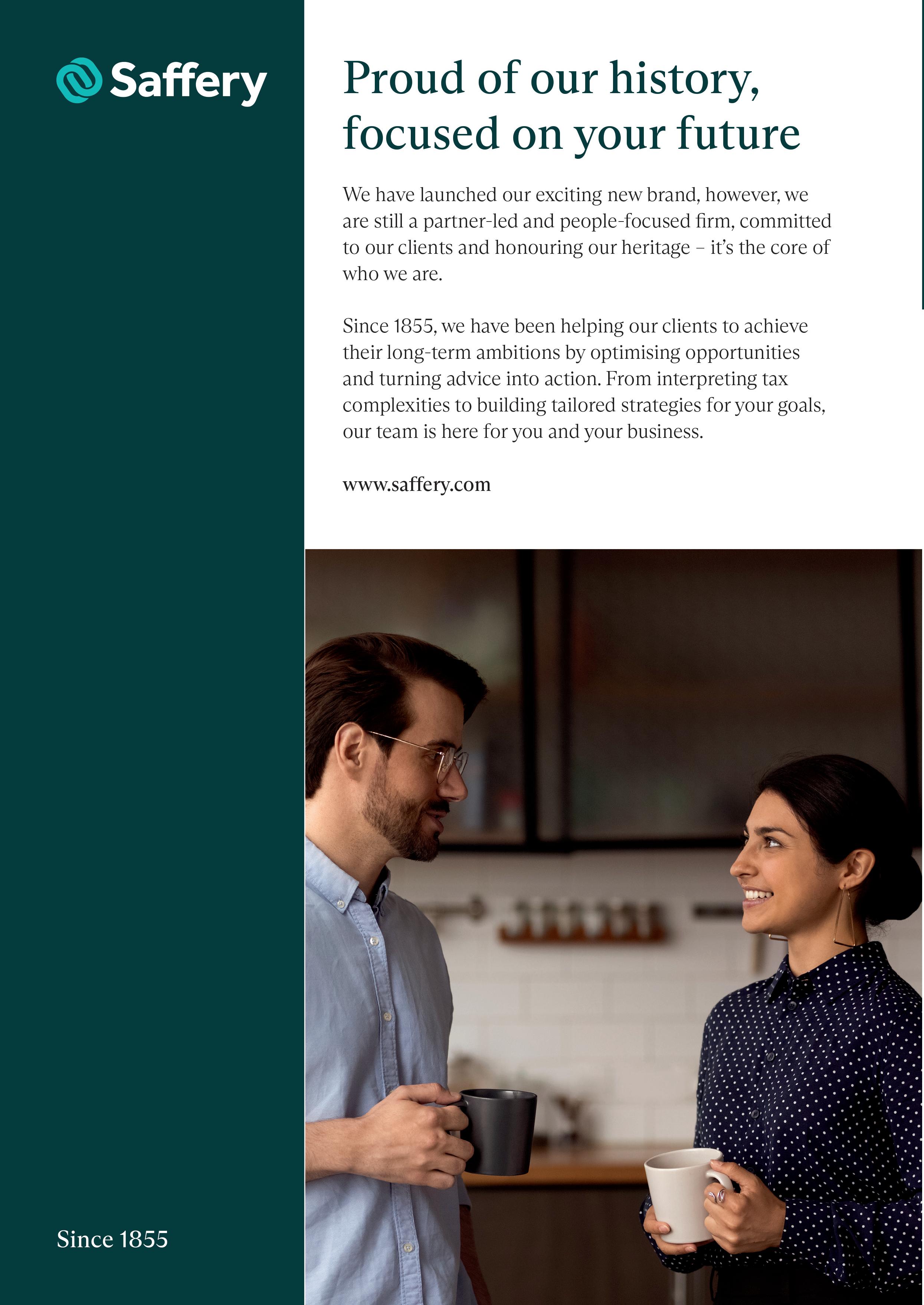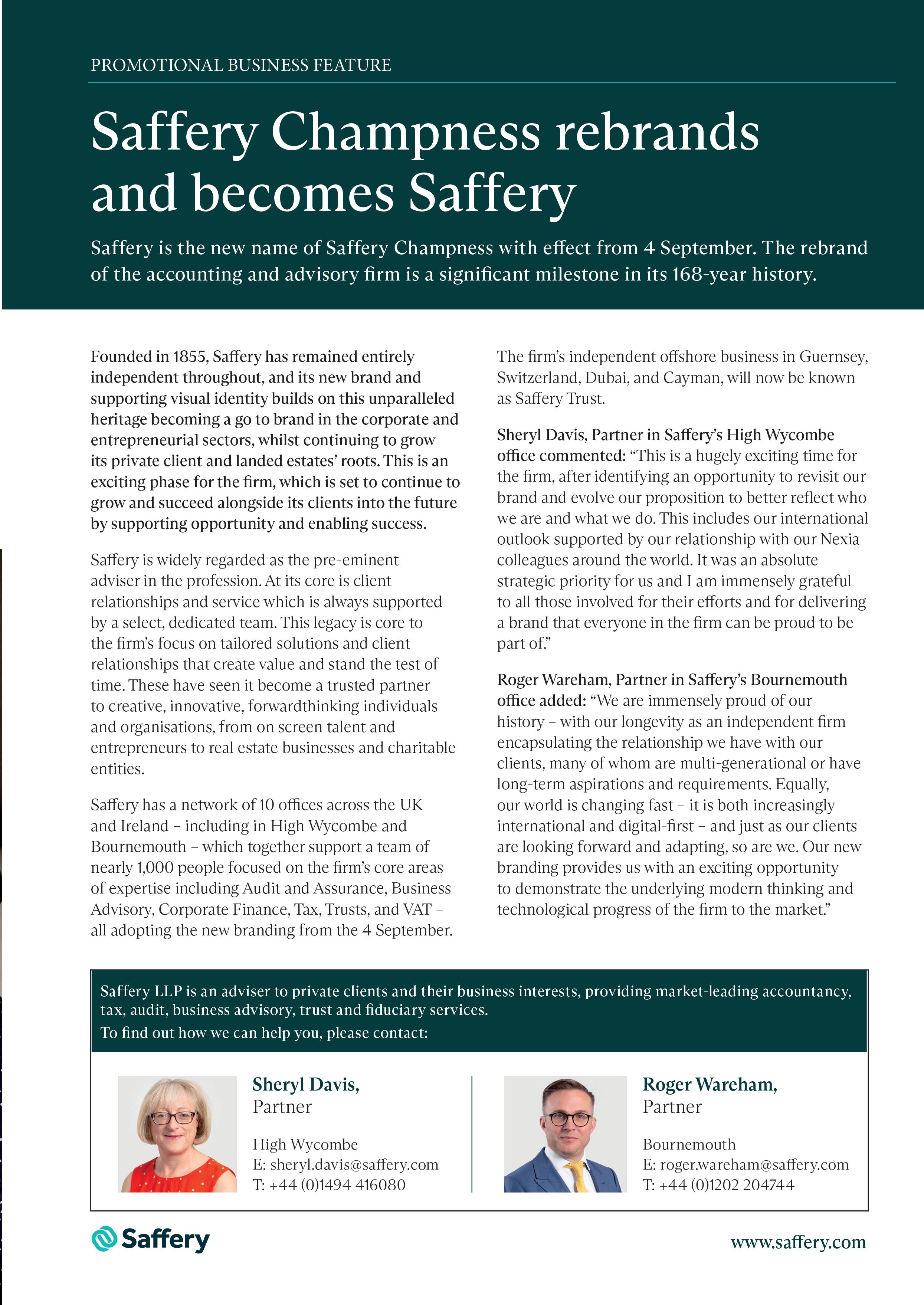MANUFACTURING



CONSTRUCTING THE FUTURE
NEED TO KNOW: THE I o T 10 COOL BUILDINGS
AMBITIOUS LEADERS
Deals
Information & Technology
Skills
Awards Coverage
Career Ahead

The power of a strong economy to lift the general wealth of a population should not be underestimated.
That’s the message from the Leader of Hampshire County Council, Councillor Rob Humby, in an interview in this magazine. In it he discusses why the authority is partnering with The Business Magazine to launch the Hampshire Business Awards.

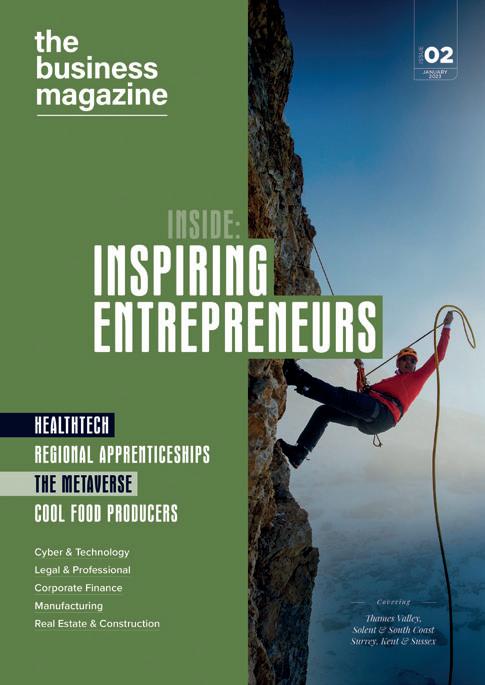
We have always been a publication that seeks to champion as well as report on the business community across the South East and that’s why we are delighted to launch these new awards which will take place in November.
September’s magazine also features an interview with Alex Tatham who has returned to IT distribution giant Westcoast.

Alex explains the reasons for his return and gives an insight into the culture of a company that turns over £3.6bn a year.
We also spoke to Jean-Pierre Choulet of the Reading Real Estate Foundation about its success over the past 20 years in bringing the property industry together with academia at Henley Business School.
The Foundation conducts research in partnership with the property industry, helps to diversify the backgrounds of
those entering it and also provides support to students studying in the Department of Real Estate & Planning at the University of Reading through mentorship and financial support.
There are some pretty hefty civil engineering projects currently under construction across the region. In this edition we take a look at some of them, and the companies involved.
Too many people say that this country doesn’t make stuff any more – or build it like the Victorians.
This issue proves that wrong. Both our main features, on manufacturing and infrastructure, not to mention our 10 Cool Buildings spread, reveals just a small proportion of what’s actually happening across the region.
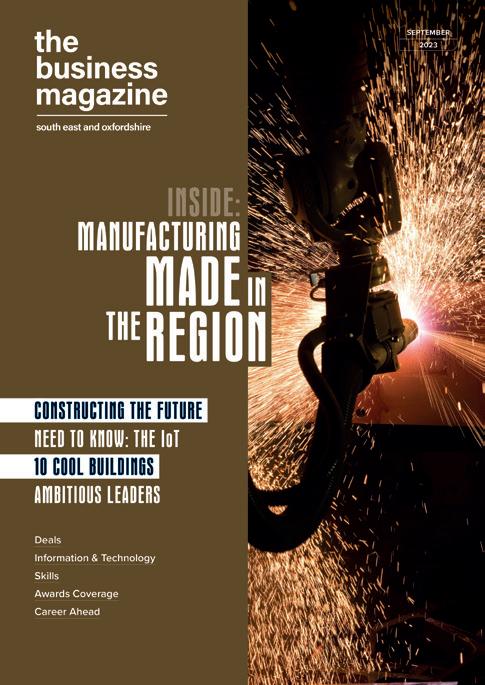
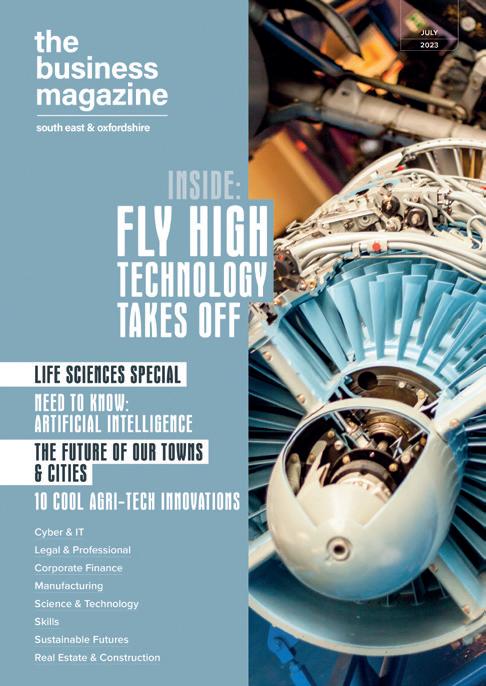
 Stephen Emerson Managing Editor stephen.emerson@black-ox.com
Stephen Emerson Managing Editor stephen.emerson@black-ox.com
Too many people say that this country doesn’t make stuff any more – or build it like the Victorians


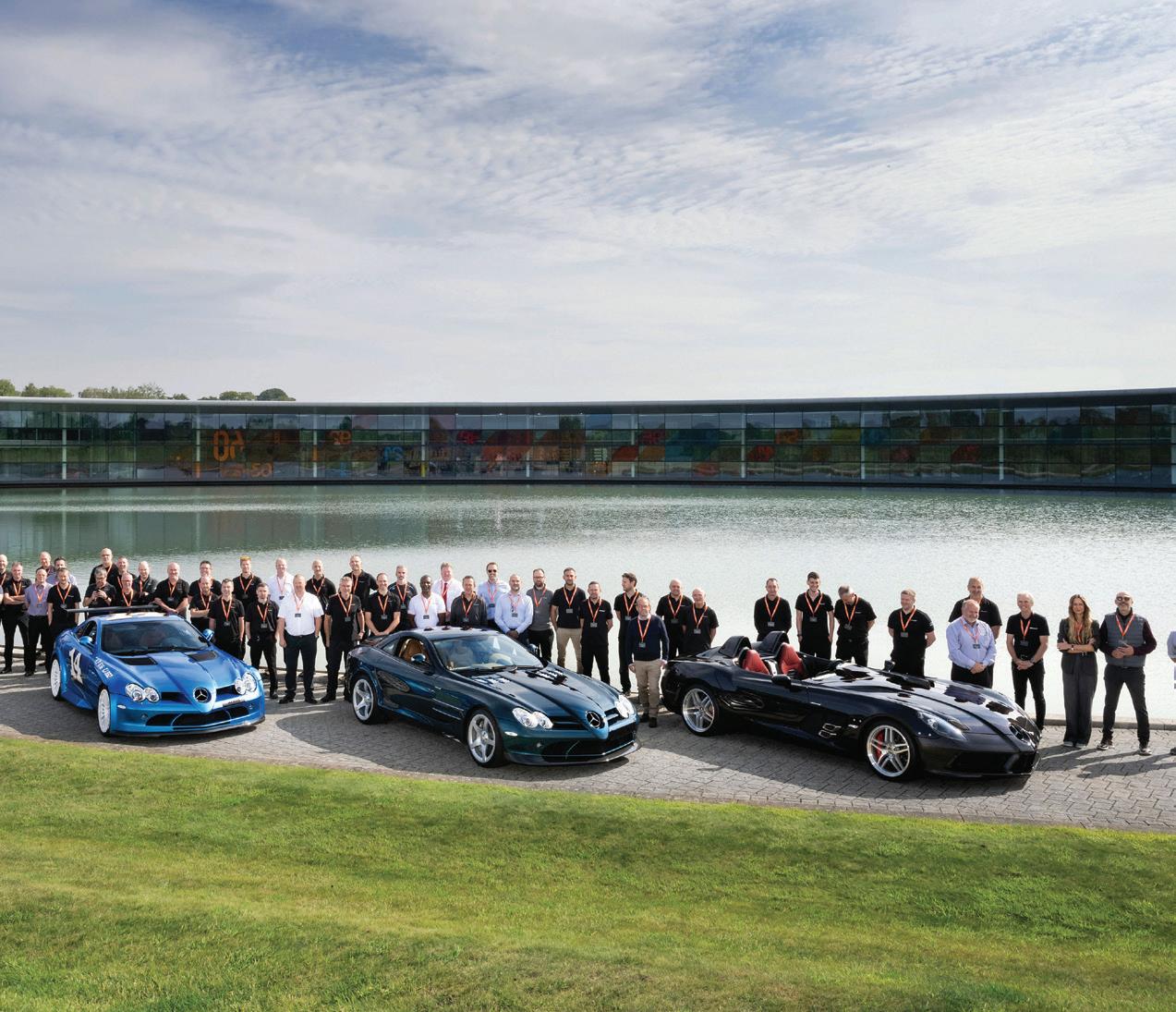
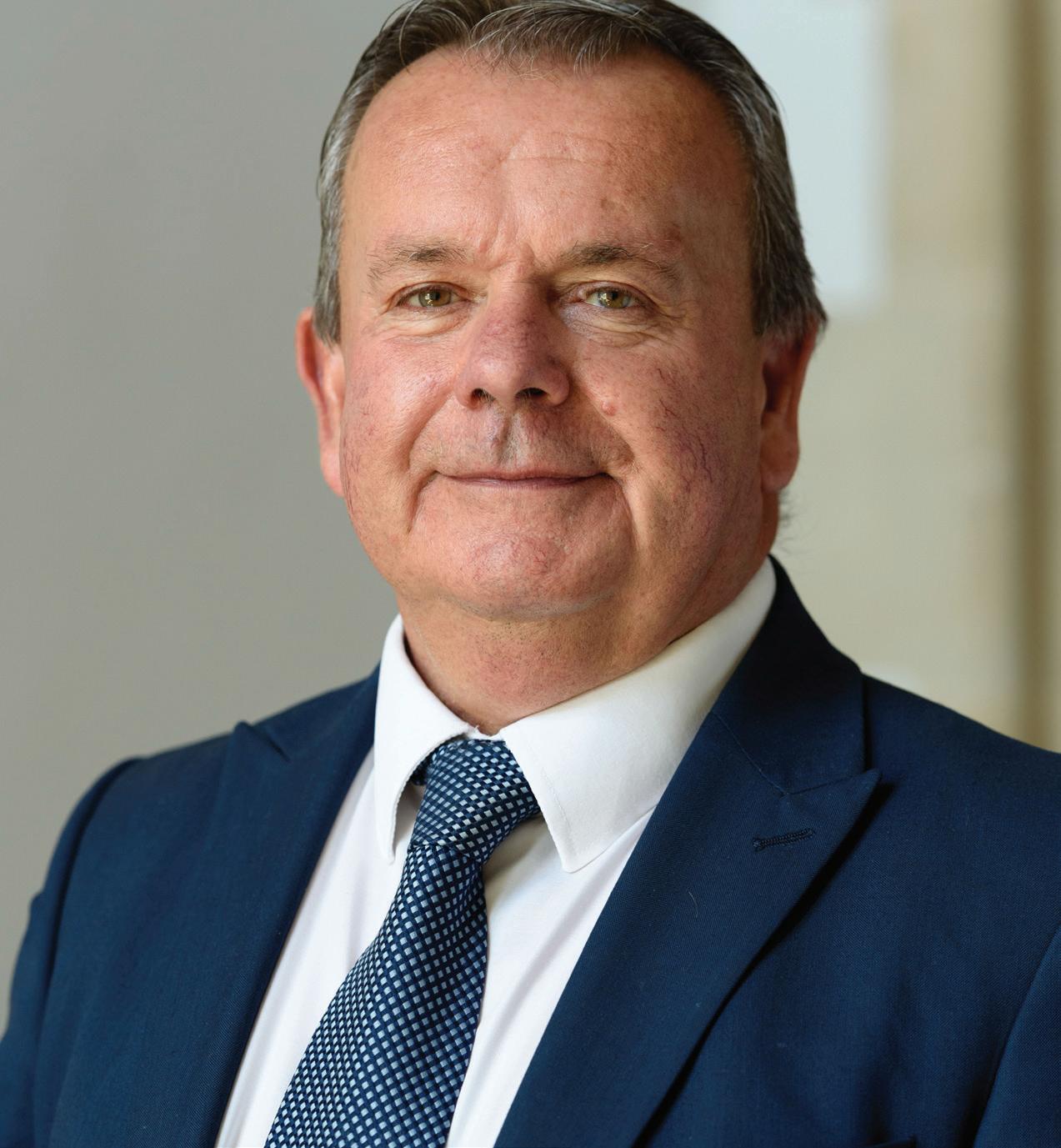



Thatcham-based Xtrac has been bought by private equity firm MiddleGround Capital.
Founded in 1984, Xtrac is the leading global supplier of professional motorsport and specialised automotive transmission systems across internal combustion engine, hybrid and electric vehicles. It manufactures as well as undertaking design and engineering.
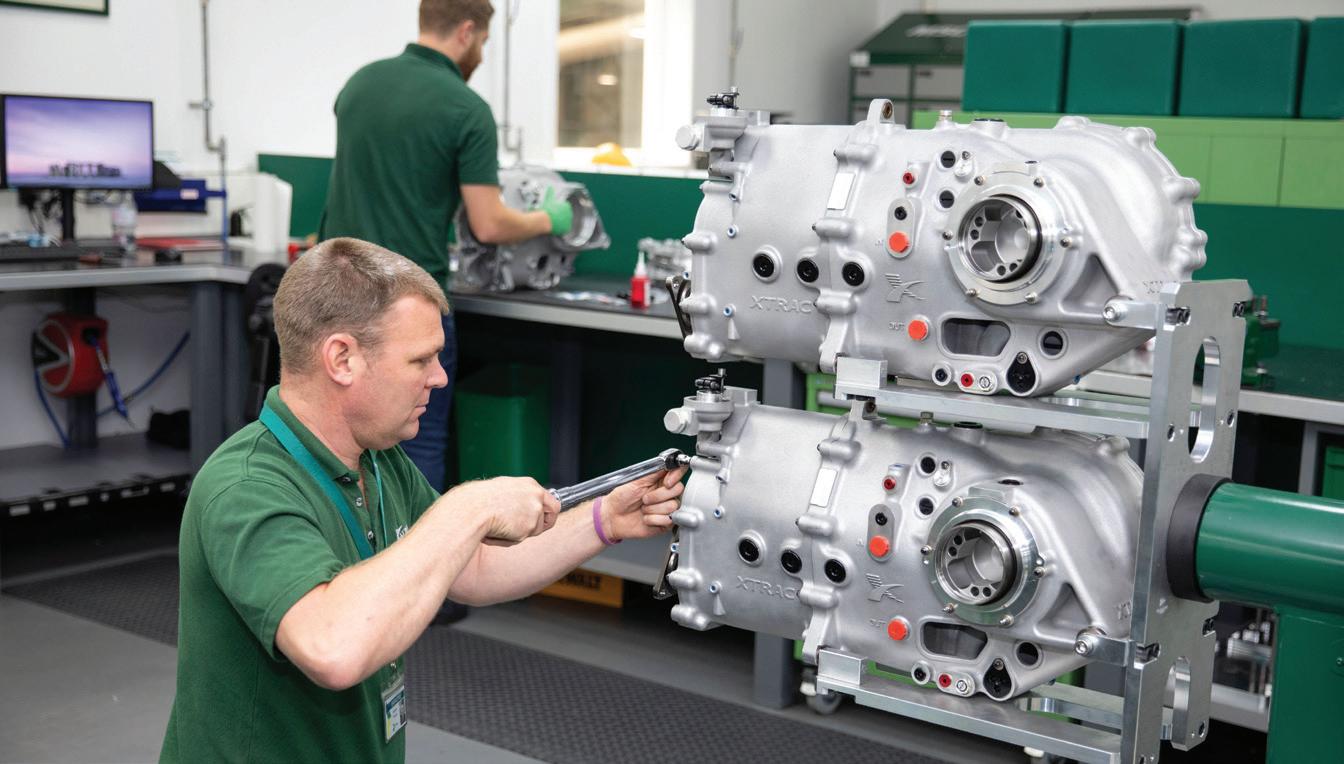
John Stewart, MiddleGround founding partner, said: “Xtrac represents an opportunity to partner with the leading provider of high-performance transmission systems for the specialised motorsport and automotive markets.
“We believe that under Adrian Moore’s leadership, Xtrac is well-positioned for
long-term growth and leading the future transition of the motorsport and highperformance automotive industry to hybrid and EV drivetrains by delivering innovative products in a sustainable manner.”
The company employs more than 400 staff and exports around 70 per cent of its manufacturing output to Asia, Australia, Europe, South America and the US.
Xtrac is also a long-standing supplier to many of the world’s top professional race teams including teams in Formula One, Formula E, Sportscar and touring car racing globally, world rallying and off-road racing, IndyCar and NASCAR.
Xtrac also has facilities in Indianapolis and Mooresville in the USA from where it
Midhurst-based Cowdray Park Polo Club has announced a seven-figure investment plan over the next five years.
Having just completed the busiest polo season in its more than 100-year history, the West Sussex Club is to make its greatest investment to date in its grounds and equipment. Investment in significant resurfacing work is already well under way at the world-famous Lawns One ground.

The single biggest investment for 2023 will be at the Lawns grounds, where a new members hospitality area and grandstand seating will be built.
provides support to key USA customers. Xtrac CEO, Adrian Moore, said: “Since our establishment, our unwavering commitment to R&D, manufacturing technology, and developing the skills of our people with our award-winning apprentice programme has resulted in the development of innovative, industryleading products that are of critical importance to our customers.
“By partnering with MiddleGround, we look forward to building on our success and benefiting from their expertise and guidance through this next stage of expansion.”
MiddleGround Capital is a private equity firm based in Lexington, Kentucky with more than $3.3 billion of assets under management.
It launched its Amsterdam office as a base for its European strategy in January.
Alex van der Have, Managing Director for investments at MiddleGround, said: “We see much potential for growth driven, in particular, by burgeoning consumer demand for high-performance transmissions for hypercars and motorsport. With this investment to support growth, customers will certainly benefit from Xtrac’s enhanced capacity and capability.”
Lincoln International provided corporate and capital advisory services to MiddleGround for the acquisition. Clifford Chance LLP served as legal advisor to MiddleGround.
Henry Bass joined the club as General Manager at the start of the 2022 season having spent 10 years running Goodwood’s headline motorsport events.
He said: “I am delighted that the club has committed to continued and significant investment in improving facilities for players and spectators.”
Wightlink has teamed up with HM Coastguard to carry out training to improve safety at sea.
Officers based at the Coastguard’s joint response co-ordination centre (JRCC) in Fareham have crossed the Solent on board two Wightlink ferries.
Wightlink transports passengers from the Isle of Wight to the company’s ports in Portsmouth and Lymington.
On board they discussed the company’s operations with its captains and bridge officers.
Wightlink’s Head of Fleet operations
Captain Sam Mitchell said: “Our Bridge teams have unrivalled knowledge of Solent waters and value our close links with the Coastguard.
“We were pleased to welcome them onboard and hope to carry out more joint exercises in the near future.”
Coastguard commander George Close added: “These training visits give us valuable insights into commercial ferry operations.

“Should there be an incident in the Solent we will work together so it’s important to know each other’s systems and procedures. This builds upon the regular Search and Rescue exercises we carry out with Wightlink and other ferry operators in the region.”
Visits by Wightlink crews to the JRCC to learn more about the activities of the Coastguard are also planned.
Wightlink’s six vehicle ferries and two FastCat foot passenger catamarans link the Isle of Wight with the company’s ports in Portsmouth and Lymington.
The company says it brings 3.8 million people together every year on more than 140 sailings a day.
Climbers in Oxford can how aim higher after the bouldering wall at the climbing centre at Oxford Brookes doubled in size as part of a refurbishment to meet increased demand.

Bouldering is a free form of the sport which does not involve ropes or harnesses.
The centre now boasts new bouldering walls built in a former squash court within the Brookes Sport facilities on the university’s Headington campus. There are still squash courts at both the
Brookes Sport centres in Headington and Harcourt Hill.
Climbing centre manager Richard Cole said: “As climbing has gained popularity we have had to expand.
“We’d already taken over a squash court to expand in 2009. In 2017, I had made a plan for further expansion. This was gathering pace until 2020 when Covid-19 hit and the work was delayed.
“The bouldering wall was 14-years-old and
The Mercedes-Benz SLR McLaren has celebrated its 20th anniversary. Four examples of the grand tourer designed and engineered to supercar standards were showcased at McLaren’s Woking Technology Centre.
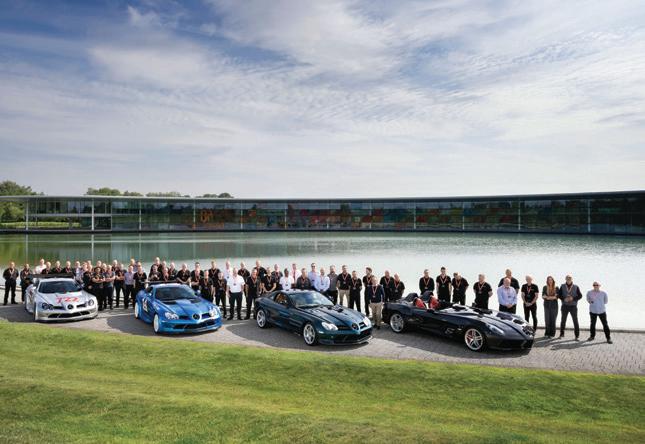
A visit from a group of SLR enthusiasts allowed members to meet some of the McLaren team who worked on the project.
Initially announced as ‘Project 7’ at Silverstone in 1999, the famous superGT car was produced by the Mercedes/ Mclaren team up until 2009 when the collaboration ended. McLaren has since built upon the foundations of ‘Project 7’ with the McLaren Special Operations.
McLaren and Mercedes-Benz were partners in Formula 1 between 1995 to 2009, during which McLaren won four Formula 1 World Championships.
needed refurbishing so we’ve taken over another squash court to create a much bigger facility.”
With between 5,000 and 6,000 visits a month, the centre, which now spans 750 square metres, is used by Oxford Brookes University’s climbing club and the University of Oxford’s mountaineering club.
Brighton Pier Group, the entertainment group, which owns and trades Brighton Palace Pier among other venues, said it was looking ahead with “caution” after seeing lower than expected sales in its first half.
Kent’s first new railway station in eight years, Thanet Parkway, opened to commuters this summer bringing the capital closer to the coast and opening up Thanet to new jobs and new business.

The opening of Thanet Parkway will improve rail connectivity between East Kent, London and the wider south east region by providing access to regular high speed train services to St Pancras and additional peak services to Charing Cross and Cannon Street.
The first train to arrive at Thanet Parkway station was the 4:58 am which left on time
and was due to arrive into London’s St Pancras at 6:25 am.
Located between Ramsgate and Minster, Thanet Parkway will boost the local and wider Kent economy by supporting connections to new housing and new business and job opportunities, particularly at surrounding business parks in Thanet and Dover, as well as supporting the area’s leisure and tourism industry.
As well as rail connections for London and across Kent, Thanet Parkway provides the potential for an integrated transport hub in the future.
The University of Surrey is to begin developing a new type of electric space propulsion system thanks to £250,000 of government funding.
The project will be undertaken in collaboration with the University of Leicester.
This new propulsion system, the PLAsma TOrch Rocket (PLATOR), aims to offer a balance between the high thrust typical
“The group is navigating a challenging trading environment, with persistent high inflation and reduced footfall continuing to affect disposable incomes across many of the Group’s trading sites,” said CEO Anne Ackord in a statement.
Brighton Palace Pier hosts two big arcades and 18 funfair rides, together with a variety of on-site hospitality and catering facilities. The pier aims to create a familyfriendly atmosphere that aims to draw a wide demographic of visitors. The pier is free to enter, with revenue generated from the pay-as-you-go purchase of products from the fairground rides, arcades, hospitality facilities and retail catering kiosks. According to Visit Britain, it was the most popular free attraction in the UK in 2021, with more than 4.2 million visitors.
of chemical propulsion engines and the propellant efficiency of electrical propulsion ones.
Senior lecturer in Electric Propulsion at the University of Surrey’s Space Centre, Dr Andrea Lucca Fabris, said: “Our PLATOR rocket could be used as the main way to move spacecraft after launch, or it could be used in space transportation vehicles, or space tugs, for delivering satellites to specific orbital slots, refuelling satellites to prolong their service life and removing space debris.”

It’s been the toughest five years for manufacturers. Brexit, the pandemic and the Ukraine war have each impacted variously on labour shortages, supply chain issues and soaring utility prices, to name the biggest issues.
But, whisper it quietly, could UK manufacturing have turned a corner?
According to manufacturers’ organisation Make UK’s latest Manufacturing Outlook, manufacturers say they are experiencing their calmest operating conditions since 2020. It’s by no means plain sailing, but the daily firefighting for some is not as desperate as it has been.

Seamus Nevin, Make UK’s Chief Economist, said: “Despite inflationary headwinds, the short-term future does offer a glimmer of consistency. The UK’s manufacturing sector has shown remarkable stability in recent quarters. Our industry has demonstrated time and again its ability to adapt, innovate and find ways to navigate difficult economic conditions. The resilience that defines us remains unwavering, propelling us to innovate further and secure a prosperous future for both the industry and the jobs it provides.”
But serious issues remain. The UK’s manufacturing industry needs proper support from government. Over the last 10 years there have been six industrial strategies. The latest one was shelved last year, but arguably none of them were proper strategies – more like thought pieces that belonged to the government’s various Departments of Business and weren’t really acted upon.
Make UK is becoming increasingly vocal in its calls to move the industrial strategy conversation up to Cabinet Office level.
By NickyJames Brougham, Senior Economist at Make UK, said: “We are the only OECD country without a formalised industrial strategy. The Chancellor, Jeremy Hunt, says we do have one – it is the sum of the business policies in place. But we think that’s unsatisfactory. Make UK is calling for an industry strategy and for it to be the responsibility of the Cabinet Office.”
The manufacturing industry has had a tough ride recently, but things might just be improving
Godding, Editor
The UK manufacturing sector is an essential contributor to the country’s economy generating £206 billion gross valued added last year – a fifth higher than a decade ago.
It accounts for around half of UK exports, two-thirds of spending on research and development and a significant level of business investment.
The sector also employs around 2.6 million highly-skilled people across the UK, many of them in areas that need levelling up. In short manufacturing matters to the prosperity and security of the UK.
But there are other headwinds too, not least the USA government’s announcement last year of its Inflation Reduction Act.
This is a landmark US federal law aiming to curb inflation and a big part of the Act is the intention to invest billions of dollars into domestic energy production.
This has already resulted in drawing green investment to the States from the UK and EU. Could this mean that UK manufacturers could up sticks and move to the USA?
While it’s not impossible, particularly for multi-national companies, to decide to build a new facility in the USA rather
than the UK, it’s less likely for small companies because it’s not only hugely expensive to relocate, but the USA’s regulatory frameworks make it complex for smaller businesses – and labour shortages are as serious in the land of the free as the UK.
James says that Make UK is seeing a major uptick in investment in automating and digitisation.
“The main sticking point for manufacturers post-Brexit was labour, and that’s still the case. Transient labour helped plug the gaps but now that’s more difficult, along with the postCovid world of working where people want to work from home, or simply work less. The solution is a five to 20-year investment in domestic skills, which we are supporting.”
But that won’t solve today and tomorrow’s challenges.
“Automation and digitisation are no longer a nice-to-have for forwardthinking manufacturers, it’s a need-tohave for almost all,” added James.
And while the cost of borrowing is continuing to rise, which will cut the amount of capital expenditure some companies are willing to invest, others are bravely going ahead and committing to such investment.
Manufacturing margins are improving, and the sector is regaining margins it lost over the past few years. Exports are also improving. Make UK’s report
revealed in June that for the first time since 2020, they have met or exceeded UK orders.
Although it may be too soon to tell, Make UK’s Manufacturing Outlook was confident enough to say that the unexpected bounce back which occurred at the start of the year may not be just a blip in the data.
Manufacturers are finally reporting strong balances across all measures of orders and while the growth is not astronomical it is modest enough that can mean business as usual may be returning.
Confidence is up among manufacturers across the South East.
The South East and London accounts for more than 38 per cent of the nation’s output and the region’s productivity is the best in the UK.
Half of all exported goods manufactured in the region go to the European Union. Around 18 per cent go to Australia and the Far East and the remainder to North America.
Orders in the South East have exceeded the average, but employment growth has underperformed the average.
Source: Make UK’s Q2 Manufacturing Outlook
We are the only OECD country without a formalised industrial strategy. The Chancellor, Jeremy Hunt, says we do have one – it is the sum of the business policies in place. But we think that’s unsatisfactory
Compiling a list of the region’s top 50 manufacturers is fraught with challenges. Some manufacturers have more than one business listed the same location. If this is the case, we have generally taken the figures from the one with the largest turnover. Others are UK subsidiaries of overseas businesses where we only have access to their global turnover or employee numbers.
In a few cases, large manufacturing companies have been left out because we can’t verify their turnover as they are overseas, often private, companies.
We have also been selective in the types of manufacturing listed. For the purposes of this list we have omitted food and drink, pharmaceuticals and beauty product manufacturers (but we haven’t overlooked
them completely, see our story on Poolebased Lush Cosmetics on the next page).
What the list reflects is manufacturing’s strength across the region, supporting a huge supply chain, employing tens of thousands of people, training thousands of apprentices and contributing substantial GDP to the region, and the country as a whole.
Founded in 1995, Lush is an amazingly successful cosmetic brand turning over in excess of £650 million, selling from more than 880 of its own shops in 50 countries around the world and employing more than 11,000 people.
And if you add in its various extra joint ventures, associates, licensees and franchises, brand turnover was more than £836 million last year.
From its Poole-based headquarters, Lush manufactures and sells fresh handmade cosmetics and it’s well-known for two things in particular – the gorgeous, pungent waft which flows out of its high street stores (and the long lines of customers, particularly at Christmas time), and its unwavering ethical stance.

Lush was founded by its current CEO, Mark Constantine and five friends in 1995. It emerged from a previous business, Cosmetics to Go, which sold via mail order.
That business collapsed a few years earlier, but the team learned from their experience, putting it to to good use when they set up Lush a few years later.
The company is firmly against animal testing, and the company won’t buy any ingredient from any supplier that tests any of its materials on animals for any purpose.
Mark is also against excess packaging –the majority of Lush products are solid and can be sold without packaging.
While Lush’s UK manufacturing facility is based in Poole, which is where more than 660 people work, it has a further five such facilities around the world in Canada, Japan, Croatia, Germany and Australia, plus smaller “fresh” kitchens in an additional fourteen locations globally.
While trading this year has been challenging, thanks to inflationary factors, increased raw material costs and lower customer confidence thanks to welldocumented world events, people are increasingly liking what Lush and other ethical manufacturers and retailers stand for, and it continues to target sustainable growth.
In 2021 the company made the brave decision to come off social media platforms that refused to acknowledge or
adjust for the dangerous impact of their algorithms on teenage mental health.
The company admits that it doesn’t know the financial impact that decision might have had on the company, but its determination to do the right thing remains.
Look on social media platforms such as Instagram and you’ll find a lot of photographs of lovely Lush cosmetics, but none posted by the company itself.
It says it believes in a modern form of capitalism, which can co-exist with profitability. It wants to be a living wage payer globally (and currently pays real living wages in the UK and Ireland, and in New Zealand where organisations exist to identify what pay levels should be, and pays above average wages elsewhere in the world). It also wants to become carbon positive, zero waste, pay its suppliers fairly and protect and help regenerate the planet.
These are tough targets, which Lush is determined to stick to, and by doing so, it’s set an example for other cosmetic companies around the world. Lush has thrown down the gauntlet.
The Chilli Mash Company began crowdfunding this summer to raise £100,000 to build a sustainable farming process in Rwanda.
The family-run business based in Portsmouth works with chilli farmers in Rwanda from where it exports the chillis to its UK South Coast headquarters and manufacturing premises.
Formed in 2016, The Chilli Mash Company was born from a partnership between two existing chilli sauce companies.
The company aspires to be the UK’s largest independent producer of fresh chilli, chilli mashes, purees, condiments
and dry spices and has already won a raft of awards.
It wants to support Rwandan farmers by building a factory on its existing chilli farmland, based in Bugesera in the eastern province of the country.
This will help streamline the farming process, improve the quality and consistency of produce and enable the preparation and export of more chillies, all supporting local Rwandan workers and their families.
Alongside its own range of 255 products, it also white-label manufactures for other chilli sauce producers, condiment businesses and restaurants around the UK.

Ventilation systems manufacturer Zehnder Group revealed its new factory in Maidstone this summer as the company committed to remaining and investing in the Maidstone area.
Faversham and Mid Kent MP, Minister of State for the Department of Health and Social Care, Helen Whately and The Worshipful the Deputy Mayor of Maidstone, Martin Cox, attended the opening of the manufacturing plant, which will bring new work opportunities to the local area.
Most of the staff live within 12 miles of the site, including the factory’s operations manager, and every employee has access to a local free electric bus service to help them get to work. The launch will also open up job opportunities for local residents,
with a focus on skilled and experienced professionals in the manufacturing and engineering fields.
Chairman of the Board of Directors for the 120-year-old Zehnder Group, Dr Hans-Peter Zehnder and Zehnder UK Managing Director, Tony Twohig, welcomed guests for an exclusive tour.
The new factory site has been designed to meet the highest standards of quality and sustainability and will incorporate the latest energy-efficient technologies to minimise its environmental impact.
New machinery, such as plastic moulding machines, cooling systems and a fully electric vehicle fleet, including forklift trucks, also work to the latest energy efficiency ratings –lowering Zehnder’s carbon footprint.
Helen Whately MP, said: “It’s great to have Zehnder in Maidstone and continuing to invest in our local economy. Its new factory is impressive, combining innovative technology with sustainability.
“Investments like this are just what our area needs. They bring good jobs and opportunities, and mark Kent out as a place to do business. I wish Zehnder every success for the future.”
The modern manufacturing facility represents a significant investment for the company.
Factory operations manager Conrad Thrower said: “This new facility will offer us increased production capacity and more efficient technology to expand our product lines and services.”
WHAT
Artificial Intelligence (AI) is emerging as a transformative technology across various industries, especially in finance, tech, healthcare, retail, and manufacturing. Other industries, such as construction and agriculture have been more cautious in embracing AI, where the potential benefits may be less obvious, writes Jason

 Mitchell, Partner, MHA.
Mitchell, Partner, MHA.
What are the opportunities?
Enhanced efficiency and productivity: For manufacturing businesses, one of the primary advantages of AI is its ability to enhance operational efficiency and productivity. Intelligent automation systems powered by AI algorithms can optimise production processes, streamline supply chain management, and minimize downtime. Predictive maintenance also enables proactive identification of equipment issues and potential failures, reducing unplanned downtime.
For construction firms, AI algorithms can analyse historical project data to provide insights for better project planning and design. By identifying patterns and correlations, firms can optimise project schedules, estimate costs more accurately, and develop designs that align with realworld constraints.
Energy efficiency and sustainability: AI can optimise building management systems for energy efficiency. By analysing
real-time data from sensors, AI can adjust HVAC and lighting systems to reduce energy consumption while maintaining comfort levels.
Site monitoring, safety and progress tracking:
AI-powered sensors, cameras and connected devices can monitor factories and worksites in real-time, detecting unsafe conditions and potential hazards, as well as providing insights into various aspects of operations, including the supply chain, inventory optimisation, and demand forecasting. Drones and IoT devices can also provide real-time updates on construction activities to track the progress of multiple projects.
Supply chain management: AI can help predict material demand, optimise inventory levels, and even suggest alternative suppliers in case of shortages, streamlining the procurement process.
Enhancement:
AI can integrate with BIM, a workflow
process, based around models used for the planning, design, construction, and management of building and infrastructure projects, to process vast amounts of data in order to generate insights, enabling firms to identify potential clashes, optimise building layouts, and simulate different scenarios for better decision-making.
Robotics and autonomous systems: Robots with AI capabilities can operate collaboratively with a human workforce to perform complex tasks with precision, speed, and consistency, as well as mundane, repetitive tasks to reduce manual labour requirements and increase production efficiency. This can potentially free up human resources for higher-level problem-solving and innovation. Humanmachine collaboration is becoming increasingly prevalent in manufacturing settings, with staff interfacing with AI systems through voice commands, or wearable devices. This collaboration allows employees to access real-time information and receive AI-generated recommendations.
Data privacy, security and ethical considerations:
AI relies heavily on data collection, analysis, and storage to function effectively. However, collecting, storing and processing vast amounts of data creates concerns regarding the security and privacy of sensitive data. Breaches or unauthorised access to this data can result in intellectual property theft, compromised trade secrets, or regulatory non-compliance.
There are also a number of ethical concerns related to transparency, fairness, accountability, and the potential for AI to reinforce existing bias or discrimination. For example, the monitoring of staff with drones or other devices may invade their privacy and could lead to a hostile working environment where staff feel under constant surveillance.
Data collection, storage and legal basis: AI drones gather a significant amount of data, including visual footage and potentially biometric information. Employers must have clear policies in place regarding data collection, storage, and retention and obtain informed consent

from employees before implementing surveillance measures. This includes ensuring that sensitive data is protected and not used for purposes beyond what was initially communicated.
Workforce displacement: AI has the potential to replace a number of manual or repetitive tasks, which could lead to job displacement for some workers, decreased job satisfaction, and the need for upskilling or retraining of the workforce.
Technical Challenges: Implementing AI systems can be complex and require significant technical expertise to ensure reliability, accuracy and safety.
Cost of Implementation: Adopting AI technologies often involves significant upfront costs, including infrastructure upgrades, training, and ongoing maintenance.
Lack of human judgment: While AI systems excel at data analysis and automation, they still lack the ability to incorporate human judgment and intuition. Certain complex decisionmaking processes will still require human intervention, particularly in situations that involve unforeseen circumstances or nonroutine events.
To mitigate these risks, it is important to develop robust AI strategies that include comprehensive data security measures, ethical guidelines, employee training programs, and contingency plans to address potential disruptions.
AI can assist auditors, business owners and finance directors to gain valuable insights from their financial data in realtime and help prepare for audit; namely in areas of data analysis, identifying inconsistencies, errors, or anomalies to help ensure data is accurate and reliable. AI algorithms can also assess financial data for potential risks, compliance issues, and detect patterns indicative of fraudulent activities; and by using historical financial data, AI can provide predictive insights, such as forecasting future revenue, expenses, and cashflow.
We are increasingly incorporating techniques such as data analytics, artificial intelligence and machine learning into our audits through our global partnerships with software vendors, which revolutionises the efficiency, quality and value to clients of audit work for the industrial sectors.
The future of AI holds immense promise for the industrial sector. By leveraging intelligent automation, robotics, and data analytics, businesses can achieve unprecedented levels of efficiency, productivity, and innovation. As AI continues to evolve, its impact is likely to become more profound, unlocking new opportunities and driving transformative change.
Our business advisors have experience across multiple industries and sectors of how firms are implementing and benefiting from AI and the various challenges and opportunities available.
Reading-based Altitude Angel has begun deploying its planned surveillance network to detect aircraft and drones flying at lower altitudes in the UK.

The sensor network has been extensively tested across four sites, and is now being rolled out to a further 30 across the Midlands and South East.
Altitude Angel is leading a consortium to develop, using its ARROW technology, 165 miles of drone superhighways connecting
airspace above Reading, Oxford, Milton Keynes, Cambridge, Coventry and Rugby.
Data received by this latest sensor network will be ‘fused’ with Altitude Angel’s already extensive air-surveillance picture to create a high-resolution, near real-time digital map of low-altitude airspace.
“In building this network we’re building the most comprehensive, real-time picture of whatever is moving through the country’s low-altitude airspace,” said Richard Parker,
“Coupled with our ARROW technology, the sensor network is a key component in enablement of the digitisation of low-altitude airspace, leading toward greater visibility of air traffic, and enabling automated BVLOS (Beyond Visual Line of Sight) drone operations anywhere in the UK at scale, while providing operators of uncrewed aircraft the security they need to operate safely in unsegregated airspace,” he added.
A prime piece of Reading’s office real estate is to be converted into flats under a Build to Rent scheme.
Norman Place is to be transformed into more than 200 flats after being sold to Packaged Living and Bridges Fund Management for an undisclosed fee. The site was formerly the home of Covéa Insurance.
Vail Williams Agency Partner Guy Parkes, said: “This is a well-known property in a prime spot along the Thames path and one of the first sites to be seen when leaving the rail station.”
Property consultancy Vail Williams acted for Covéa whilst Hollis Hockley advised the purchasers.

Berkeley Homes celebrated a major milestone in the development of Horlicks Quarter in Slough with the official opening of Memorial Square and the residents’ facilities at the historic Horlicks Factory.
Slough’s Horlicks factory was built in 1908. In 1969 the Horlicks brand was bought by the Beecham Group, which in 2001 became GlaxoSmithKline.
The owners sold the Horlicks UK brand in 2017 and the factory closed the following year. The site is now being redeveloped for residential use.
Elkie Russell, Managing Director and Caroline McHardy, Land and Development Director at Berkeley Homes were joined by the Mayor of Sough, Cllr Amjad Abbasi and guests, Sir James Cunliffe William Horlick and Araminta Carson (nee Horlick), the grandchildren of Horlicks co-founder, Sir James Horlick, 1st Baronet.
Memorial Square is now home to Grief –the restored Grade II listed War Memorial commissioned by the Horlicks Company in 1949 and a poignant symbol of the staff who fought in the First and Second World Wars.
Residents’ facilities at the new development include a games room, gym, cinema and dining room.
A co-working space will open in the Clocktower next year complete with rooftop garden and plans are also under way for an on-site café and day nursery.
Caroline McHardy, Land and Development Director of Berkeley Homes, said: “Memorial Square stands as a defining landmark within Horlicks Quarter.

“We take immense pride in the remarkable transformation we have achieved with the Horlicks Factory building and the War Memorial, both meticulously restored to their former glory.”
Buckinghamshire-based enterprise asset management company Peacock Engineering has been acquired by BPD Zenith.
First established in 2009, Peacock Engineering works in the defence, energy, utility, manufacturing, life science and transport sectors.
It now boasts more than 8,000 clients and has more than one million assets under client management.
Its sale to BPD Zenith includes all assets
and intellectual property (IP). Founders Alan Cambridge and Roger Walker will remain in new group roles, as group head of strategy and group head of innovation.
Alan said: “Joining BPD Zenith will enable the Peacock Engineering team to deliver our solutions to a wider global audience, helping our existing and new customers to make better informed data-driven decisions.”
Peacock Engineering’s flagship products – IBM Maximo and Fingertip – help clients to deliver their asset management strategy
Law firm IBB has launched a new visual identity to support a divisional focus dedicated to specific client needs.

The company’s core divisions are IBB Commercial, IBB Franchising, IBB Real Estate, IBB Private Client, IBB Criminal Law and IBB Wealth.
The new visual identity aims to capture the essence of the firm’s long-term vision which is about making the law work for clients by listening to and understanding their needs.
With its 100-year history IBB has four offices in Uxbridge, Chesham, Reading and Ascot serving clients across the region and beyond.
through improving asset availability, reducing life cycle costs, while ensuring industries remain legally compliant. The company has offices in London, Bristol, Leatherhead, Leeds and Bangalore and works with some of the biggest names in industry including DHL, Siemens, SSE and Infinis Energy.
Oliver Garthwaite, CEO of BPD Zenith, said: “Peacock Engineering is a respected name in the asset management industry, and their expertise in software development and implementation, including Fingertip, will be a valuable addition to our team.”

A new innovation hub in Slough is being developed by property investment firm AshbyCapital and flexible workspace provider Plus X Innovation.

The new space, in The Future Works building, will sit across 23,644 sq ft, over the ground, first and second floor and will open later this year.
The Future Works building is part of AshbyCapital’s portfolio.
The workspace will offer high levels of natural light and will feature a workshop area housing more than £300,000 worth of specialist prototyping equipment, techenabled meeting rooms, membership co-working areas, breakout areas and sound-proof phone booths.
Paul Rostas, co-CEO at Plus X Innovation, said: “Our offer, combined with the town’s proximity to London through the Elizabeth line, its diverse talent pool
Content Guru, the Bracknell-headquartered tech company, is opening a new development hub in Porto, Portuga as it continues to expand in Europe.
The firm has a strong global and European presence and said the Porto hub will become its fifth permanent location in the region, with additional offices in Germany, the Netherlands, Ireland, Italy and Scotland.
The company, which is a Contact Centre as a Service (CCaaS) provider, already supports leading European brands including AXA, Interflora, UK Power Networks, KwikFit and the NHS.
with high-profile universities nearby, and its consistent appearance at the top of rankings of the best places in the UK to live and work will make this a compelling place for small businesses with big ambitions.”
Plus X Innovation has two open innovation hubs in Brighton and Hayes with plans to launch 25 more across the UK in the next five years.
Gridserve, which is rolling out electric forecourts and EV charging points across the UK, has signed a long-term, multimillion pound partnership with Fareham-based MicrosoftAzure expert Dootrix to provide back-end cloud engineering services.
Buckinghamshire’s Gridserve’s sun-to-wheel operations start with hybrid solar farms that promote biodiversity while generating power. They’re sited as close to possible to the company’s charging points and forecourts.
Dootrix’s digital technology will accompany Gridserve’s nationwide roll-out of charging points. First steps will focus on the driver interface before diversifying to offer a range of forecourt, vehicle and ancillary services.
When entrepreneurs plan for the future of their business, one of the most important steps to consider is creating an exit strategy. An effective exit plan is essential for any business to ensure a successful transition to new management.
An entrepreneur may wish to exit for many reasons, not just the obvious full-sale, realising millions ideally, if the business has succeeded. There may come a time when the entrepreneur wants to leave and try a new venture or just take a break.

Common exit strategies include selling the business (fully and partially), taking it public, merging with another company or liquidation. Your exit strategy can have a major impact on how your business is run, including its legal structure and revenue models. So, it’s important you have one in place as early as possible.
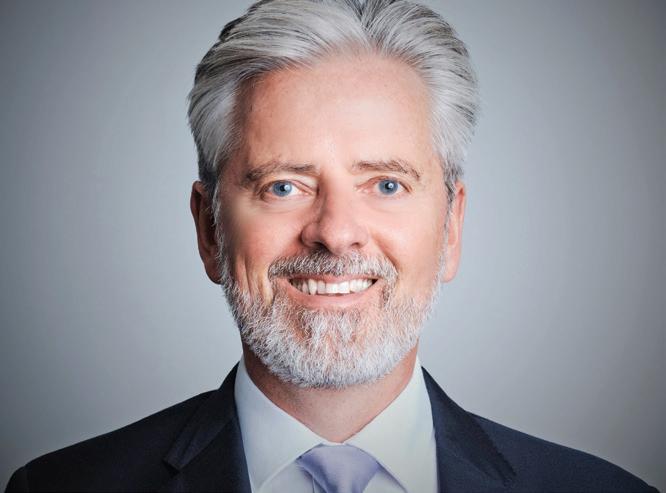
There are many issues for entrepreneurs to consider before selling a business, which is why it’s important to have the right team of advisers to guide you through the
process and remain by your side after the substantial liquidity event.
It’s important to think of an exit plan for a start-up even if there’s no intention to sell.
Paul Newman, Senior Private Banker at SG Kleinwort Hambros says: “Entrepreneurs should consider protecting some of the wealth they have grown along the way. Often entrepreneurs can be bang/bust/ bang. When businesses get to a size the entrepreneurs had envisaged, do they sell and realise their efforts or grow further and retain? Often, they will sell when businesses are still going, ahead of plateauing and perhaps future boredom. Then on to the next idea.”
Having an exit strategy in place will allow you to plan for your business future and prepare for any of life’s unexpected events, allowing you to do it on your own terms. You’ll also be ready for any business sale negotiation in advance.
A well-crafted exit strategy is a vital element for any business looking to grow and succeed. It serves as a roadmap that outlines specific goals and milestones, providing a clear path for the business to follow and measure progress against.
Regular evaluations of the exit strategy help to ensure that the business is on track and identify any areas that may require improvement.
An exit strategy is also a sign of fiscal foresight and responsibility that makes your business more attractive to potential buyers.
The decision to sell, or partially sell, is arguably the most intense thing an entrepreneur (founder or major shareholder) will work through. It represents realising success, yet also losing control of the thing that has demanded every bit of the entrepreneurs’ time, energy and resources. Creating and realising value is always on the mind of such people, and every business is unique, yet there are familiar themes to consider and handle.Paul Newman
1. WHAT TYPE OF EXIT DO YOU
The exit for a start-up can take various forms, depending on factors such as the business type, market and ownership structure.
Acquisition. This is when a company, private investor or private equity house, purchases enough of another firm’s shares to take control of it. An acquisition can be an attractive exit strategy for a start-up as it can provide a significant pay-out to shareholders. It also allows the acquired company to be part of a larger organisation, which can provide resources and support to grow the business.
Initial Public Offering (IPO). This is when a privately held company issues shares of stock to the public for the first time. It can be a significant event for a start-up, increasing its visibility and credibility.
Management buyout. This is a type of exit strategy where a company’s management team purchases the company from its owners. A buyout can be an attractive option for owners who want to ensure the company remains in the hands of a team they trust.
2. PLAN EARLY
As an entrepreneur, the sooner you plan your exit strategy, the more options and flexibility you will have when it comes to the time to sell. Waiting until you need to sell could result in unnecessary pressure that negatively affects the outcome of the sale.
3.
Entrepreneurs can make more informed decisions about their exit strategy if they know the value of their business. This includes gauging its market value, the potential for future growth and the cost of selling.
By understanding the value of the business, entrepreneurs can seek to maximise the return on their investment by securing the best possible selling price.
4.

Knowing the market can help you to determine the best timing for an exit, as well as the potential value of the company. It can also help you to identify potential acquirers or investors and give you an idea of what kind of exit may be most beneficial for the company.
Understanding the market can also help you to determine the best way to position the company for a successful exit, such as by focusing on growth or by streamlining operations.
Typically, owners don’t want to leave when the business is doing well, but this is often the best time to sell. A business that is profitable, with growth, good cashflow and potential is seen as a lower risk to potential buyers and more likely to command a higher price.
You also need to know where your company is in the business cycle. Too many companies try to sell when their business is on the way down, hoping they will take it to the next level. You should sell when you’re in the growth stage of the business cycle, not the decline.
Jeremy Hill, Senior Private Banker at SG Kleinwort Hambros, says: “With many years’ experience of working with entrepreneurs throughout their company’s lifecycles, SG Kleinwort Hambros is well placed to help you simplify these challenges. Most private banks and indeed luxury goods vendors, want to know entrepreneurs after they have sold their business. The best private banks will find ways to add value and really get to know the owners before the transaction. This often means understanding personal motivation and objectives of the entrepreneurs to help develop strategies and provide wealth planning including working on cashflow analysis, pension advice, shareholders’ structures, key person insurance, family investment companies and trusts. It is in the value of realisation phase that trusted advisor relationships are truly forged.”


Having supported this phase of the journey and following a liquidity event, it is crucial to reflect on your personal goals and circumstances, as well as the structure of your wealth, because entrepreneurs realising their first event just won’t know what it feels like until they have done it. Ideally knowing that you have a trusted advisor at your side with a flexible financial strategy in place, we suggest that there are three essential principles around a business exit:
Build a plan to that will aim to provide for you and your family for many years to come.
Having worked hard for your success over many years, it is important to reward yourself for your commitment.
Consider establishing your legacy by finding ways to pass on your wealth to your family or wider society through philanthropy.
To read more entrepreneur articles or to listen to The Enrepreneurs Chat podcasts, scan the QR code.


Porchester-based Griffon Hoverwork has been testing its new 12000TD hovercraft, Baien.
The new vehicle, which is one of three destined for Oita Prefecture in Japan as part of a £25 million contract, has been heading out across the Solent to the Isle of Wight.
Together, the three hovercraft will re-establish a vital passenger service between Oita Airport and Oita City, with all three craft scheduled for delivery next January.
Griffon’s Chief Pilot, Ben Avery, who has been among the team putting the new hovercraft through its paces, said: “The sea trials programme consists of various different tests, including float tests, steering tests, speed runs, and endurance runs.”
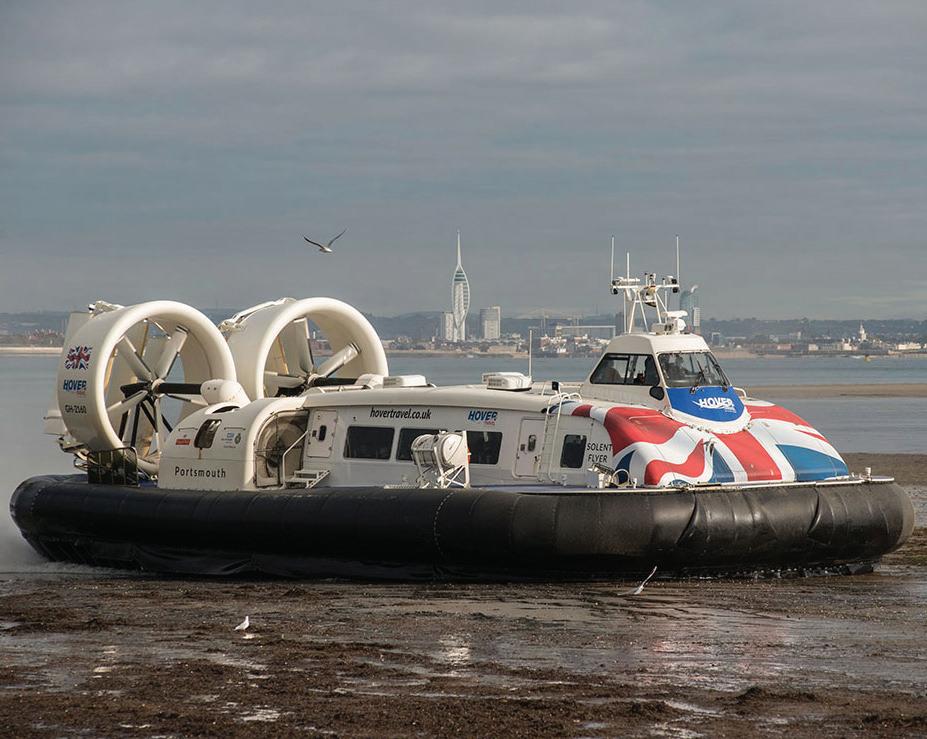
These trials are important because, while Griffon already provides a 12000TD for the Hovertravel service between Southsea in Portsmouth and Ryde on the Isle of Wight, they’ve had to make a few key adjustments for their Japanese customers.
Ben explained: “The craft is 25m long – two metres longer than the standard 12000TD. That extra two metres has been added to give more space inside the cabin, which allows for the Japanese barrier-free access requirements.
“It also gives two wheelchair spaces and seating for 80 passengers.
“Because we’ve made the craft a bit longer, we’ve had to look at ways of weight-saving.
“One of the ways we’ve done that is by taking weight out of the propeller ducts in the manufacturing process. The steering system is now also a lot more efficient.”
Commercial property development and investment company Landsec has announced multi-millionpound plans for its Gunwharf Quays development in Portsmouth.
The revamp to the shopping centre, which first opened in 2001, would bring new flooring, lighting, and decor to the shopping centre, as well as an array of rooftop solar panels just recently approved by the council.
Cllr Steve Pitt, leader of Portsmouth City Council, hailed Landsec’s £45 million investment as ‘a sign of confidence’ in the city.
He added: “Gunwharf is a flagship development, not only for Portsmouth residents but also attracting people from outside the city.
“It’s really great news that Landsec are willing to make this level of investment.”
Farnborough Airport is now home to a new community hub which promises to bring together people and information and help the airport forge deeper local connections.
The Nexus is kitted out with modern conferencing technology and will host a variety of community and educational events, with capacity for up to 50 people.
It also acts as a learning and development centre for staff at the Farnborough Airport Company.
The Nexus is set to host visits over the coming months from local schools and colleges, raising awareness of how STEAM subjects – science, technology, engineering, arts, and maths – can be applied to the world of aviation.
Simon Geere, CEO of Farnborough Airport, added: “It’s difficult to think of another location where the airport and its local area are so inextricably linked.
“It’s with this in mind that we are committed to further strengthening the bond between Farnborough Airport and the local community by making the airport more open and available for the benefit of the local area.”


South of England car dealership Hendy Group has been named a retail partner for the South Korean luxury car maker Genesis and a new studio to showcase the brand is expected to open in Poole, Dorset early next year.

Genesis is the luxury vehicle division of South Korean vehicle manufacturer Hyundai Motor Company and was launched in the UK just over two years ago.
“This is an exciting milestone for Genesis in the UK,” said Lawrence Hamilton, managing director for Genesis Motor Europe.
“Earlier this year, we announced we would be expanding the Genesis footprint and
we are delighted to now have Hendy on board.
“With Hendy now officially part of the Genesis family, it means we can deliver our unique Korean customer service directly to our new and existing customers from the Poole studio.”
The first seven of 20 new network
partners, including Hendy, were appointed at a signing ceremony held at the Scottish Open golf tournament.
Hendy Group chief executive, Paul Hendy, said the Genesis studio opening in Poole marked a “key milestone for the automotive group and further builds on the group’s expertise in the performance and luxury market”.
The electric power boat SpiritBARTech35EF, which was designed by Portsmouth’s BAR Technologies, has comfortably made a new record for such a vessel in the ‘Round the Island’ race.
The boat sped away to start off Cowes on the Isle of Wight at 11 am on July 18 and completed the race in one hour, 56 minutes, breaking the previous record of just under six hours.

Schofield said the vessel was the “embodiment” of the firm’s pioneering approach for the luxury yacht sector, which was overdue “more efficient designs that don’t compromise the needs of comfort and performance”.
The SpiritBARTech35EF is the product of Spirit Yachts’ partnership with BAR Technologies and the latter’s America’s Cup simulation and design expertise.
BAR has said that, where previously, the average electric yacht of around 40ft has possessed a range between 25 to 70 miles at around 5 knots, dependent on the battery, the SpiritBARTech35EF has a 100mile range at a cruising speed of 22 knots once it is “flying”.
Spirit Yachts collaborated with BAR Technologies to implement its foiling technology, which minimises contact between the hull and the water.
Electric power boat from Portsmouth’s BAR Technologies makes new ‘Round the Island’ record
The SpiritBARTech35EF”]
Following a successful initial design phase, a second Boeing 757 airframe has been purchased to be transformed into a flying combat air laboratory by 2Excel at Lasham Airfield, Hampshire.
UK defence company Leonardo announced a contract from the UK Ministry of Defence worth around £115 million that will launch the next stage of the Excalibur Flight Test Aircraft (FTA) project.
The FTA will support the introduction into service of a new combat aircraft, which will be at the heart of the UK’s Future Combat Air System (FCAS).
This next generation fighter is being delivered for 2035 by the Global Combat Air Programme (GCAP), an international collaboration between the UK, Italy and Japan.
The Excalibur project is a key part of FCAS, which will include the crewed fighter and capabilities such as uncrewed aircraft, F-35, information systems and weapon systems.
Andrew Howard, Director Future Combat Air/GCAP UK, Leonardo UK, said: “The Excalibur programme will help us to accelerate the development of advanced electronics for the ISANKE & ICS domain via early flight testing, which can take place in parallel with the wider development of the core platform.
“This will inject additional pace into the programme and support our ambitious goal to deliver a next generation combat aircraft by 2035.”
A group of local businesses have stepped in after two Poole festivals were cancelled.
Together they have created a new community event, Seafood and Sounds, to celebrate two cornerstones of the town’s heritage.
Event organiser Jeanette Walsh said: “It’s being organised by five business owners – myself from Truly Scrumptious sweet shop, Michelle from The Poole Arms, Helen and Carol from City Cruises, Nikki from The Customs House, and Severine from St Tropez.

“We’re all volunteering our services free of charge but are grateful to BCP Council and Poole BID who have supplied the funds to put on the weekend.”
The organisers have created a programme for the September event which features 24 local acts playing
Southampton will host its annual International Boat Show from September 15-24 at Mayflower Park.
Over the past 54 years the show has grown to become the most popular marine showcase in the UK, and among the largest across Europe with hundreds of exhibitors and more than 650 vessels.
This year will see at least 60 new boats making their World or UK debut at the show, with more being announced all the time. Also making an appearance at the show will be a new navigation app, AngelNav. The app was developed by Fellow of the Royal Institute of Navigation Tom Cunliffe and his colleague Bill Aylward. Tom said: “Since its introduction earlier this year, the AngelNav app has been downloaded more than 2,100 times.”
On Saturday 23 September, the boat show will host round 6 of the 2023 United Kingdom Offshore Powerboat Racing Association Offshore Championship.
across five stages, followed by live music at participating pubs and restaurants in the evening.
Hospitality outlets who agree to serve up a special seafood dish for the occasion will be featured in the programme being produced for the event, as well as on the online menu.
Restaurant Hennings is set to host a fisherman’s and local produce market co-ordinated by Helen from City Cruises, who has confirmed bookings for a dozen stalls with interest from many other businesses.
There will also be a family-friendly treasure hunt which will see visitors searching windows around the town for oyster shells, courtesy of Nead from Surf Tide Treasurers.
Businesses across the UK will need to make urgent changes as the UK switches to a netzero-focused economy. New green skills centres launched in Kent aim to give employers and staff the knowledge and support they will need to thrive.

Industry-focused colleges across the Kent region of South East England have launched green skills accelerators giving businesses access to bespoke courses and training to deliver their future success as the UK shifts to a net-zero economy.
East Kent Colleges Group, Hadlow College (part of North Kent College group) and MidKent College are aiming to provide employers with both the pipeline of talent and the expertise they will need to call on as de-carbonisation gathers pace.



State-of-the-art technologies installed at the Ashford and Canterbury campuses of East Kent Colleges Group will introduce students to the demands of electric car or modern food production plus the new wave of collaborative robotics teaching skills for the next industrial revolution to come.

The future of farming will be the focus at Hadlow College, where training courses will showcase more sustainable methods of food production out on an experimental vineyard and orchard where technology will be front and centre, including the Haynes New Holland robotic tractor.
In Maidstone, the energy crisis has provided added impetus to new training courses that will help solar panel contractors, for example, to recruit people they need now to meet demand that higher energy costs have created. Electricians and heating engineers will be able to access training for sustainable new build construction methods but also retrofitting century old housing stock too as gas is phased out and renewables take centre stage.
A third of UK businesses do not believe
their workforces are equipped with the skills necessary to achieve netzero emissions by 2050. This project is seeking to put that right. Kent’s new green skills centres will help businesses across the South East to make the most of opportunities that a net-zero economy will bring with a focus on sustainable construction, engineering and horticulture.
As well as offering training and refresher courses, the green skills centres now provide a space for businesses to see the future with the opportunity to work in partnership, accessing support and expertise to tackle the challenges they face in adapting to a more sustainable world.
All four sites will provide a launchpad for businesses wanting to test how automation, robotics and other sustainable
technologies can support or benefit them for the short, medium and longer term.
The centres, funded through the government’s Strategic Development Fund scheme, are part of a broader strategy to skill up the county, as well as employers with the skills needed as old carbonhungry technologies are phased out and a new chapter begins.
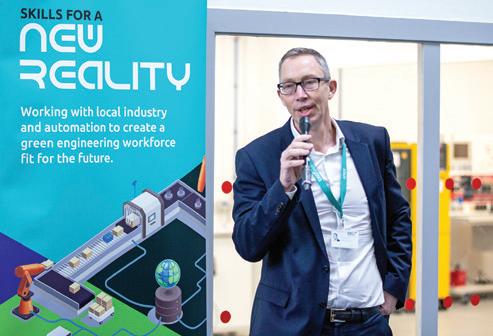
Simon Cook, Principal and Chief Executive, MidKent College and Chair of Kent Further Education (KFE), which champions the FE sector across Kent and Medway, said: “The launch of these new learning centres, and the partnerships with industry specialists will ensure that local employers can call upon the skills and best practice needed to transition to Net Zero as well as putting down a marker for Kent as a leading hub for the green economy.
“A third of UK businesses do not believe their workforce is currently equipped with the skills necessary to achieve net zero. By coming together as one, Kent’s FE colleges are seeking to ensure that changes.”
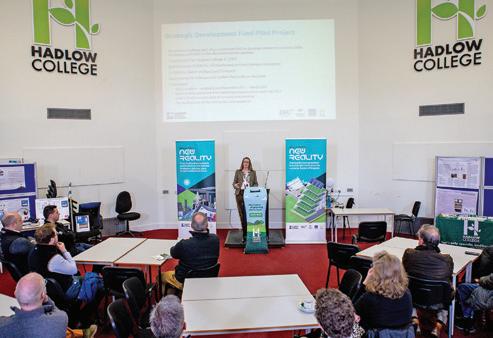
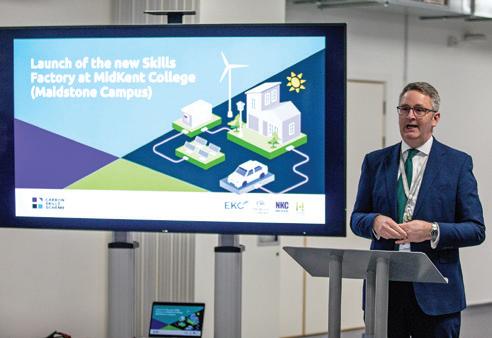
Graham Razey OBE, Chief Executive Officer for East Kent Colleges Group, said: “FE colleges have always been at the forefront of societally transformational leadership projects, and it’s wonderful to have kickstarted a green revolution for businesses across the county.
“Our new engineering centres at Ashford College and Canterbury College will help to develop the skills of the future for our students, whilst simultaneously ensuring employers have the opportunity to test their own decarbonisation plans in a sector leading environment.”
David Gleed, Chief Executive and Executive Principal, North Kent College, said: “We are thrilled to be a part of this sustainability project. As we progress, we will be looking to engage with as many businesses as we can and invite them to join us and our FE sector partners in devising new skills solutions that will support career opportunities now and in the future. The opening of our new Centre at Hadlow College is just the start.”
Highly-rated MidKent College works with organisations spanning a range of business sectors to ensure that its training programmes remain up-to-date.
A range of courses have been designed specifically to support the Construction and Building Services sector as businesses strive to decarbonise the industry.
These focus on developing skills and knowledge to help construction staff and planners deliver energy efficiency, and to meet targets for buildings with low environmental impact
Introductory courses will also raise awareness for the sector, including practical installation and retrofit training plus more advanced theoretical and academic programmes.
Award-winning East Kent Colleges Group, firmly believe in lifelong learning, including professional development for companies.
The Green Engineering Centre and Mechatronic Lab and a second centre in Ashford will not only provide a range of training courses but also offer a resource for businesses looking to decarbonise through testing new concepts, products or processes. Production rigs that can scan and track packaging plus a 3D virtual reality room that will allow businesses to map their factory floor and plan for future automation have also been installed.
Both sites have been equipped with the latest industry standard production line robotics, including collaborative robot technology plus 3D printing and learning tools. Leading sector suppliers for the manufacturing sector have also backed the project, including Kuka Robotics, Create 3D, XYC Machine Tools and automotive learning specialists, Lucas Nuelle.
The UK’s only rural and land-based college is committed to providing students with the best learning experience possible.
The future of farming will be the focus at Hadlow College, where training courses will showcase sustainable methods of food production out on a newly installed commercial greenhouse, and robotic concept vineyard and orchard.
Delta-T devices that measure soil moisture, automated spraying and robotic harvesting will all form part of the courses that are now available, supporting students in developing their skills using the latest technology and equipment.
To find out more, scan the QR codes



HOMErs unveiled their new design at an open house event in Ashtead
The first modular homes designed by two Ukrainian robotics entrepreneurs have been assembled in Britain as housing manufacturing company HOMErs marked its official UK launch in Surrey.

Wanting to support workers left homeless by the war in Ukraine, co-founders
Alexander Stepura and Oleg Pogonyshev developed an entirely new way of housebuilding. Compared to traditional methods, it requires 90 per cent fewer man-hours and a third of the energy.
From operating out of Alexander’s vending machine factory, work is now under way on a new facility in Slovakia, and the company is looking to launch its
products across the UK – with the South East as a key staging ground.
Surrey entrepreneur Chris Baxter invested in HOMErs after his mother, Patsy, donated £15,000 to aid a Ukrainian family of seven whose home in Chernihiv was destroyed by a Russian bomb.
Chris has since been named UK Director of the company and celebrated the unveiling of its first UK modular home alongside Ukrainian’s former ambassador to the UK, Vadym Prystaiko.
Vadym said: “HOMErs is a great example of Ukrainian ingenuity with British investment and support.
“We hope that these homes will help rehouse thousands of families in my country and it would not be possible without the support of our British investors and British team.”
While HOMErs began as a solution for governments and charities in need of crisis housing, Chris and its founders see further commercial potential in their product for young first-time buyers, homeowners looking for a cheap second property – even glampers.
The homes have a galvanised steel frame structure and wall panels made using light, thermally efficient polyurethane to ensure energy efficiency.
Full-fibre broadband provider toob is investing £13 million building its own infrastructure in Woking, with the company aiming to reach up to 32,000 homes and businesses in the area.
The network will run cables directly into either homes or workplaces, which according to toob is what separates its product from other broadbands. This latest investment adds to a £7.5 million network investment in Fleet announced by toob earlier this summer.
Based on the South coast, toob’s base started in Southampton. The firm has been expanding its presence throughout the South since securing an initial £160 million in May, managed by Ares Management’s infrastructure debt strategy.
This can be upsized to £300 million over time through funds managed by the Amber Infrastructure Group. The funding aims to help bring enhanced connectivity to historically underserved areas.
Canterbury Christ Church University is now home to the Industrial Agri-Engineering Hub, thanks to its latest partnership with food and drinks industry support network, Growing Kent & Medway.
Based in the £65 million Verena Holmes Building, this new hub aims to support business-led research and innovation in the horticultural and food and drink sectors.

Businesses will be given access to the university’s specialist facilities and resources, while also leveraging its academic expertise in agri-engineering, automation and manufacturing, assistive technologies, and applied data analysis.
The new development marks a key milestone as the region looks to become a world leader in horticultural production and climate-smart farming.
Dr Nikki Harrison, Programme Director for Growing Kent & Medway, said: “Our partnership with Canterbury Christ Church University will complement the cuttingedge research facilities we currently have as part of our network to support the industry.
“The new hub will drive innovative ideas and projects for commercial application in the agri-food sector, helping us to strengthen our regional offering, as well
This year’s Innovation Summit at Discovery Park in Sandwich attracted more than 300 industry professionals from across the UK, as the leading science and innovation campus marked 10 years of growth.

Among those in attendance was Minister of State at the new Department for Science, Innovation and Technology, George Freeman MP, who praised the site as “a world-class incubator of new life science technologies and companies”.
Discovery Park CEO Mayer Schreiber said: “Our success has been built on creating the right environment to equip early-stage and scale-up businesses, combined with the Government’s commitment to nurturing innovation and backing for the highgrowth industries of today and tomorrow, to succeed.
“Our work has helped foster partnership, promote skills, and unlock finance and business support. As a Life Sciences Opportunity Zone, Discovery Park is perfectly placed to nurture a culture of innovation.”
as attracting international businesses and scientists to collaborate in the UK.”
With the combined effects of climate change, labour shortages and energy crises threatening to disrupt fragile production systems, initiatives such as this are key to forging a sustainable way forward in the world of food and drink.
The partnership has also been a natural fit for the university, whose current research is focused on ‘Society 5.0 and the Artificial Intelligence-enabled world’.
It follows the announcement of a new Data Lab, to be developed in collaboration with Kent’s Discovery Park.
Professor Mohamed Abdel-Maguid, Pro Vice-Chancellor for STEM at Canterbury Christ Church University, added: “Through the establishment of the Industrial AgriEngineering Hub, we are creating a vibrant collaborative platform that brings together staff and students with regional industry experts.
“Working together in a unified transdisciplinary effort, we are committed to positioning Kent and Medway as a driving force in the development of costeffective and sustainable food and drink supply chains.”
The summit this year explored the exponential advance of AI and related technologies, along with their implications for industry, while panel discussions covered the digital future of healthcare and food systems.
Innovate UK, which oversees a total portfolio of £6 billion in public money, expressed their support for businesses as part of a session delving into the Government’s current focus areas, including precision neuroscience and new agri-tech.
Attendees were also given the chance to tour Discovery Park’s newly opened flexible lab complex for start-ups and growing companies. The facility boasts its own on-site Barclay’s Eagle Lab and offers financial backing through the Discovery Park Ventures seed fund.

The Running Horses pub in Mickleham has earned the title of National Pub & Bar of the Year at this year’s National Pub & Bar Awards.
Judges commended the venue for its top-quality food and drink, meticulous attention to detail and first-class hospitality.
A 16th-century pub sat at the foot of the Surrey Hills, it represents one of three locations in the Little & Large Pub Company portfolio run by Manu Bhatt and Richard Brown.
Upon learning of the win, Richard said: “Every single day, we’re trying to put on the best possible experience for all of our guests.
“It’s so nice to be recognised for the authentic hospitality that every member of our team delivers on a daily basis. That is what matters the most.”
London Gatwick has submitted a planning applicationto bring the airport’s existing Northern Runway into routine use alongside its main runway.
The proposed expansion has the potential to create around 14,000 new jobs and boost the region’s economy by £1 billion each year, owing to the resulting increase in tourism, trade and supply chain activity.
Gatwick’s Northern Runway is currently limited to use as a taxiway whenever the main runway is unavailable, but the airport is hoping to implement it as a permanent option for departing flights.
CEO Stewart Wingate, said: “This plan will help secure the longterm future of the airport.”
“If approved, it will also improve airport resilience, meet future passenger demand and increase competition in the London airport market, by providing vital new international connections.”
The University of Sussex has received a £15 million grant from UK Research and Innovation to establish a new Energy Demand Research Centre.
Representing a collaboration between 12 UK universities, researchers will come together to investigate how domestic, industrial, and transport energy demands can be reduced across the country.
Together they are aiming to better understand consumer behaviour, while also assessing the impact on different communities of lowering energy demand.
Mari Martiskainen, Professor of Energy and Society at the University of Sussex Business School, said: “This new centre will deliver important research and policy recommendations into how to reach Net Zero. Energy demand reduction will improve energy security, reduce household energy bills, and address climate change.
Professor Steven McGuire, Dean of the Business School, added: “Sussex’s expertise in energy research goes back several decades, and the new centre draws on this intellectual tradition.”
Deltex Medical Group has released its TrueVue monitoring system for use in hospitals across the UK and EU.
Dubbed a major advance over the existing system, the portable device will be deployed in accident and emergency, intensive care and high dependency units to monitor both adult and paediatric patients undergoing surgery.
Deltex is looking to trial the technology over three months of in-hospital evaluations. In July Deltex conditionally raised approximately £1.89 million after launching a retail offer to existing shareholders.
In a July trading update, the company revealed unaudited revenues for the six months ended June 30, were £1.1 million, down from £1.2 million in the same period last year, with the group experiencing weaker than expected trading in the second quarter of 2023 which the Board believed was a result of customers waiting for the new TrueVue monitor to be available.
The Running Horses took home the top spot at the National Pub & Bar AwardsThe aviation industry believes 80% of all maintenance issues are due to human error, because of this, it has developed excellent techniques for minimising errors, and handling the risks associated with people, writes Richard Baker, Audit Partner at national audit, tax, advisory and risk firm Crowe.

• Encourage collaboration.
• Establish manuals and guides.
4. Distraction
Distraction causes someone to skip a step or detail – it’s estimated that 15% of maintenance errors are caused by inattention.
It’s also the aftermath of an interruption - a study co-authored by Gloria Mark of the University of California suggests that it can take more than 23 minutes to regain focus after an interruption.
The United States Federal Aviation Administration’s (FAA) handbook for aviation maintenance Technicians covers “Human Factors”, listing 12 key areas businesses can consider as they strive for continuous improvement.
The handbook’s guidance encourages manufacturers to study and prevent problems and errors to help improve efficiency and eliminate waste.
Top tips for mitigating risk around the 12 causes of human error:
1. Lack of communication
This can be between all parties involved, internal or external. The FAA says that only 30% of verbal communication is received and understood in a conversation.
• Stress important messages at the beginning and end of a conversation.
• Do not assume!
2. Complacency
Repetitive tasks may be overlooked and taken for granted.
• Consider building in variety to encourage alertness.
• Learn from mistakes by sharing failures.
3. Lack of knowledge
Absence of training or information to successfully perform the work in hand.
• Establish and monitor attendance at training courses, testing knowledge gained.
• Reduce distractors around critical processes.
• Trace back several steps to ensure nothing is missed.
5. Lack of teamwork
This can be poor communication or sharing of knowledge.
• Plan and agree an approach to the task.
• Check each person understands their role.
• Find ways to build trust amongst the team.
6. Fatigue
Reduced alertness and focus causes errors and inefficiency.
• Offer training on the symptoms of fatigue.
• Encourage cross-checking of work where there is a risk of fatigue.
7. Lack of resources – people and components
During the pandemic and its aftermath, this has been incredibly challenging and has been a key area of focus for business managers and owners.
• Track availability of people and machine hours at various times of the year.
• Study your supply chains and assess the risks.
8. Pressure
Caused by tight deadlines and schedules which in turn have various root causes.
• Create an environment where your people can:
• openly share their concerns without judgement
• ask for help
• put quality and safety above deadlines.
9. Lack of assertiveness
Not speaking up can lead to mistakes. This can be challenging in traditional hierarchies.
• Encourage people to constructively express their concerns by highlighting problems and their consequences.
• Resolve one issue at a time.
10. Stress
This can take various forms – physical, psychological, and physiological.
• Consider problems calmly and rationally – take your time.
• Encourage your people to ask for help.
• Encourage breaks.
11. Lack of awareness
The failure to recognise the consequence of an action or a lack of foresight.
• Stand back and assess.
• Plan and consult.
12. Norms
Creating new norms that diverge from best practice.
• Just because it is the norm does not mean it is right.
• Identify and eliminate negative norms.
• Ensure safety is paramount.
Crowe’s dedicated team supports clients over the long-term to help them continuously improve their business with numerous services, including project implementation support, coaching, training and development and much more.
If you would like to know more, please do get in touch with Richard Baker, richard.baker@crowe.co.uk
www.crowe.co.uk

An unexpected discovery while working on a novel way to successfully create fusion energy could develop into a valuable income stream for Oxford-based First Light Fusion – and help in the diagnosis and treatment of health conditions such as heart disease and cancer.
The pioneering fusion company, is working with Spanish engineering firm IDOM UK Nuclear Services to identify potential pharmaceutical applications of its unique projectile fusion reactor process, after discovering that its reactor design enables the generation of radionuclides.
These medical isotopes, used to diagnose and treat conditions such as heart disease and cancer, provide a considerable (though unconfirmed) new market opportunity for First Light.

According to independent studies the medical isotope market will be worth $11 billion by 2027.
Isotopes are increasingly important in the diagnosis and treatment of serious illnesses including cancer, yet isotope production – as well as a limited shelf life –make stockpiling isotopes impossible and
has resulted in massive supply constraints.
First Light is pursuing a novel method of inertial confinement fusion, the same method with which the Calfornia-based National Ignition Facility demonstrated energy gain from fusion last year. First Light uses a launched projectile instead of lasers to power the experiment.
First Light has been working with IDOM on the design of its fusion reactor chamber, as part of its plans to build a pilot fusion energy power plant.
Four-fifths of the energy released by fusion is in the form of high-energy neutrons. Capturing them is essential for power production from fusion and safely managing the extreme fluxes inside the reaction vessel is a key advantage of First Light’s approach.
The neutrons are also used to produce tritium through a reaction with lithium. This project adds a third aspect, where the neutrons are used to produce radionuclides for pharmaceutical applications.
Nick Hawker, co-founder and CEO of First Light Fusion, said: “This is an incredible and unplanned development for our projectile fusion technology. Our focus remains very much on building Machine 4, our gain demonstrator, while developing a first of a kind fusion reactor.
“But when we identified the potential not only to produce, but also harvest medical isotopes which are having an increasing impact on the diagnosis and treatment of such serious illnesses as cancer and heart disease, it was incumbent on us to explore the opportunity.”
The government has unveiled a £20 million funding scheme to support the development of telecommunications technologies and aerial connectivity projects in the space sector.
The announcement came at the opening of a new conference centre at the European Centre for Space Applications and Telecommunications (ECSAT) on the Harwell Science and Innovation Campus.

Technology Secretary, Chloe Smith (who has since stood down), said: “From using drones to quickly get medicines to hospitals, through to boosting mobile network access in remote areas, the benefits of aerial connectivity cut through many aspects of our lives.
Space Agency. Credit: ESA/Max Alexander
Projects could include developing connectivity for aerial platforms with hybrid capabilities that can seamlessly switch between satellite and terrestrial networks, or traffic management for innovative vehicles such as electric vertical take-off and landing (eVTOL) aircraft, or ‘flying taxis’.

Banbury engineering company Prodrive has completed the transformation of a 1967 Ford Mustang into a long-distance rally car.
The 12-month project saw the vehicle going from a rusted shell to one capable of participating in the 2024 Peking (now Beijing) to Paris Motor Challenge.
The Challenge is a 37-day, 14,000km event, which starts off in China and travels through Mongolia, Kazakhstan, Azerbaijan, Georgia, Turkey, Greece, Italy before finishing in France.
Oxford University spin-out Beacon Therapeutics has launched with £96 million in funding.
Beacon’s focus is the application of gene and cell therapies to combat sight loss across various conditions. One of these conditions, macular degeneration, affects an estimated 1 in 200 people in the UK by the age of 60.
Lead investor, Syncona Limited, is a firm that focuses on the life sciences and has shown a particular interest in gene therapies for the eye.
Syncona was a founding investor of two other startups dedicated to this research, Nightstar Therapeutics and Gyroscope Therapeutics.
Oxford-headquartered Nexeon has secured a site for its first commercial volume silicon anode material plant.
The new factory is based in Gunsan, South Korea and will be next to the factory of its key supplier OCI with construction set to begin this year.
Nexeon’s silicon anode material replaces graphite in traditional battery cells, dramatically increasing energy density.
Silicon anode-enhanced batteries last longer and charge faster than traditional lithium-ion batteries which is of significant appeal to the electric vehicle industry.
This announcement follows hot on the heels of the company announcing that it had signed a long-term supply agreement for silicon anode material for batteries with global electric vehicle cell manufacturer Panasonic. The agreement will see Nexeon supplying materials to Panasonic for cell production.
In the latest announcement, OCI will deliver the raw material through a dedicated and direct pipeline between both facilities on the Gunsan site.
Scott Brown, CEO of Nexeon, said: “Between securing a strong supply chain of raw material and our supply agreement with Panasonic, we are one step closer to delivering the best performing and cost-efficient silicon anode materials – a vital enabler of more energy dense batteries.”
Last year Nexeon raised more than $200 million in funding which is helping it accelerate the expansion of its own manufacturing capabilities. The company has its headquarters at Milton Park with operations in Japan and now South Korea.

Real estate investor and developer, Firethorn Trust, has been granted outline planning permission for 530 new homes in North West Bicester, part of the UK’s first eco-town.

The decision successfully concluded an appeal process, with the planning inspector placing significant weight on the fact the scheme would support the delivery of the wider North West Bicester Ecotown – the first of its kind in the UK.
The main eco-town, Elmsbrook, is being developed as a zero-carbon community, where each home has been built to high energy efficiency standards with photovoltaic solar panels on every roof,
an eco business centre which was the the first non-domestic building to achieve Passivhaus Plus in the UK.
Details within the latest planning application by Firethorn mean the proposed development would provide sustainable infrastructure to reduce the community’s carbon footprint and promote the use of renewable energy sources, resulting in the delivery of a “true zero carbon” development. It will offer up to 30 per cent of affordable housing and 40 per cent of green space including woodland and meadow areas.
The allocated residential site, spanning 55 acres, is owned by Firethorn Trust and
Abingdon-based business development company Intralink has welcomed a £19.6 million investment from Mobeus Equity Partners to take Intralink into the next phase of its development.
Intralink helps companies enter new export markets and also supports governments in promoting trade and attracting foreign direct investment.
Mobeus was impressed by Intralink’s unique model for helping western technology companies secure commercial deals with customers in Asia, as well as its innovation work for large corporates and trade work for national and regional governments.
Mobeus’s capital will help Intralink move into new markets in Asia and beyond.
forms part of its Living portfolio, which is led by Firethorn director, Marcus Weeks. Marcus said: “As a true zero carbon development, North West Bicester Ecotown is setting the standard for future homes.
“The recent decision to allow the appeal and grant planning reinforces the considered approach that we take on every development project and is a significant step towards realising our vision of creating a modern, sustainable living environment.
“We are well capitalised and excited to pursue more development opportunities for residential, built to rent and purposebuilt student accommodation.”
Greg Sutch remains as CEO. Founder and chairman, James Lawson, will step down after more than 33 years at the helm.
Mobeus Partner, Chris Price, said: “Access to the Asian market is fundamental to the strategy of almost every high-growth tech business around the world. Intralink facilitates complex international trade, and all venture capital and private equitybacked scaleups, as well as corporates interested in cross-border innovation, should have them on their radar as the means to bridge the divide.
Greg Sutch added: “This investment is a big milestone for our business. It will enable us to support clients in more ways and in more markets.
“Mobeus’ investment will accelerate our growth and help us realise our vision of a more prosperous, sustainable society created through cross-border, commercial collaboration.”
B P Collins’ employment team, ranked by independent legal directory, The Legal 500 as a ‘Top Tier’ practice, explores what constitutes bullying and how to manage it in the workplace.



ACAS describes bullying as: “unwanted behaviour from a person or group that is either:
• offensive, intimidating, malicious or insulting; or
• an abuse or misuse of power that undermines, humiliates, or causes physical or emotional harm to someone.”
It is important to note that there is no legal definition of bullying.
What can constitute bullying?
Bullying is very broad and can include a range of actions such as:
• abusive or intimidating behaviour;
• overbearing or intimidating levels of supervision;
• inappropriate or derogatory remarks about an individual’s performance.
The relationship between bullying and harassment
Bullying and harassment are often confused. Harassment is covered by the Equality Act 2010 and can give rise to a claim in the Employment Tribunal.
Bullying can therefore become harassment under the Equality Act if it is related to any of the following protected characteristics:
• age
• disability
• gender reassignment
• race
• religion or belief
• sex
• sexual orientation
Separately, sexual harassment is unwanted behaviour of a sexual nature. This type of harassment does not need to be related to a protected characteristic. Certain acts of harassment may also fall under the Protection from Harassment Act 1997, which is separate to the types of harassment under the Equality Act 2010.
Employers should be proactive in promoting a respectful and inclusive working environment and importantly, should ensure they address bullying and harassment.
Employers are advised to:
• Implement clear policies on managing grievances and separate policies (if applicable) on managing allegations of bullying and harassment;
• Fairly and consistently investigate complaints of bullying and harassment and, if appropriate in the circumstances, consider appropriate disciplinary action against alleged perpetrators;
• Provide diversity training which includes examples of unacceptable behaviour.

B P Collins’ employment team is highly experienced in advising employers on how to manage allegations of bullying in the workplace. Due to its quality of work, it has been instructed on high-profile age discrimination and whistleblowing cases, which have established legal precedent. It also advises on non-contentious work, including helping clients to buy or sell a company or achieve an amicable exit for an employee.

For further information, please email enquiries@bpcollins.co.uk or call 01753 889995

More than 70 people attended the Bessemer Society’s “Fitting Together the Net Zero Jigsaw dinner” at Harwell Campus.


Photography: Rob Lacey
Keynote speakers included Tim Harper – CEO and co-founder of Element-2, which is building the first national network of hydrogen refuelling stations, David Ainsworth – battery technology adviser at bp and Paul Stein, Chairman of RollsRoyce Small Modular Reactors.
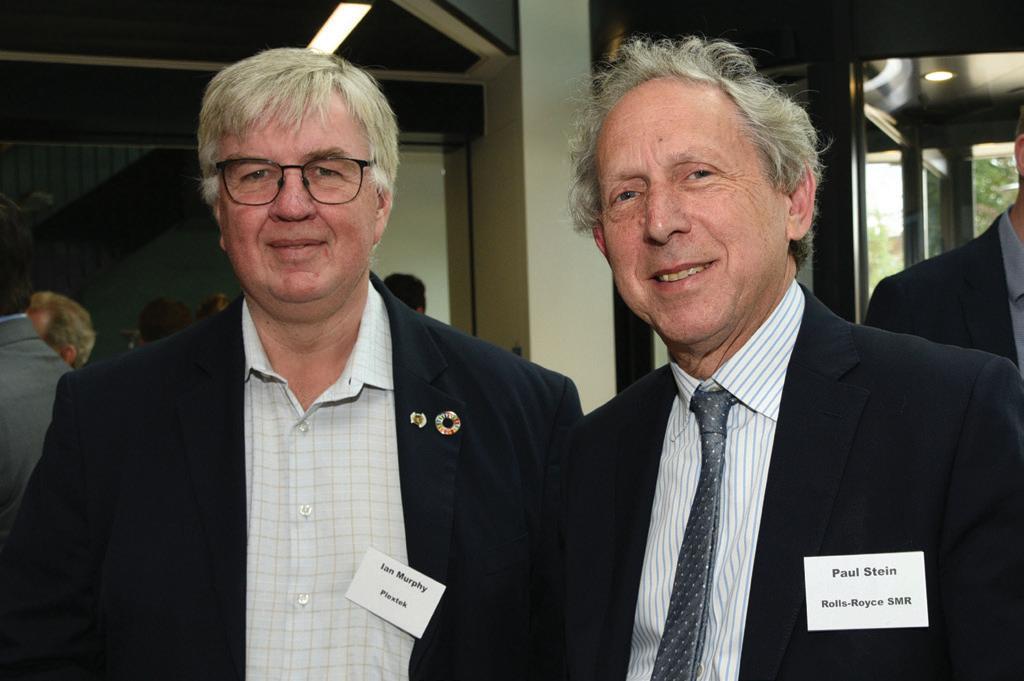
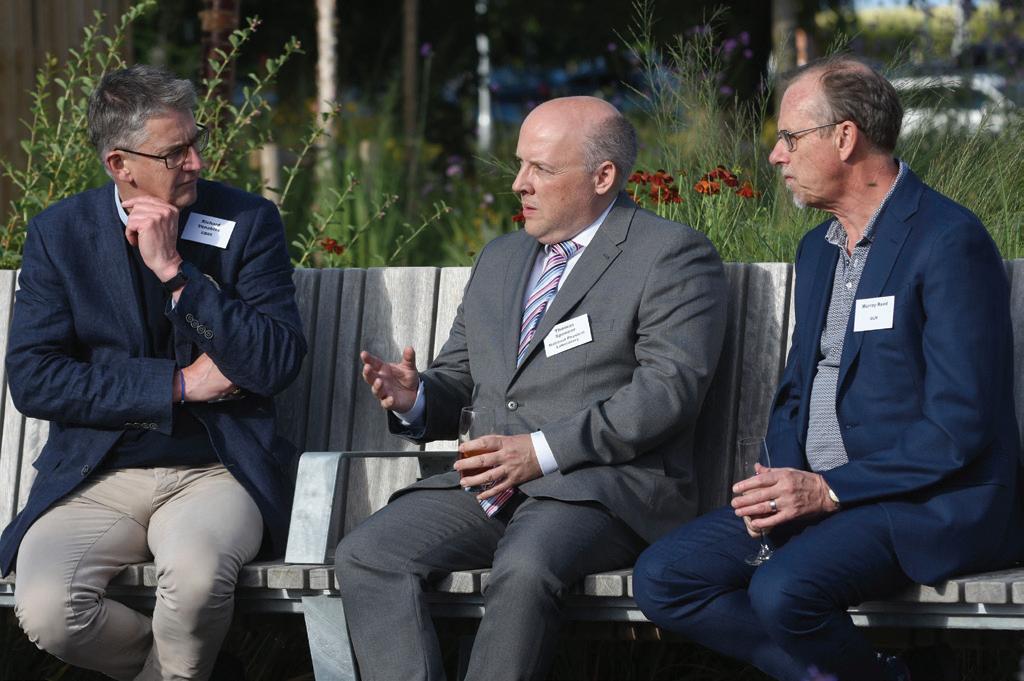

Rolls-Royce SMR Ltd has designed a nuclear power plant that can offer clean affordable energy for all. The plants rely on existing nuclear technology and can be operational far more quickly than conventional nuclear technology.
The Bessemer Society is a society of serial CEOs, founders and entrepreneurs committed to creating successful new companies based on technological innovation in science and technology. It was named after the 19th century steel inventor and entrepreneur Sir Henry Bessemer.
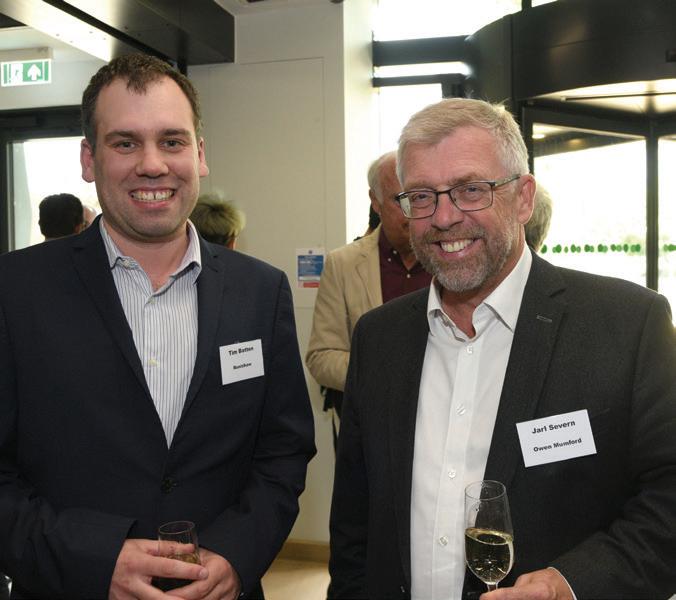
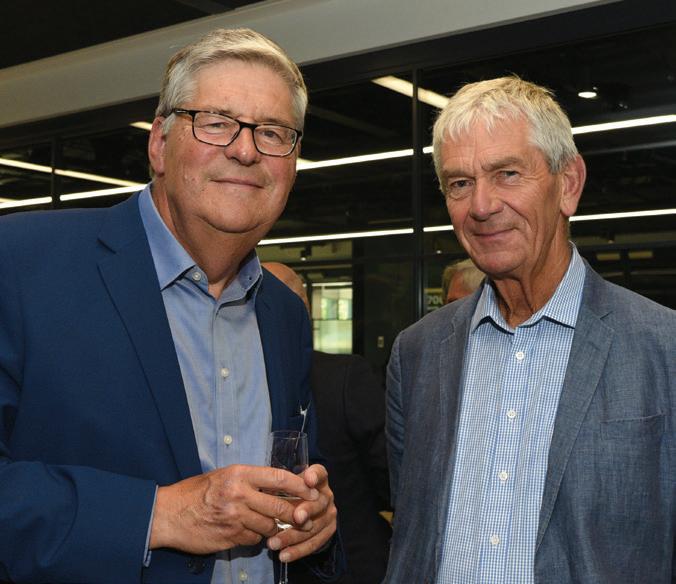

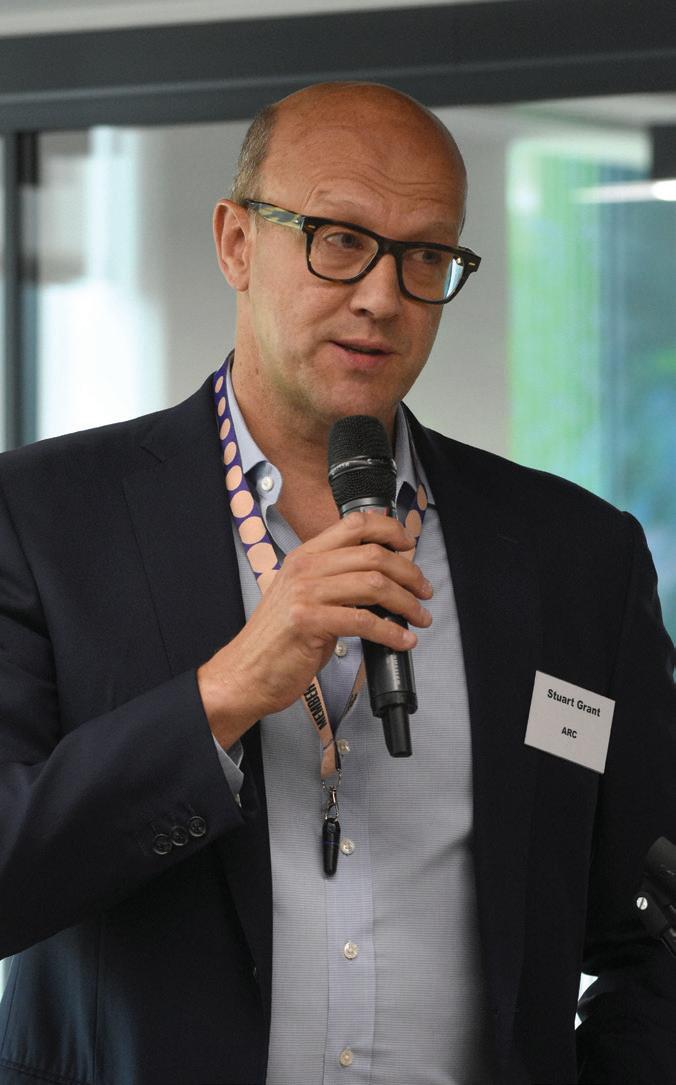


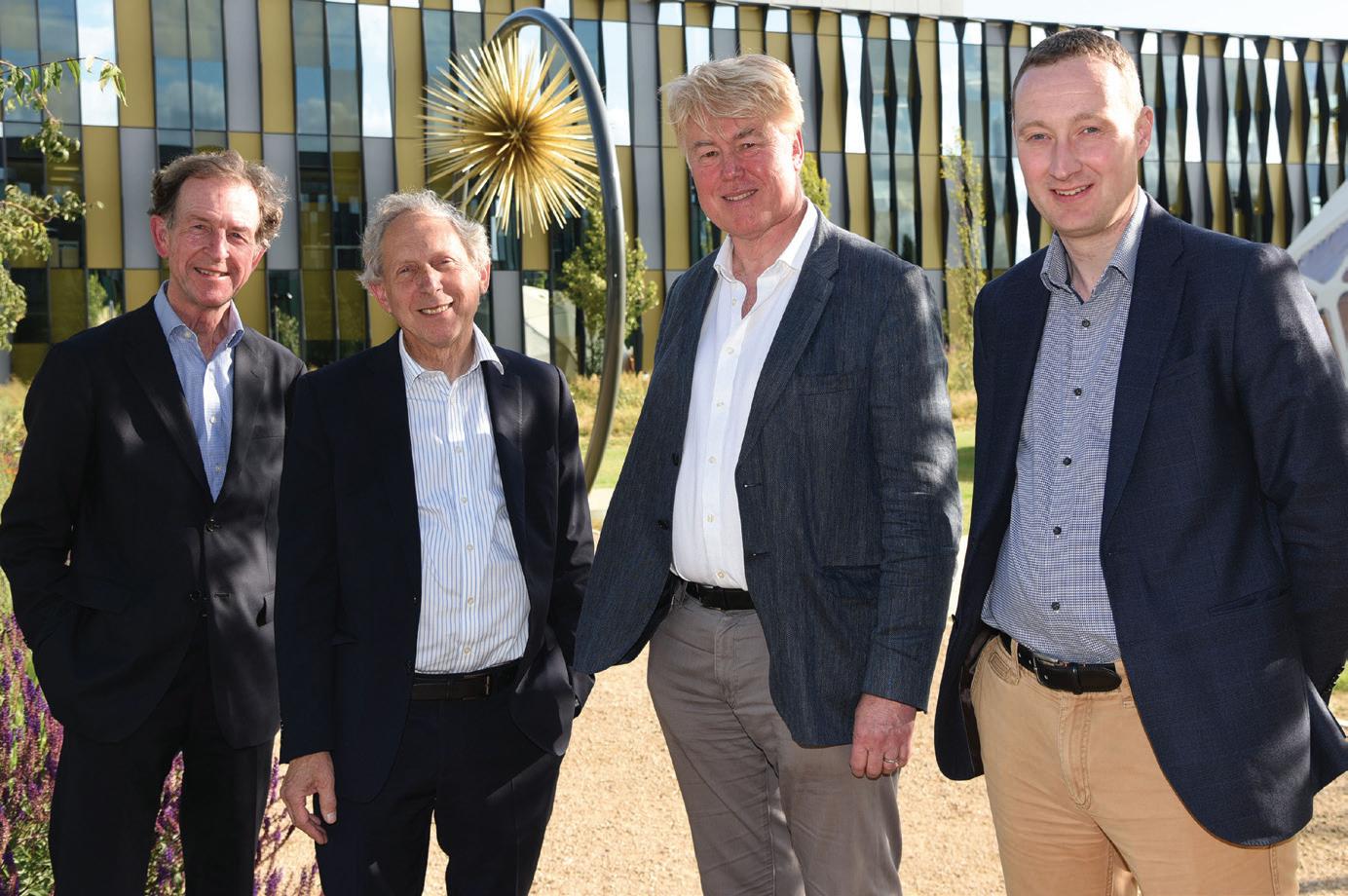
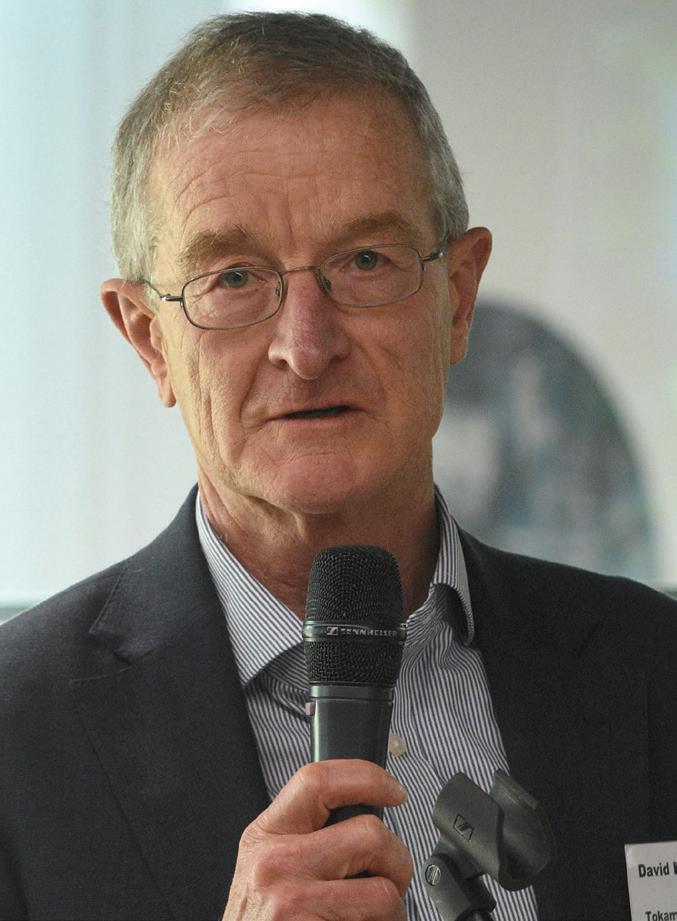
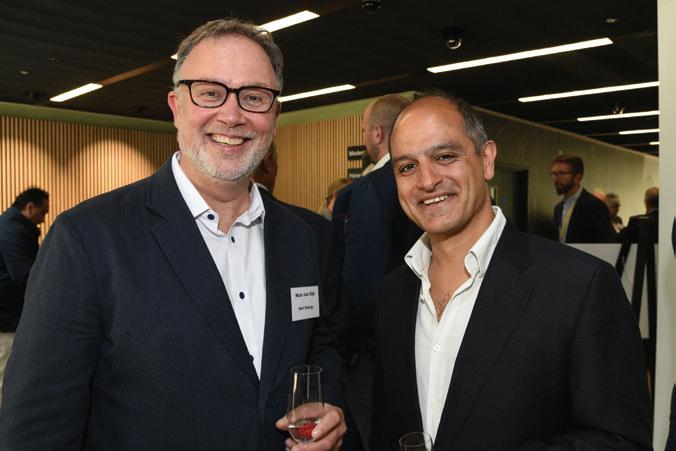
The power of a strong economy to improve people’s prospects should never be underestimated according to the leader of Hampshire County Council, who is determined to bring all parts of the local authority’s economy together to make this happen.
County Council Leader Cllr Rob Humby began his working life as an apprentice engineer and went on to start his own engineering firm before later running a plant nursery business.
He has also served as deputy leader of Hampshire County Council and has been a cabinet member for Economy, Transport and Environment.
Cllr Humby said: “Engineering is about problem-solving and making machinery talk to each other, which is what I try to do with organisations and people.
“If you have a strong economy then everything lifts. School attainment lifts and how people think about where they live improves.
“If you can develop a really vibrant
economy with people in good jobs, and the infrastructure to go with it, then naturally things improve. It all starts, however, with education, skills and training.”
Hampshire County Council and The Business Magazine are partnering to launch the Hampshire Business Awards, and on November 30 they will celebrate the achievements of the county’s business ecosystem at a special awards event, to be held at Farnborough International Exhibition & Conference Centre
The conference centre is next to Farnborough Airport – the hub of one of the county’s fastest growing industries – aviation. Cllr Humby explained how the awards will showcase the diversity of industry found across the county. “It’s about putting Hampshire on the map,” he said.
“We have some world-leading businesses here and some amazing companies large and small that most people will not have heard of.
“If you are excellent at what you do then why shouldn’t you shout about it? The awards will bring people together, be a shop window and allow businesses to say; ‘this is us’ and ‘this is what we do’.”
The Hampshire Business Awards also align with the Hampshire 2050 vision which looks at how organisations, in both the public and private sector, can work together to make the county ‘a great place in which to live, work, visit and play’.
Cllr Humby added: “The Hampshire 2050 vision talks about what a fantastic place Hampshire is and how we can create a vibrant economy while maintaining it as the beautiful place that it is.
“We have everything here. The Solent is the biggest natural water park in the world, we have wonderful national parks and we are well connected in terms of infrastructure.
“My family have been in Hampshire for more than 450 years and I’m very proud of that. I am Hampshire through-and-through and everything that we are doing is about helping the people who live in Hampshire.”
If Hampshire is to reach its potential, according to Cllr Humby, collaboration across the economic spectrum, even between companies that consider each other as competitors, is essential.
He said: “Everyone puts their arms around their own organisation but what they should be doing is opening their arms and realising that the benefit of doing this is huge. If we can get people not to worry about being protective, then it will be a benefit to everyone.
“I’m not political and I won’t let politics get in the way of doing the right thing. I want to join up the dots and get people to understand what life is like in someone elses’ shoes.”
Collaboration and pooling resources are also necessary in the face of fast technological change – particularly with the advance of cloud computing and artificial intelligence.
Cllr Humby said: “My grandfather was born in 1903. In 1903 there wasn’t any flight, however 66 years later we landed on the moon.
“If we think of how fast technology is progressing then you have to be really on it. But how do you keep pace? By bringing together our schools, colleges and universities with business.”
The county council leader also said it was important that businesses understood the responsibility that the authority had when it came to social care and how business activity was crucial to contributing towards this.
He said: “Part of my role is to explain to businesses what we do as a county and how that might affect their children or if they have parents who receive social care.”

The skilled labour shortage is never far from the headlines and Cllr Humby says the authority is well-placed to assist in alleviating this through its input into education.
He said: “We need to be more joined up with the local authority, universities, colleges and employers talking to each other and understanding what the future skills needs will be.
“Education is key and has to be aligned with the skills that employers are looking for. This alignment should happen at all levels of the school system and there is no reason why it should not happen at junior schools.”
Retraining and reskilling workers in declining industries is also on the council’s agenda as it looks to future-proof the county’s workforce so that it becomes more attractive to foreign investors.


Cllr Humby said: “Getting the right qualified staff and attracting staff is challenging for businesses.
“Our colleges offer excellent retraining opportunities. However we should not forget that we also have residents in Hampshire with complex needs and we must make sure we don’t exclude any area of our community.”
The Hampshire County Council leader says his background as an engineer
means he leans more towards action rather than talk alone.
He said: “Talking is good but there has to be something that comes out of it.
“We live in an amazing county and the opportunities are huge if we work together.”

Water treatment firm Evolution Water (Berkshire)

Construction firm CLC Group (Southampton)

Voice and data firm Southern Business Communications (SBC) (Hampshire)

Has been acquired by testing company Phenna Group (Nottinghamshire)
Advisers included: BCMS, Freeths and Eacotts
Cyber security company Logiq Consulting (Wiltshire)

Has been acquired by private equity firm HIG Capital (London)
Advisers included: Shoosmiths, RSM, PwC, Goodwins, Alvarez & Marsal, OC&C and Hakluyt, AON and Buck, FRP Advisory. Bank Debt was provided by Tikehau
Accountancy firm WoodWhite Accountants (Reading)

Has been acquired by business telephony specialist 4Com (Dorset)
JUNE
Visitor management platform VGS (Italy)

Has received investment from Phoenix Equity Partners (London)
Advisers included: IBB Law
Manufacturers Murat Ticaret (Turkey)

Has been acquired by professional services group Xeinadin (London)
JUNE 2023 | UNDISCLOSED
Accountancy firm TC Group (West Sussex)

Has been acquired by accesso Technology Group (Reading)
JUNE
Builders’ merchant Kent Blaxill (Essex)

Has been acquired by power component maker Volex (Hampshire)
Has gained investment from private equity house Inflexion (London)
Has been acquired by Independent Builders Merchant Group (East Sussex)
Has been acquired by insurance broker AssuredPartners (London)

Advisers included: Rickard Luckin, Palmers Solicitors, KBS Corporate
T4
Has been acquired by Sauter Automation (Switzerland)
Advisers included: KBS Corporate
Sentinel Insurance Solutions (Berkshire)

Has gained investment from Mobeus Equity Partners (London)

Advisers included: RSM, DC Advisory, CIL, Gowling WLG, Grant Thornton, Chief People Office, ESG, HMT
Yourgene

Has been acquired by aviation services company Unifi Aviation (United States)

Has been acquired by Ardonagh Advisory (London)
Is set to be acquired by Novacyt UK (Hampshire)
Advisers included: Stifel, Addleshaw Goddard, Numis, SP Angel Corporate Finance LLP, Stephenson Harwood
Theale-based corporate finance boutique CapEQ share insights on how current levels of UK M&A activity are reshaping the business world
By Lee Robbins, Head of Research, CapEQAlong with most UK financial services, headline mergers and acquisition (M&A) activity has been subdued by high inflation and the rising cost of borrowing.
New data for the first six months of this year shows that just over 3,300 transactions completed, compared to 3,800 in the three months before Covid lockdowns caused major business disruption.
The most striking change is the dramatic slowdown of venture capital (VC) investment – hitting a five-year low with 30 per cent fewer early-stage companies
backed than usual. However, the mood is similar in most Western countries and the UK remains the top VC hub in Europe.
Private equity investors remain acquisitive in 2023, backing four UK companies every working day – down slightly from 4.6 companies a day in the first half last year. Private equity firms are clustered around high-growth or high-margin sectors such as pet food, healthcare and software.
Corporate acquisitions are the mainstay of M&A, and are also slightly down on “normal” activity. While some PLCs have

stalled acquisitions until inflation calms, larger privately owned or private equitybacked trade buyers have filled the gap.
The key takeaway here is that transactions are still completing every day, though at a reduced level from the last 18 months.
As ever, M&A activity is never uniformly spread across the economy. Activity is focused on a handful of hot sectors – where private equity investors and corporate acquirers battle it out for premium targets – while large swathes of industry are left virtually untouched by acquisitions.

Many companies are expected to be marketed for sale in the latter months of 2023, as shareholders recognise the uncertainty created by a forthcoming General Election and the lack of clarity around Capital Gains Tax and Business Asset Disposal Relief.

With the increase in supply of opportunities for acquisitive companies and private equity funds, it is easy to envisage a two-paced market, where premium assets retain strong valuations but other companies may be crowded out.
So, what should vendors do in this environment?
The simple answer is to be aware of the options available, to work on contingency plans and run a shadow process that creates a safety net for shareholders in the event of a stalled transaction. This also allows vendors to keep an element of control and objectivity, knowing a strong alternative exists.
There are a number of routes to consider alongside a sale and these options may prove a better fit for the medium-term aspirations of vendors and management teams – in other words, there is an increase in the availability of funding to derisk vendors now while maintaining future upside potential.
Funding sources which can be considered to achieve some of these alternative structures include:
Minority private equity – with efficient structuring, vendors can de-risk now at known tax rates but retain control of key decision-making. By driving the business forward, they are then well positioned for a secondary transaction at a higher valuation when the time is right, rather than accelerating plans because of economic uncertainties.
Family offices are able to be more flexible than traditional private equity and tend to invest in sectors where they have experience.
Private equity ‘debt funds’ – we are seeing an increase in private equity firms broadening their offering to include ‘debtlike’ structures which contain an equity kicker (say 10-25%) to drive their returns. The kicker can be re-financed, meaning the company’s ownership can remain private, which can be very attractive to families looking to pass ownership to the next generation.
Debt providers – whilst the availability of traditional debt funding from high street banks has tightened, they remain a good source of capital. Private debt and alternative funding markets remain open, with no shortage of liquidity in the system.
Cashless transactions – no cash to the vendors on completion but debt instruments due to the vendor instead. The lack of funding means they are simple to construct, low cost and vendors can be paid over time. Vendors need to avoid a tax charge falling due without funds to pay it, however, and often cash on the balance sheet can be used to achieve this.
Whoever the funders, there is an increased focus on due diligence, so vendors should seriously consider vendor due diligence to increase the speed and likelihood of success of transactions. Investment in preparation is key, particularly making sure any structure works from a tax perspective.
At PKF Francis Clark, we often work with clients well in advance of a transaction to ensure they are appropriately prepared. We are therefore ideally placed to consider your options and approach to de-risking in the current M&A environment.
For more information, email paul.stout@pkf-francisclark.co.uk or call 02380 012890.

Paul Stout, corporate finance partner at PKF Francis Clark, explores how vendors can achieve their objectives in the current mergers and acquisitions market.
Veteran finance industry executive and a founder of Shawbrook Bank in 2011, Philip George, has been appointed to the board of Poole-based MSP Capital as a non-executive director. After Shawbrook’s successful float in 2015, he was managing director for business development until 2019.

03
Lloyds Bank Commercial Banking has appointed Nathan Morgan as Head of Asset Finance in the South East and South West. Nathan will bolster support for SMEs and mid-corporatesized businesses. He was previously an associate director within the team. He has also served in the commercial banking arms at Santander and HSBC.
04
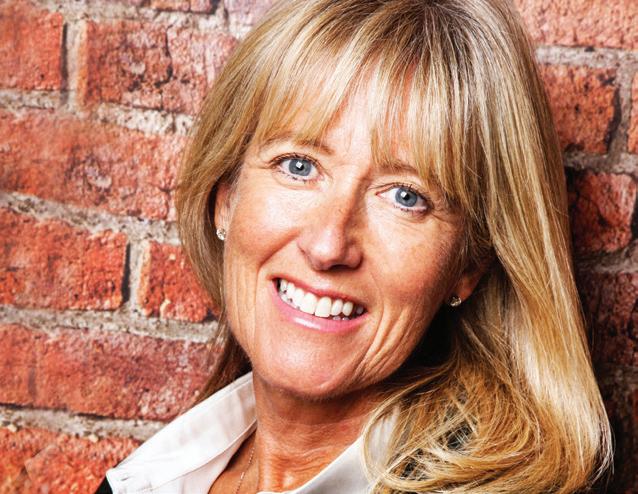
brief
Housebuilder Dandara has appointed Paul Ebbs as Regional Director for its Southern region. Paul, who has been Operations Director for Dandara Southern since January 2021, will implement the strategic plan to grow Dandara across Southern England.

CEO of Southampton-based Oyster Yachts, Ashley Highfield, has been appointed non-executive director at British Marine, the trade association for the UK leisure, superyacht and small commercial marine industry. With a background in media and technology, previous roles include CEO of Johnston Press, Managing Director and Vice-President Consumer and Online UK at Microsoft, and director of new media and technology at the BBC where he launched the iPlayer streaming service.

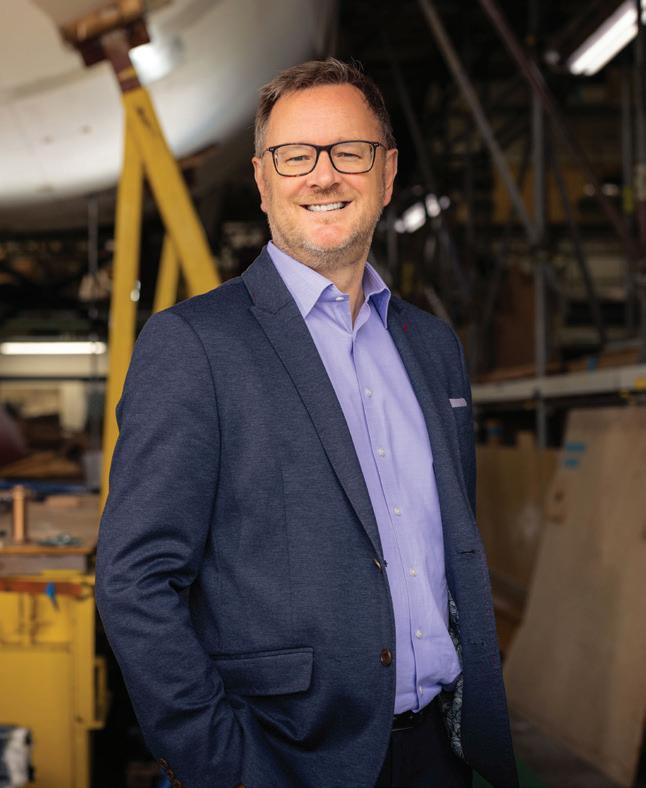
05
05
Blandy & Blandy, which has offices in Reading and Henley-on-Thames, has announced two promotions in its Wills, Probate, Tax and Trusts team. Louise Nelson (pictured left) becomes a partner, having helped to establish and develop Blandy & Blandy’s presence in Henley-onThames since re-joining the firm in 2017. Kelly Chandler, who joined the firm in 2020, becomes an associate solicitor.

07 Azets makes five key appointments in the Solent Accountancy and business adviser Azets has named three new Partners and made two promotions to Director at its Solent regional offices. From left to right above: Jon Brand, Tina Harris and Dean Weale have been promoted to Partners.
Pik Wong has been promoted to Employment Tax Director while Louis Nutland has been promoted to Corporate Finance Director.
09
The professional negligence team at Lime Solicitors is expanding into the South East through the appointment of partner Karim Mohammed. Karim joins from Sussex-based law firm Mayo Wynne Baxter and has more than 30 years of experience in advising on claims against professionals.


10 Saffery Champness names new audit manager
Mariee Payne has joined the Bournemouth offices of Saffery Champness Chartered Accountants as audit manager. She arrives from Mazars in Poole, where she worked her way up from audit trainee to assistant manager.

Foot Anstey associate Jade Hawksworth has been elected as Vice-Chair of Women in Property Solent branch. Women in Property is a professional network that actively promotes and empowers women in the property and construction industries.


Law firm Gardner Leader has appointed Gina Tray as its new marketing manager. The firm has seen its workforce grow to more than 180 across seven office locations. Having worked in Vienna, Berlin and London, she has held positions at Austrian law firm Wolf Theiss and KCD Luxury Marketing, working alongside brands such as Vogue, Netflix, and Meta.




Finding the magic collaboration formula that makes industry and academic institutions click is not an easy task, with the UK’s university landscape littered with grand linkups that failed to live up to their potential.
The Reading Real Estate Foundation (RREF) is a rare success story in that it has been bringing the property industry together with academia at Henley Business School, part of the University of Reading, for more than 20 years.

The Foundation conducts research in partnership with the property industry, helps to diversify the backgrounds of those entering it and also provides support to students studying in the Department of Real Estate & Planning at the University of
Reading through mentorship and financial support.
The foundation also provides seed funding to academics to test ideas while its backers also fund PhD students.
Executive Director Jean Pierre Choulet, has been at Henley Business School for more than eight years and, alongside his lead role with the Foundation, he is also in charge of growing the institution’s presence in Africa and cementing its alumni links.

He said: “It’s very complicated for academic research to find its way into the industry and the purpose of the Foundation is to be a forum for conversation between academia and the property industry.
“Frustration is everywhere. It is with the academics as they don’t want to be led by the industry, and the industry thinks that the content is not easy to understand and doesn’t have immediate impact.
The Reading Real Estate Foundation has shown that impactful collaboration
is possibleThe Reading Real Estate Foundation is based at Henley Business School Jean Pierre Choulet
“We have been able to create a framework for this conversation to happen. For the industry to meet with academics, argue and debate.”
Diversity in the property sector is a key topic in boardrooms, as it is in other industries too, with the property industry keen to shed its boys’ club image and attract people from different backgrounds.
There are two main barriers, according to Jean Pierre, that prevent people from entering the property industry with one being a fear that their background is not suitable and the other that they are unsure about going to university.
Jean Pierre said: “We need to demonstrate you don’t need to own an estate or be part of a club to deliver value to the property industry.
“Diversity is in the DNA of the Foundation and the property industry needs it to be competitive. This could be diversity in gender background, ethnicity but also academic excellence.
“If they replicate their own profiles in their hiring, which has been the case in the property sector for centuries, then they will disappear.”
The Foundation’s Pathways to Property Programme is evidence of the above vision with more than 100 Year 12 students going through the programme each year.
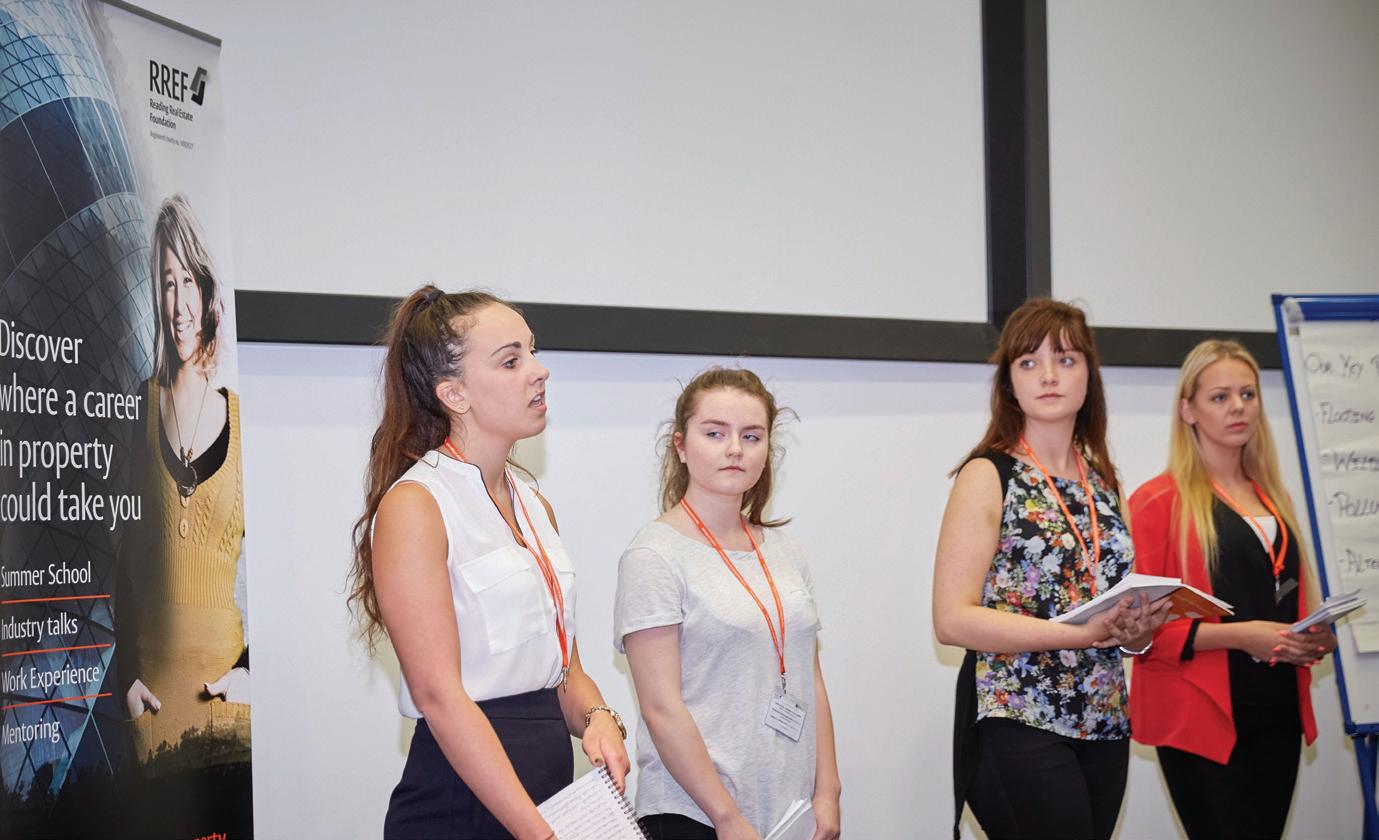
The project works on their self-confidence alongside giving them an insight into the sector.
Jean Pierre said: “We are very proud of this signature programme which this year is taking 109 students who have no relation to the university and no family members working in real estate.
“Most of them will end up studying at other universities. However, this programme is very much the signature of the Foundation and its impact will be felt well beyond the University of Reading.”
The list of the Foundation’s supporting partners is akin to a “who’s who” of the property industry with prominent supporters including real estate services firm Savills, investors Landsec, developers Hammerson and retailer John Lewis to name but a few.
What is it that attracts so many corporate and indeed individual supporters to the foundation when similar schemes struggle to gain such industry traction?
Jean Pierre says its appeal can be traced back to inception two decades ago when it was set up as a project sitting outside of the University of Reading between one academic and the industry itself.
The Foundation, which has charitable status, is now firmly in the fabric of the University of Reading but retains a large degree of autonomy.
Jean Pierre said: “What makes the foundation unique is the support that we have from industry. It is within the university but is able to impact beyond it.”
It is this ‘impact’, says Jean Pierre, that is vital to gaining and retaining the support of the Foundation’s commercial partners.
Its latest research paper, which was also the subject of the Foundation’s annual Summit, looked at how powerful real estate is as an economic actor in the UK and how it can be leveraged for a host of societal benefits including sustainability and increased productivity.
Jean Pierre said: “We have corporate
support because we deliver impact for them in terms of our research.
“We are not naive, philanthropy is great and works very well. However, you attract company sponsorship when you deliver impact for them.
“We are also one of the top five universities in the world for real estate and planning and by engaging, companies have access to cutting edge innovation and a new framework of thought.”
The Foundation’s latest paper takes a deep dive into how the industry can become a driver of sustainable change and this is reflective of an industry driven to change perceptions around it.
Jean Pierre, who started out his career as a climate science research engineer, said: “One of the great trends of the industry is to reflect on their environmental and social impacts.
“For the moment we are seen as part of the problem and want to switch that to be part of the solution and transform this industry in terms of negative carbon impact to be a force for good.”
Jean Pierre has plans to expand the Foundation with a particular focus on entrepreneurship.
He said: “It took me a while to find out all about this Foundation but step-by-step, and thanks to my colleagues and real estate stakeholders, I have fallen in love with a Foundation that has a very powerful motive behind it.
“I would like to facilitate entrepreneurship more as it creates a virtuous circle.
“When you have students that are bold enough to innovate, they create an ecosystem on campus that industry starts to pay attention to and then puts in seed funding.
“We want to set up a framework that acts as an incubator and allows entrepreneurs to grow and innovate.
“I believe this is the missing component of the Foundation.”
David Melling has built a hugely successful career as a narrative illustrator. Among many stories, he’s the author and illustrator of the Hugless Douglas children’s picture books about a bear who wants (and finally finds) the hug he wants.
During his career David, 60, has written and illustrated more than 150 books which have sold more than five million copies and been translated into 30 languages.
The runaway success of his hugless bear took him around the world. “I went on book tours all over Europe and to India, Dubai – even South Africa and America. It was amazing.”
So how did it all start? While he always loved drawing, David says he wasn’t a prodigy. “Drawing is like sport – to get better you just have to keep practising.”
He grew up in London, one of four children. “I loved drawing and really thought I could do it for a living, so I enrolled on an HND in art and design.”
When he told his tutor he wanted to do illustration, he was advised to study graphic design because there was no money in drawing – but there was a problem: “It was before computers when you had to work
out type layout on the page mathematically which I found difficult.”
He went on to study photography to degree level in Blackpool. “They encouraged us to use a sketchbook and plan our ideas. When I spent more time drawing in mine than taking photographs it only confirmed where my real interest lay.”
He was offered a year’s work drawing at a studio in London, using the government’s £40 a week Enterprise Allowance Scheme (which also helped kick-start the careers of others, including artist Tracey Emin and Superdry clothing retailer Julian Dunkerton).
“It was a great experience and at the end of the year I was given names of agents and a couple of leads.”
But the jobs weren’t consistent and working from home, unusual in those days, meant he didn’t get about much. “I couldn’t get an agent because I didn’t have experience and I didn’t have experience because I didn’t have an agent. I was just too raw. I’d go into meetings and not hear back. I got some work, but it wasn’t great.”
At crucial times of his career, David says that luck has played an important role.
“After about a year I met an illustrator. When he learned I worked in colour pencil, he introduced me to an animation studio where I worked with around 20 others rendering animation cells and doing backgrounds.”
He was finally in a creative environment doing narrative imagery – and loved it.
“I was self-employed, working for various studios drawing backgrounds for TV and animated adverts.”

He worked on Raymond Briggs’ phenomenally successful Father Christmas TV film (released in 1991) and on a Peter Rabbit TV series.
It was good regular pay, around £300 a week, but he was, essentially, colouring in other people’s work. “It was before computers and we were given drawings which emulated someone else’s style, and coloured them in.”
Our new series profiles people who have turned their passion and talent into a fruitful career
“My digital work allows me to create different atmospheres and moods which are difficult to get across in watercolour. I am pitching for work I’m not sure I would have got before –and feel confident in doing it”David Melling with some of his original art
One day, the celebrated author and illustrator John Burningham, he of Granpa fame, came into the studios – and David knew who he aspired to be. He turned down the next paid job and began building his portfolio to find an agent.

Luck played its part again. “A friend introduced me to a children’s illustrator. His wife, Eunice McMullen had just set up her own children’s book agency and I became one of her first illustrators.”
In 2010 he created Hugless Douglas. “What was supposed to be just one book, took off. Over the next decade or so the books sold well, and I was getting paid well.”


While immensely proud of his creation (which ran to 12 picture books plus another dozen spin-off titles – the final one published in 2021), eventually he wanted to move on.
“I began looking at new ideas and ways to bring them to life.
“Up until three years ago, I drew everything by hand, but it was becoming increasingly obvious that I should look at technology.” David thought that if he went digital, he’d never draw by hand again. But that wasn’t the case. “Technology allows me to do
additional things, bringing things to my work which are difficult to do in watercolour – the medium I use. Some purists say it’s cheating, but to keep fresh and competitive you have to move forward.
“My digital work allows me to create different atmospheres and moods which are difficult to get across in watercolour. I am pitching for work I’m not sure I would have got before –and feel confident in doing it.
“David Bowie said always go a little further into the water, go a little bit out of your depth. And when you don’t feel that your feet are quite touching the bottom, you’re just about in the right place to do something exciting –and that’s what I did.
“People have always told me that my draughtsmanship is my strength, and my pen is my thinking stick as my dad used to say, so I still begin by drawing everything. Then I drop it into my software and work on it there, using other mediums such as chalk or charcoal, or even photography to build up layers and do all sorts of things such as changing textures and colours.
“I really enjoy the process, which has surprised me. After 30 years, I’m very lucky to still do what I enjoy, and I’ll keep going for as long as I can.”
You can find out more about David and his work at www.davidmelling.co.uk. If you would like to buy David’s creations, his Etsy shop, DavidMellingArt sells prints and original art.
Along with two fellow authors and illustrators, David is planning a teaching/mentoring scheme which could offer online courses, residential workshops and a mentoring programme.
He said: “We are regularly approached by aspiring artists and authors asking for help in launching their own careers. We would like to offer professional tips and advice which we have cumulatively built up over the decades.”
Southampton Science Park has unveiled a prestigious new Engineering Centre, an exciting multi-million-pound investment in the region’s burgeoning engineering expertise.
The highly anticipated Engineering Centre at Southampton Science Park formally opens this month, and it is already proving to be a welcome addition to the South’s commercial landscape.
This new facility was designed for engineering-led companies across a wide range of sectors – including eco-hydraulics, electronics, transport, aerospace, energy and autonomous systems.
It is unique in its ability to provide sector-focused, highly practical, tailored accommodation combinations of workshops, offices, meeting areas and creative space all under one roof, while roller shutter doors and a goods lift provide pain-free access for companies working on large-scale projects.
Reconfigurable collaboration zones, including breakout areas, one-to-one cubicles, ideas wall and coffee bar, are key to the Centre’s ethos of providing residents with an environment where they can build relationships with like-minded businesses and academic researchers from the University of Southampton.
It’s no wonder that demand for space there has been high, indicative of the need for such bespoke, high-quality facilities, which are already attracting inward investment to the region: Norwegian offshore energy company, Kontiki Winds will be moving in shortly.
Others have taken the opportunity to expand their operations, taking full advantage of the spacious new workshop facilities to expedite their research and development. Audioscenic is one example, the company needing a workshop capable of housing a car to develop new markets for its groundbreaking spatial audio technology. AI entrepreneurs Nquiringminds, solar energy experts Absolar, and logistics revolutionaries Windracers, similarly required facilities they could configure to suit specific needs and accommodate their growth plans.
Dr Robin Chave, CEO of the Science Park, is delighted with this addition to the already impressive and well-respected property portfolio at the Chilworth site.
“One of the things that sets Southampton Science Park apart from other commercial premises is our ability to anticipate the needs of a broad range of science and technology businesses. Several years in development, our new Engineering Centre is the latest example of this. Our region’s engineering businesses have enormous potential for high-growth, and we’re pleased to help equip them to realise this.
It’s no wonder many were unable to wait for our official opening to get in and get to work!
“I would like to extend our gratitude to the Enterprise M3 Local Enterprise Partnership and Research England for their financial
support to enable us to bring this project to fruition, and also to the University of Southampton for choosing this new centre of excellence to locate its Future Towns Innovation Hub.”

There are just two small offices remaining in the Engineering Centre, suitable for start-up companies that wish to place themselves in the region’s newest facility and benefit from its prestigious setting.
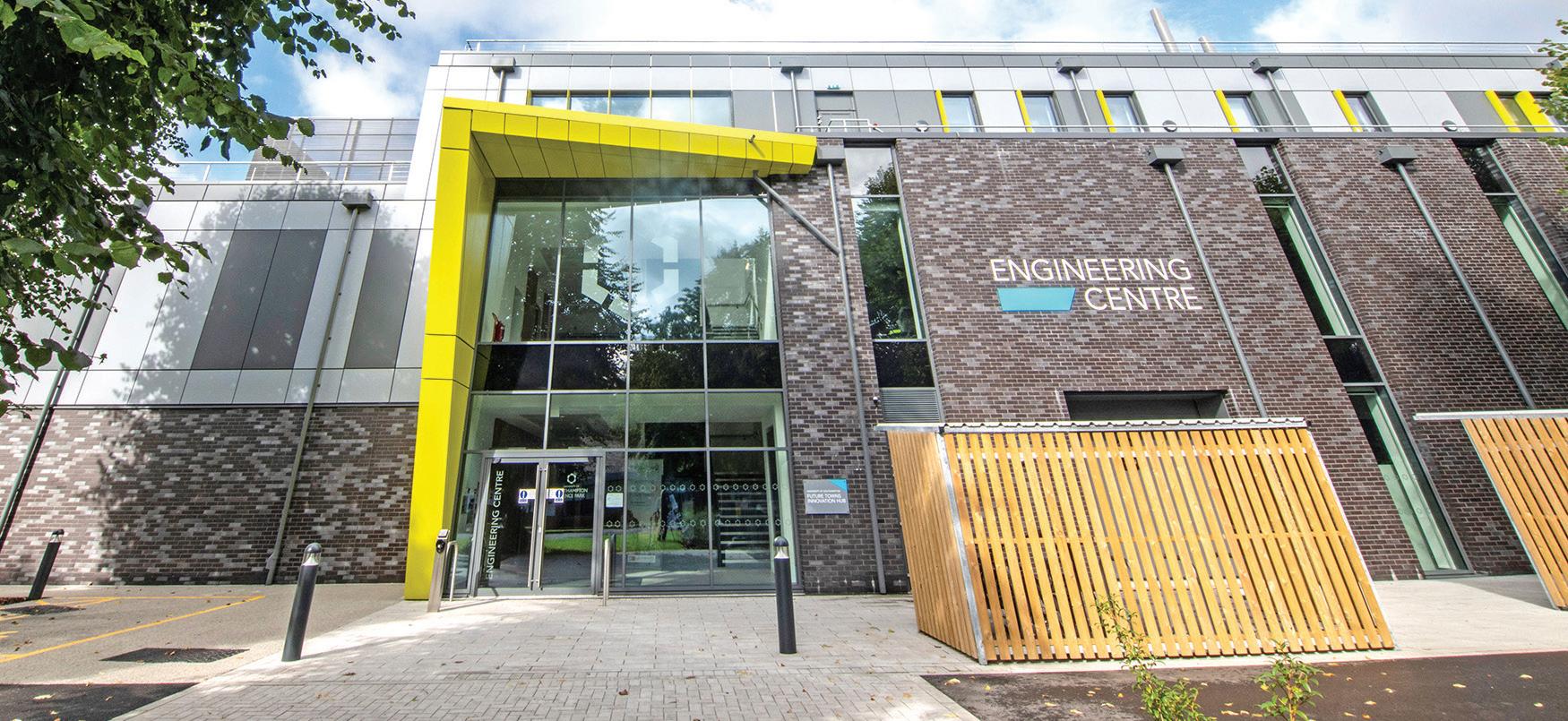
The Engineering Centre is home to the Future Towns Innovation Hub, an initiative led by the University of Southampton.
The Hub will facilitate interactions between business and academia to identify and address impediments to improving quality of life and economic outcomes for the region. Ultimately, it hopes to make our towns happier, healthier, sustainable places to live and work, tackling challenges such as energy efficient housing, connectivity, water conservation, transport, waste management and recycling, as well as contributing to population health and wellbeing. For more visit: futuretowns. soton.ac.uk
In the evolving landscape of business and technology, the decision to invest in IT can make or break an organisation’s success. This choice is not merely about allocating funds to technological solutions; it’s about embracing innovation, enhancing efficiency, and securing a competitive edge.
We asked Tim Walker, MD of Southampton-based Aura Technology to delve into the reasons why investing in IT is important while highlighting the risks associated with neglecting it.

1. Efficiency and Productivity: Integrated solutions streamline processes, automate tasks, and boost productivity. From advanced project management tools to cloud-based collaboration platforms, IT investments enable employees to work smarter, not harder.
2. Innovation: Stagnation is the enemy of growth. Investing in IT allows businesses to innovate and stay ahead of the curve. Technologies like Artificial Intelligence, Internet of Things, and data analytics offer opportunities for new business models, enhanced customer experiences, and optimised decision-making.
3. Data-Driven Insights: In today’s data-driven world, organisations that invest in IT gain a competitive advantage by harnessing the power of data analytics. This enables informed decision-making, accurate market predictions, and personalised customer experiences.
4. Cybersecurity: With the rise of cyber threats, investing in cybersecurity is non-negotiable. Neglecting security exposes organisations to data breaches, financial losses, and reputational damage. Robust cybersecurity measures safeguard information and preserve customer trust.
5. Scalability: As businesses grow, their IT needs expand. Investing in scalable IT infrastructure ensures a smooth transition as organisations scale up.

1. Competitive Disadvantage: In today’s digital age, businesses that don’t invest in IT risk falling behind their tech-savvy competitors. Failing to embrace digital transformation can lead to lost opportunities and decreased market relevance.
2. Inefficiencies and Wasted Resources: Neglecting IT often results in outdated processes, redundant manual tasks, and wastage of time and resources. This hinders long-term growth and profitability.
3. Missed Opportunities: Technology opens doors to innovation. Neglecting IT means missing out on potential breakthroughs, novel business models, and innovative ways to engage customers.
4. Security Vulnerabilities: Cybersecurity breaches can cripple organisations. Neglecting security measures exposes threats that compromise data and damage reputation.
5. Customer Dissatisfaction: Modern customers expect seamless online experiences, quick response times, and personalised interactions. Neglecting IT can lead to inadequate customer service and dissatisfaction.
6. Operational Bottlenecks: Manual processes slow down operations, impeding growth. Investing in IT systems removes bottlenecks creating a more agile and efficient workflow.
While investing in IT offers substantial benefits, it’s essential to strike a balance. Blindly pouring resources into technologies without a clear strategy leads to wastage. Organisations should align IT investments with overall objectives. Conducting thorough research, considering the scalability of solutions, and anticipating potential risks guides informed decision-making.
Embracing digital transformation, harnessing innovation, and safeguarding cybersecurity are just some of the compelling reasons to invest in IT. Organisations that prioritise IT investments are better positioned to thrive, adapt, and lead in a technology-driven world.
Aura Technology uses a consultative approach to develop a strategically aligned technology roadmap, for each client, ensuring well-structured and aligned investments.
If you need advice and help with your IT investment, contact Aura Technology today. auratechnology.com

Held at Reading’s Select Car Leasing Stadium, the awards toasted “shining examples” of the diversity of technology businesses in the Thames Valley. Many businesses that started up in the region are now global leaders in their fields.
Thompson added: “The finalists go from start-ups and scale-ups to very wellestablished veterans of the game.”
The 2023 Thames Valley Tech Awards showcased an impressive line-up of outstanding local businesses across 11 categories.


Reaction Engines triumphed as Thames Valley Tech Company of the Year, while Wireless Logic Group and Brainomix were both double winners.
Richard Thompson, Managing Director of event organiser The Business Magazine, praised the scope of companies in the awards. “We wanted to make sure that the awards ranged across as many fields as possible and truly reflected the diverse nature of tech in the Thames Valley,” he said.
Entries came from software developers, telecoms providers, hardware suppliers and manufacturers, cloud solutions companies, science-based businesses, people working in artificial intelligence, and others working in the field of space technology.
The Headline Sponsor at this year’s awards was Gresham House Ventures and the category sponsors were Boyes Turner, NatWest, EY, BDO, Blake Morgan, Penningtons Manches Cooper, R3VAMP, Trueleads and Hampshire Biz News


Lucy Porter, the comedian, podcaster, playwright and a regular on BBC Radio 4, returned for a second year to host the evening.
On the night, £3,900 was donated by generous guests for SpecialEffect. The Charlbury-based charity helps transform the lives of physically disabled people right across the world through the innovative use of technology.
 Host Lucy Porter
Host Lucy Porter
CYBER SECURITY COMPANY OF THE YEAR
WINNER: Bridewell
SPONSOR: Penningtons Manches Cooper
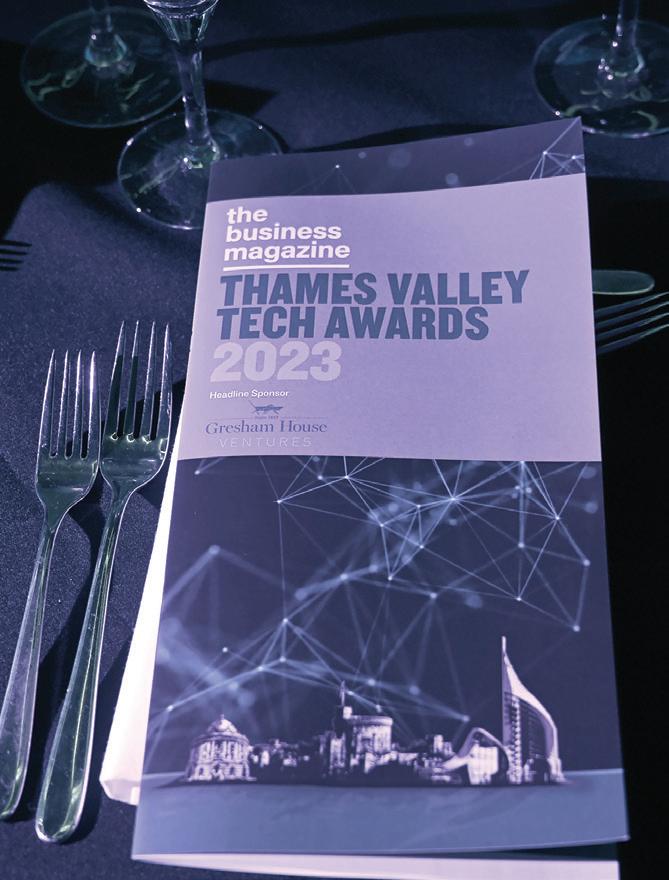





INTERNATIONAL TECH COMPANY OF THE YEAR
WINNER: Wireless Logic Group


SPONSOR: Boyes Turner
INNOVATIVE TECH COMPANY OF THE YEAR


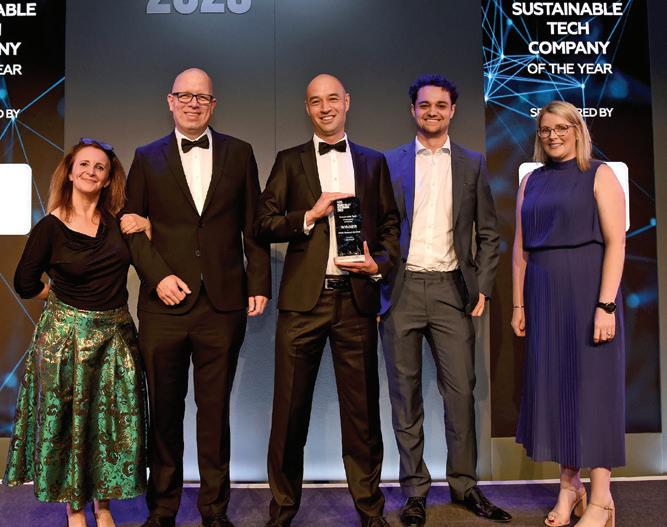
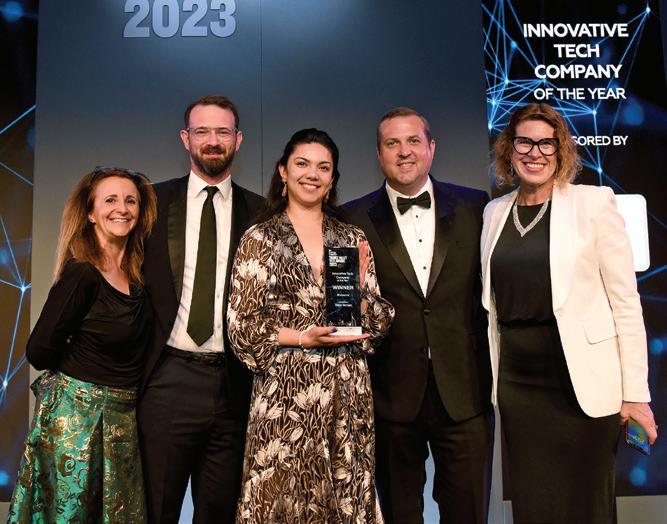
WINNER: Brainomix
SPONSOR: Blake Morgan
SUSTAINABLE TECH COMPANY OF THE YEAR
WINNER: Wirth Research
SPONSOR: BDO







SUSTAINABLE TECH COMPANY OF THE YEAR
HIGHLY COMMENDED: Eden Research
SPONSOR: BDO

EMERGING TECH COMPANY OF THE YEAR

WINNER: SafeToNet
SPONSOR: Trueleads
TECH EMPLOYER OF THE YEAR
WINNER: FSP Consulting Services
SPONSOR: R3Vamp
TECH SME OF THE YEAR

WINNER: measurable.energy
SPONSOR: NatWest
HIGH GROWTH TECH COMPANY OF THE YEAR
WINNER: AVK-SEG
SPONSOR: Boyes Turner
LIFE SCIENCES & HEALTH TECH COMPANY OF THE YEAR

WINNER: Brainomix
SPONSOR: EY
TECH LEADERSHIP TEAM OF THE YEAR
WINNER: Wireless Logic Group

SPONSOR: Hampshire Biz News



TO READ MORE PLEASE USE THE QR CODE BELOW

THAMES VALLEY TECH COMPANY OF THE YEAR

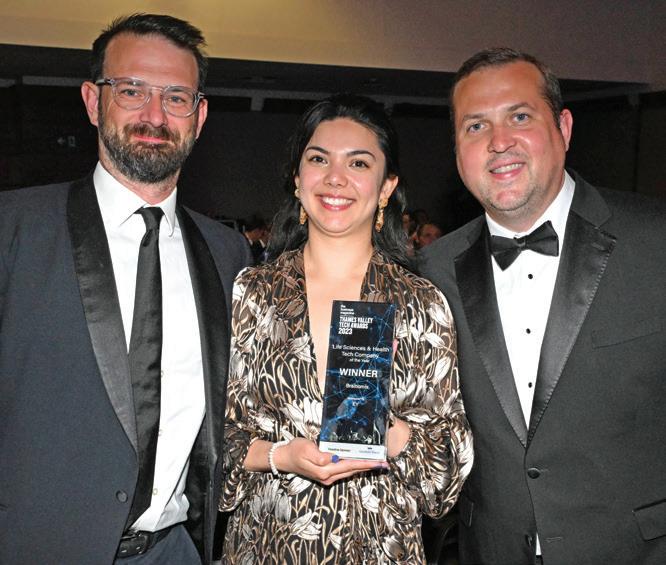




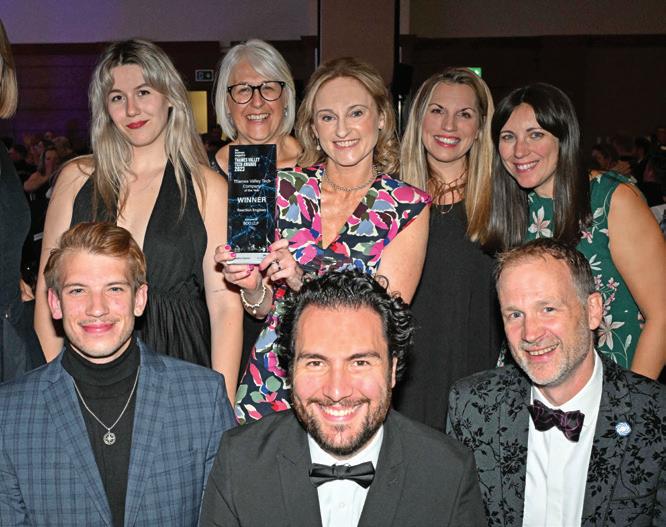
WINNER: Reaction Engines
SPONSOR: BDO


take inspiration from Hunts’ unparalleled collection of leading premium brands and furniture. Visitors can also get expert advice from their in-house design and workspace consultant team.
view, they can sit down, go through the designs and get a clear, tangible feel for how the project is going to look and feel. We’ve also got the technology to create 3D drawings and CGIs to further visualise their creatives.”
Based in High Wycombe, Hunts Office is an independently owned specialist provider of world-class furniture and workplace design. With a highly motivated team and over 30 years of trading, Hunts is continuing its strong history of growth and adapting to industry trends by unveiling its newly refurbished 26,000 sq ft showroom.


As Managing Director and Founder Egon Hunt explains: “It’s always been vital to keep the showroom up to date. As we’ve grown, we’ve refurbished a number of times, with this being the biggest and most innovative overhaul.”

The new showroom, the largest of its kind in the UK, will give visitors the opportunity to visualise new ways of working and
Office spaces have dramatically changed over the last few years. With people working from home it is now all about collaboration spaces, hot desking and privacy areas. Businesses need an environment their employees can enjoy. The showroom has a desk focused officebased area, collaboration spaces, pods for private calls and working and poser height tables to try out.
Egon and the team at Hunts were also determined to create a space that could become a second home for the key stakeholders working on an office renovation, as Egon explains: “Architects, project managers, builders, fit-out firms and other key contacts can bring clients to the showroom and have the facilities, space and technology to work effectively and make creative decisions on-site.
“The showrooms are also up to date with the latest designs and fabrics for you to choose from. The designers come in and really love the space because you’ve essentially got all the manufacturers all in one space. From an architect’s point of
With the new showroom, Hunts has created a truly immersive experience that brings projects to life by combining innovative design with high-end furniture including Steelcase, Brunner, Orangebox, Framery, Boss, Allermuir and many more. As Egon explains: “We are proud of being a Steelcase platinum partner for the last five years. Steelcase are number one in terms of research and development and most of the suppliers in our industry are watching what Steelcase brings out and following suit.”
The High-Wycombe based showroom is very accessible, not only for London-based businesses but also those spanning the Thames Valley and the home counties.
With a division of the business tailored to welcoming walk-ins, all visitors will get the opportunity to talk to an experienced salesperson, whether they have buildings to re-fit or just want to buy one chair.
The best way to get an experience tailored to your project is to book a visit in advance.
Hunts Office unveils the largest purpose-built showroom facility in England, giving companies and the public an opportunity to immerse themselves in the world of office space design.

The Thames Valley is the epicentre of the UK’s IT industry. And sitting at the heart of it, alongside the likes of Microsoft, Cisco and Oracle is Britain’s largest and one of its most successful privately-owned IT companies. Last year it turned over a meaty £3.6 billion.
Westcoast was founded in 1983 by entrepreneur Joe Hemani to distribute global IT brands to resellers, retailers and other organisations across the UK and Europe. It’s Britain’s biggest IT distributor, and employs more than 1,000 people at its head office near Reading and other sites at Andover, Nottingham, Dublin and Milton Keynes.
Drop into any Curry’s, Tesco, Sainsbury’s and many others, and a large proportion of the techie stuff – computers, accessories, mobile phones and the like – will have been supplied by Westcoast.
Entrepreneur Joe prefers to stay out the limelight, but that place is amply filled by Executive Director Alex Tatham, who joined the company in 2009 as Sales and Marketing Director when it was turning over £600 million. Alex has been instrumental, along with a team of dedicated people, in helping Joe take it to infinity and beyond (well, almost).
He left briefly last year to work at NSC Global, for reasons we will return to later, but came back in June, taking up the new role of Executive Director as the company celebrates its 40th year in business.
Interesting facts about Alex: he met his wife on Blind Date in 1988 – they’re still happily married and Cilla was a guest at their wedding. He went to school with two former prime ministers – David Cameron (year below), and Boris Johnson (year above) and still counts them among his acquaintances. He studied Zoology
at Durham University (completing a dissertation on frog muscles), and as an amateur thespian he’s played Lady Bracknell, she of handbag fame in Oscar Wilde’s Importance of Being Earnest.
This was probably the perfect role for Alex, because his personality is larger than life – and in the rather dry world of IT and telecommunications, he stands out.
At the company’s head office in Theale (a huge distribution and sales centre), the sales department covers the whole of the first floor.
Alex, along with Joe, has his desk right at the front – like a friendly headmaster (think Dumbledore). There are no barriers between them and their staff – which must be a bit discombobulating for rookie recruits until they get used to it.
“All our offices are open plan,” he said. “I love the fact that everyone can chat here, and new employees learn quickly. I used to sit with the sales team and if they were having problems, I’d say – let’s phone that person together. We still encourage our managers to do that, it helps create a more egalitarian and flatter structure.”
He’s not a fan of work-from-home then? “I don’t believe it’s as productive, and while thousands of companies sent their staff home during Covid, and Westcoast benefited by supplying them with the technology needed to do so, I prefer it if everyone returns to the office as much as possible.”
Covid was a busy time. “Vast quantities of tech flowed through Westcoast during the pandemic, so much so that government identified us as a critical business, and all
our warehouse workers had to come back to work,” said Alex.
Alex Tatham grew up in London and attended Eton, a time he looks back on with great pleasure. A career in accountancy beckoned, but the advice he received before university was: “Study something you love at uni. If you can talk about something you’re interested or passionate about it comes across well to an employer – no matter what you end up doing.”
Alex took their advice and studied Zoology – and is happy to talk on the subject given the opportunity. The career advice (not his knowledge of frog muscles) he shares often with school and college students.
After university he qualified as a chartered accountant at EY and began training others. Then a friend who had joined an IT distribution business selling data storage asked him to lead its new training business.
“It was before the internet and we beamed training videos via BT satellite to our customers. It cost a fortune, but it was important because in 1995 nobody understood how important technology or protecting data was.”
He moved to Ideal Hardware to run the company’s European sales team. It had been established by three entrepreneurs who had caught the internet wave perfectly, but when they decided to adapt the business to develop software, renaming the company Interx, it hived its profitable £100 million distribution arm, and Alex along with it, to new owners –USA-based Bell Micro.
Alex Tatham is one of the UK tech industry’s most well-known personalities. After a brief stint on the customer side, earlier this year he returned to distributor Westcoast, which over the last 14 years he’s helped grow to a £3.6 billion business
Sadly for Interx plc its software didn’t work and 18 months later the company closed down.
Luckily, Alex was on the right side of the deal. “Even though distribution wasn’t sexy, it was a solid, well-run and profitable business, and the whole situation was a big learning curve for me. The business grew, got sold again, and that’s when I joined Westcoast.”
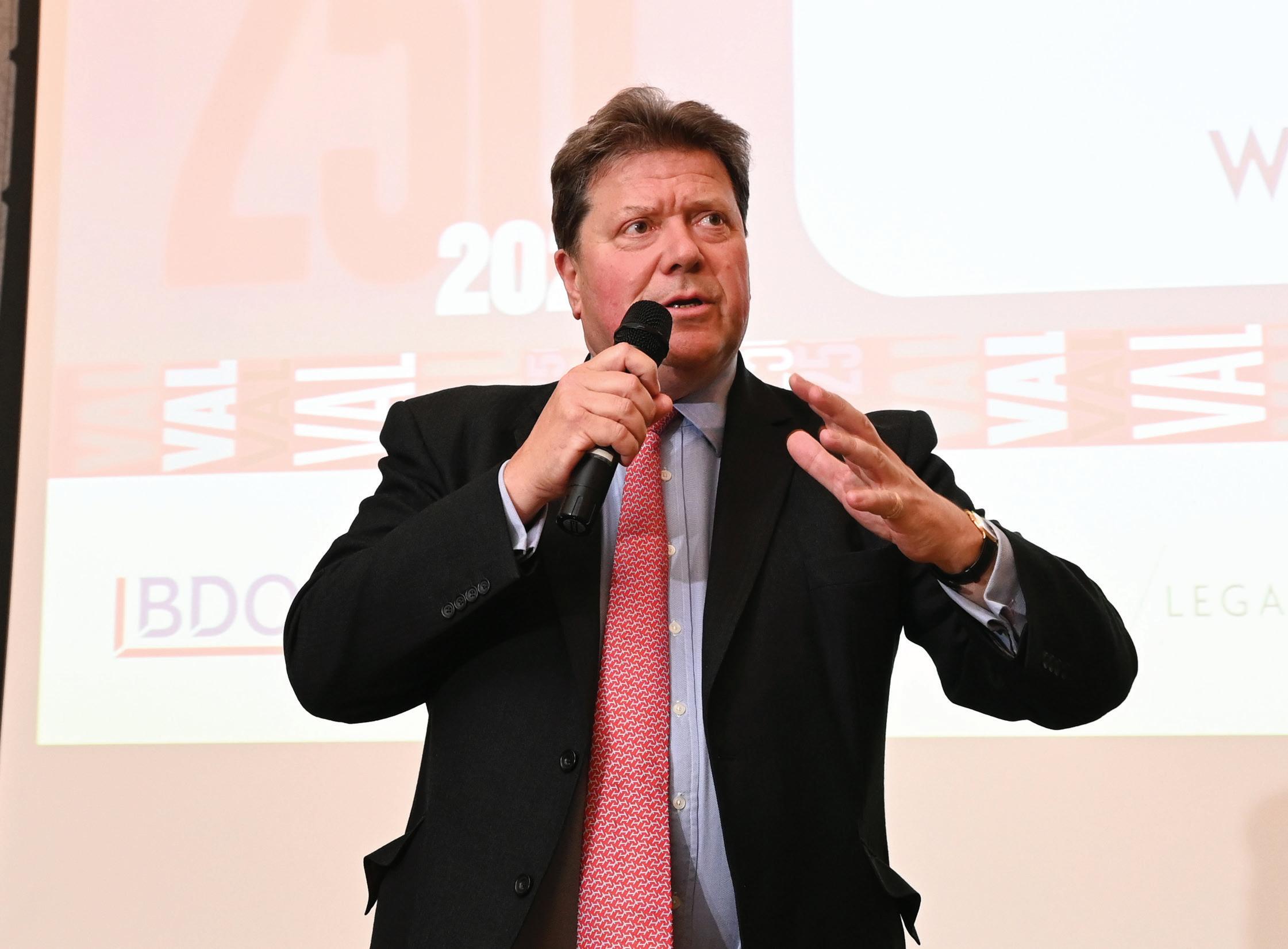
Alex isn’t a true entrepreneur but he’s arguably more valuable because he can bring entrepreneurial ideas to life, and that’s what he’s done at Westcoast.
“Joe likes that creativity. He is one of Britain’s great entrepreneurs and encourages all our people to be brave, innovative and have a go.”
“We have a very solid financial base so Joe can give everyone space to grow. We don’t tell people what to do. We say, here’s the objective, go hit it. He doesn’t tell us how to
hit it, or if it’s possible and my role is to help and advise, but not loom over the team to ask for weekly updates.”
Westcoast is hugely successful, but it has some mighty competition. TD Synnex is a $60 billion USA-based business which is strong in the UK and Europe. Ingram Micro, another US-based company is around $55 billion, most of which is earned in the USA. Then there’s Exertis, owned by Dublinbased conglomerate DCC plc which turned over nearly £4.4 billion in 2021 and has a strong UK business.
“I grew up through sales and marketing and really enjoy the relationship selling that Westcoast does,” said Alex “It’s not a hard sell because most of our customers have to buy from a distributor. The bit I enjoy most is knowing everyone within the IT industry in the UK and beyond. Having that amazing network is what I like best now and what I use best. I’ve got an amazing network because everyone is about my age, and I know them all.”
So why did he decide to move to NSC Global, the global professional services and managed resourcing business?
“We live in London, which is where they’re based and thought I’d like to learn another side of the IT business, I was sad to leave Westcoast, but thought I’d give it a shot.
“Unfortunately, I didn’t enjoy it as much as I thought. Working for a big distribution company such as Westcoast gives you quite a loud voice because you’re engaging with large vendors and distributing their products to customers. As soon as you move to one of the customers, even if they are quite big, you lose a lot of that voice. I missed that. And Westcoast missed that in me too, I think.”
So why not retire (he’s 58 and can surely afford to)? “I like going to work. I like its structure and the extraordinary and slightly enforced social life that work brings on any executive. And I enjoy the IT industry enormously.”
“What makes Westcoast interesting is that we are truly a partner with our suppliers

and customers. We buy whatever we can sell from vendors such as Microsoft or Apple, but when they sell to a distributor they haven’t really sold, they’re just closer to a sale. We are an extension of their business.
“On the other side, there are really only three or four big distributors such as Westcoast from which customers can buy the majority of their technology. One of the biggest things that we do is provide credit. And even if many of them don’t need that finance, they use it anyway.
“As a result, the relationships we have with our suppliers and our customers are true partnerships.”
The future is bright at Westcoast. Last year it bought German firm Komsa to expand its geographical reach. Together the businesses deliver a combined turnover of more than £4.7 billion.

And Westcoast is moving further into
software and networking. “In two years, copper landlines will be switched off,” said Alex. “Two hundred million landlines will need to be digitised, so higher connectivity is needed, people will need more powerful computers with increased storage as more data is being produced. We are also doing much more in the cloud and have a team which manages access to the public cloud on behalf of our customers.
“Most software today is sold on an annual subscription but managing it on a consumption basis, like buying gas or electricity, is more cost-effective and increasingly software companies are offering that. All of that can be managed through Westcoast Cloud.”
Alex is the face of Westcoast and he’s extremely good at it. He also believes strongly in the value of the technology industry in the Thames Valley.
“This region is the heartbeat of the IT industry in this country and this is why we are here along with Microsoft, Oracle and others. We must shout loudly for the region and engaging with government is really important to us.
“Westcoast tries to be a shining example. We go into schools and talk about IT in untechie terms – it puts people on the moon and changes worlds. We try and recruit more women into our sales force. I am a judge on the Women in Technology awards and speak at the conference along with our female managers. We consciously care about it.
“We do have a gender pay gap because those people in our most senior roles are generally men. We know we need to change that and still have work to do, but we are making progress”
“We also engage with schools and regularly invite children in to show them the IT industry. We support the Prince’s Trust and sit on its IT committee.
“We want to be a beacon of hope for the Thames Valley and for the UK as a whole.”
Numbers vary wildly, but according to market and consumer data company Statista, there are around 15.14 billion connected Internet of Things devices –equivalent to just under twice the total number of people worldwide. Other estimates are even higher.

We’ve all heard of the Internet of Things (IoT) but why should it matter to business?
The acronym IoT refers to a network of physical devices, vehicles, domestic appliances, manufacturing equipment and in fact everything that has a sensor or software embedded into it which will allow it to collect and exchange data over the internet.
Here’s how IoT works: IoT-enabled devices are equipped with various sensors (for example, temperature, humidity, motion, pressure), that gather data from their surroundings. That data is transmitted to the cloud (the globally distributed information storage system) via Wi-Fi or other networks. The cloud-
based centralised systems can then process and analyse that information to derive meaningful insights, and then use that knowledge to trigger appropriate actions, automate process or send alerts to users, devices or systems. It’s not always automated, there is often some human interaction or control via web portals or mobile apps.
So it’s Big Brother then?
Well, you could see it that way, or more positively you could acknowledge that for businesses it can improve efficiency and productivity, streamline supply chains and optimise operations, reducing downtime in important equipment.
Make UK, the manufacturers’ organisation, offers the case study of a UK casting manufacturer which uses sensors to enable machine monitoring when the machine is running or idle, and can identify reasons why the machine might have stopped. This helps the manufacturer to improve processes,
machine maintenance and have real time information from several sites.
Another case study highlights a print manufacturer which knows the usage times and consumable levels of its machines and sends replacements for consumables without the need for ordering. As part of this the business can manage upgrades on its own schedule and, based on the data from all machines, predict when maintenance will be required and schedule accordingly. This allows the company to sell the ‘service’ rather than the product to its customer.
IoT sensors can continuously monitor product quality and ensure regulatory compliance. They can also help with energy efficiency by regulating lighting, heating, cooling and other systems, based on real-time data, resulting in reduced energy costs and environmental impact.
We’re already using the Internet of Things daily. But do any of us really understand its scope?
For individuals it also has big benefits, particularly in medical monitoring. In July the government announced a big expansion in its “virtual wards”.
Virtual wards (also known as “hospital at home”) allow patients to get hospital-level care at home in familiar surroundings, helping speed up their recovery while freeing up hospital beds.
Just as in hospital, people on a virtual ward are reviewed daily and cared for by a multi-disciplinary team. The “ward round” may involve a home visit or take place through video technology. Many virtual wards use apps, wearables and other medical devices enabling clinical staff to check and monitor a patient’s recovery, all connected by the Internet of Things.
Customer engagement and personalisation is also improved using IoT-enabled devices, although some people can find this intrusive – you may not wish others to know your whereabouts or preferences, and while the benefits for businesses and individuals are massive, there are
justifiable concerns relating to personal and professional data security and privacy – and the threat of hackers, all of which have to be taken seriously.
This summer, it was reported in some parts of the media that an increase in the numbers of Chinese-manufactured cars being bought and driven in the UK could pose a security risk if their software was capable of being remotely monitored.
Could the Chinese authorities press the stop button? That could see all cars imported from there judder to a halt on UK roads and motorways, while Teslas and other Western-manufactured electric vehicles accelerate past? Unlikely probably, but perhaps not impossible.
There are technical challenges too. How do IoT-connected devices interact through the cloud and therefore with each other? Could the way one operates stop another from working? And is the Wi-Fi connection strong enough? For some industries this is key. A logistics company sending vehicles into rural areas may struggle to access
essential location and delivery data. In the city too, problems are being reported. This summer, autonomous taxis clogged up San Franciso’s streets, delaying emergency vehicles. Connectivity issues could have been caused by a large music festival putting too much strain on the local network, so cars couldn’t be rerouted remotely.
To reap the rewards of the Internet of Things while being mindful of any privacy and security threats, all IoT-enabled devices must be secure and comply with data protection regulations.
Companies wanting to roll out an IoT strategy need to identify what they want to achieve for their business.

This could include increasing safety and security, reducing costs and energy usage, improving productivity and data analysis and increasing revenues.
The general answer is to identify your objectives and if you don’t have in-house expertise, find someone who has.
The Thames Valley 250 awards celebrated the region’s leading businesses at a special dinner held at Easthampstead Park, Wokingham. The companies in this year’s listing employ over 122,000 people and generate a turnover of almost £31 billion.

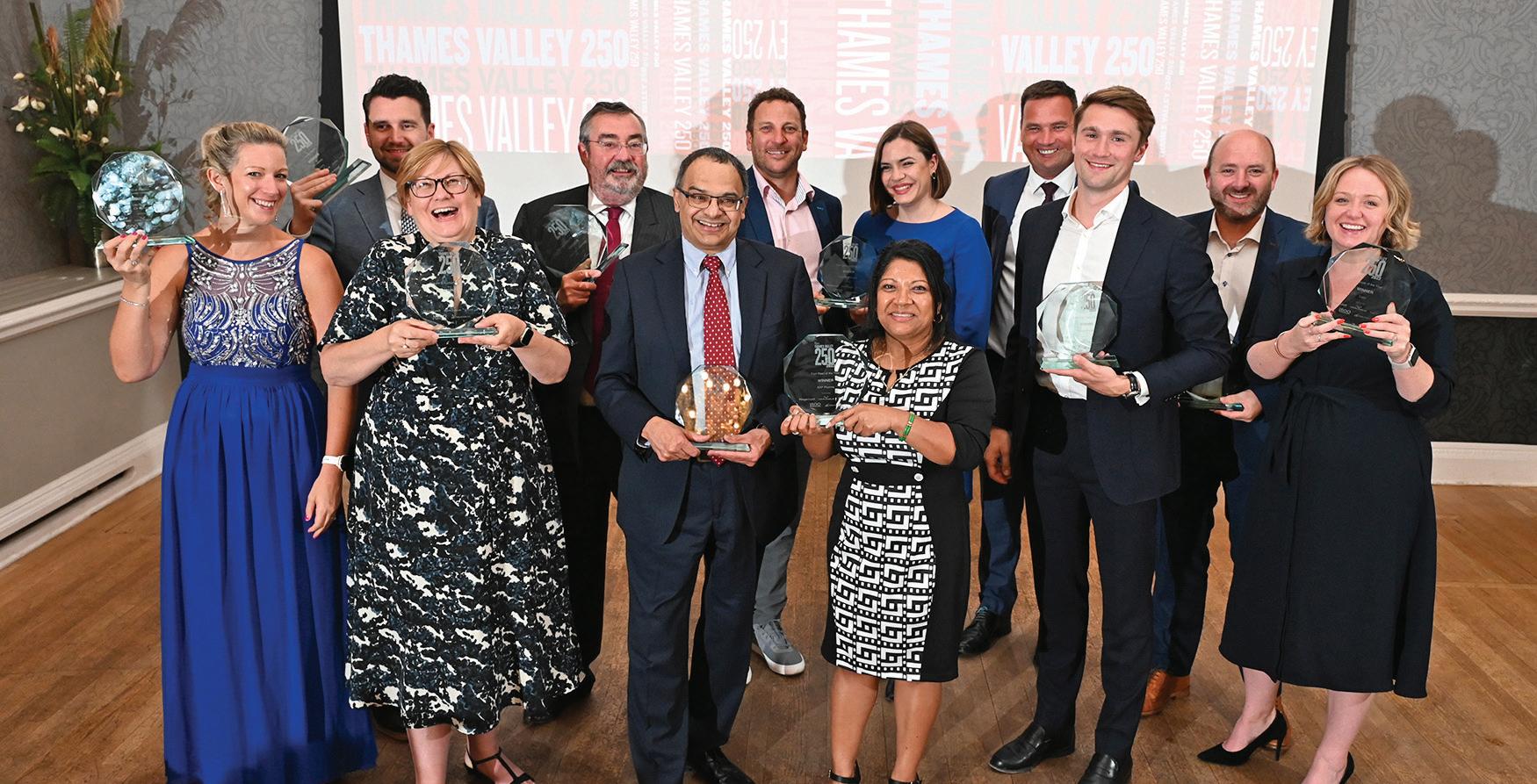
The Thames Valley 250 comprises the top privately-owned businesses (by turnover) headquartered in the region, which is defined as Oxfordshire, Berkshire, West Surrey, North Hampshire and parts of Buckinghamshire.

Guest speaker Alex Tatham made a welcome return to the TV250 community, having re-joined the listing’s number one company, Westcoast, as Executive Director in June 2023 after a year at NSC Global. Alex had previously been with Westcoast for 15 years.
IT distributor Westcoast generated turnover of £3.65 billion in 2022 and celebrates its 40th anniversary this year. Alex observed that back in 1983, founder Joe Hemani started the business by buying 1,000 laser printers and “selling them before he had to
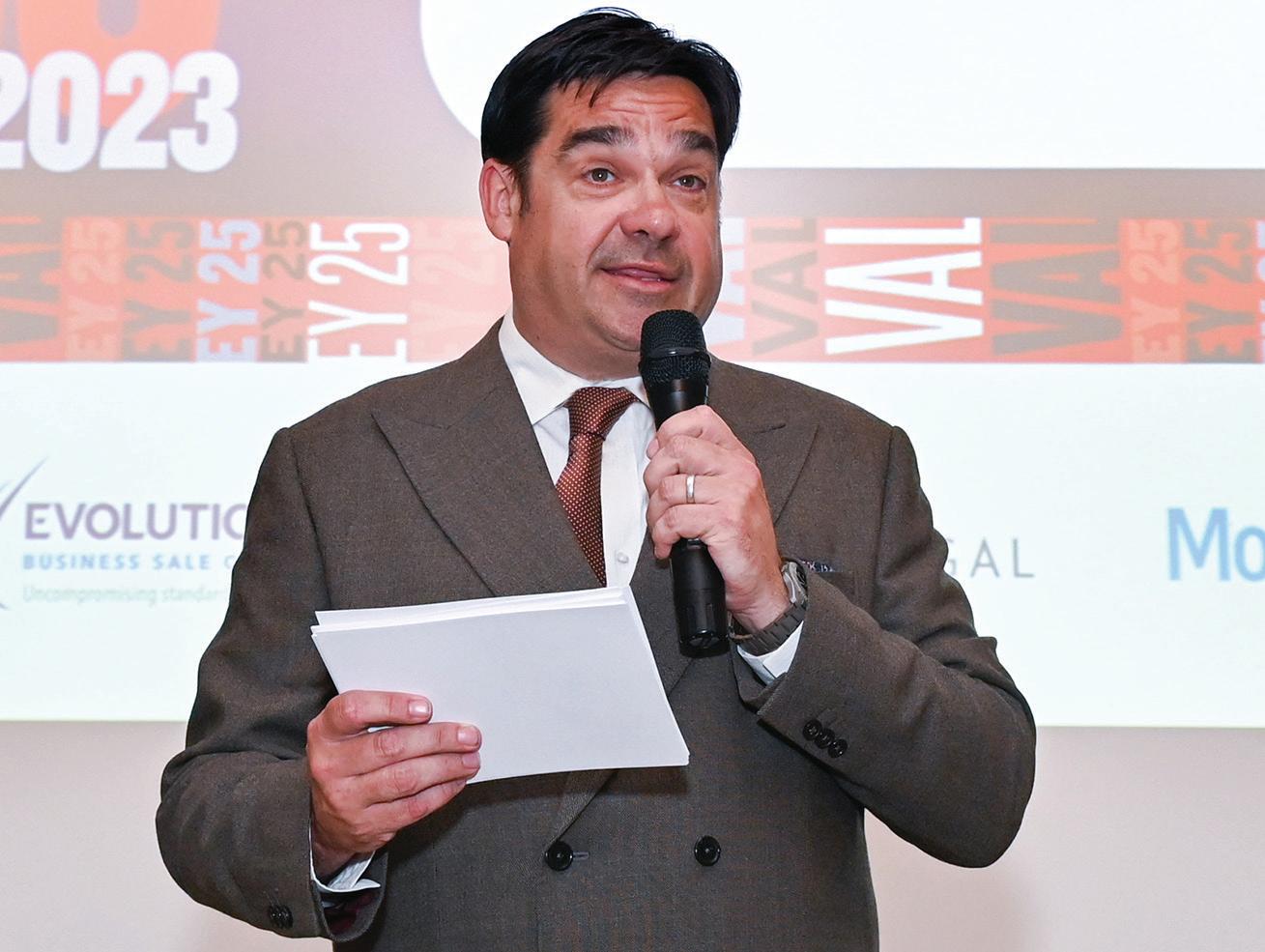
WINNER: LEE BIGGINS, CV-LIBRARY
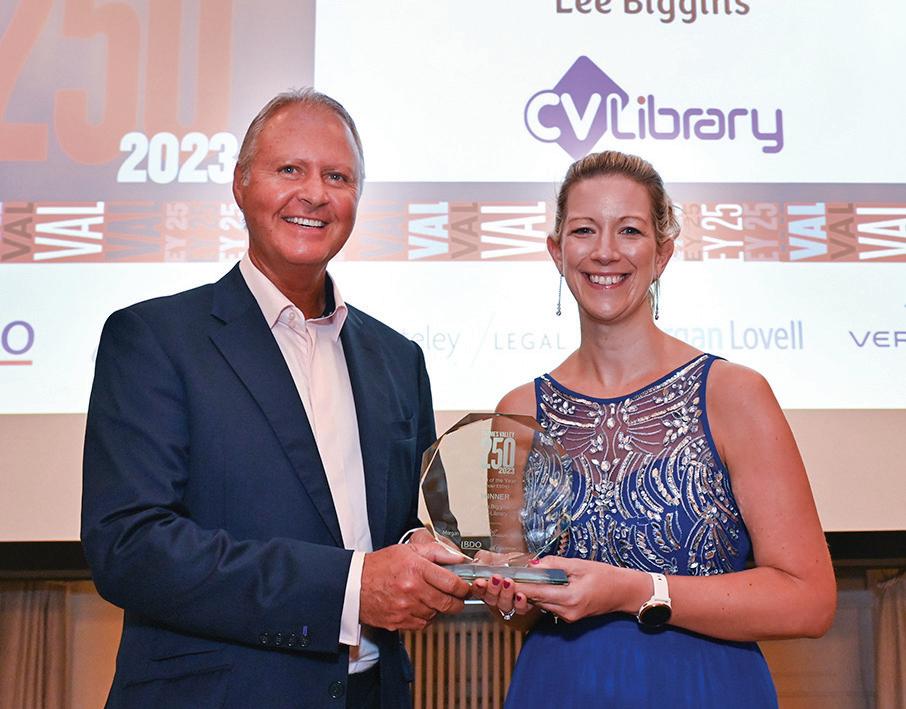
Lee founded CV-Library in 2000 with Brian Wakem and today the Fleet-based company is one of the UK’s leading independent online recruitment platforms. It lists more than 18 million CVs and advertises over 190,000 jobs from nearly 10,000 companies. The company was named by Megabuyte as one of the UK’s best-performing privatelyowned technology companies in 2022.
FINALISTS:
Neil Pizzey, Amazon Filters | Chris Pritchard, AVK/SEG
WINNER: HUNTSWOOD
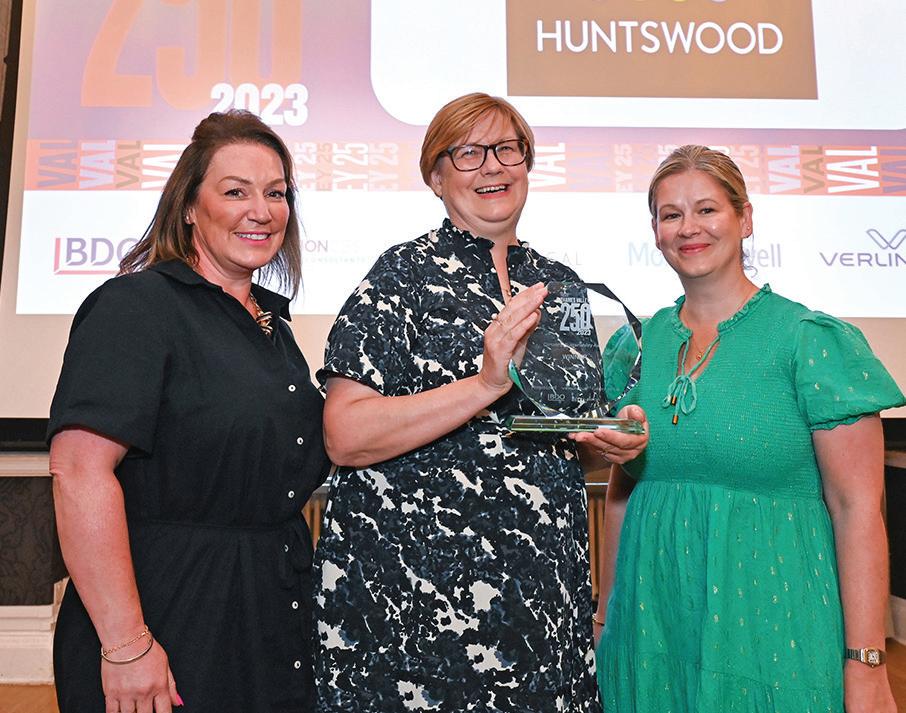
For over 25 years, Reading-based Huntswood has been providing resourcing, outsourcing and advisory services backed by a well-established commitment to corporate social responsibility. The company takes pride in actively campaigning and fundraising for local community causes. It encourages employees to use one working day a year to volunteer in charitable activities that benefit others.
FINALISTS:
Redwood Technologies | RH Amar
WINNER: WIRELESS LOGIC GROUP
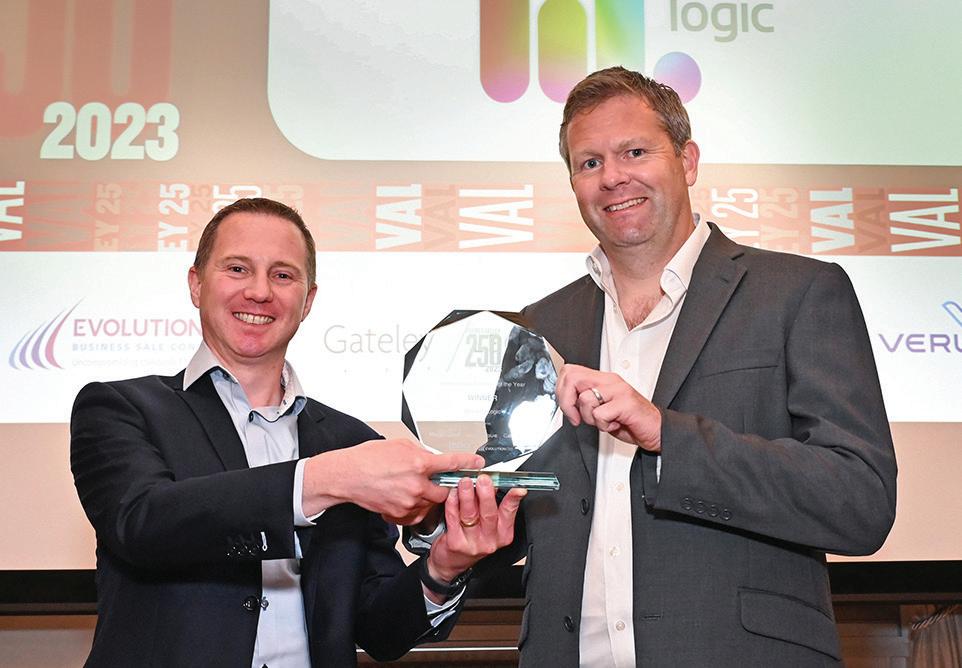
In the past year, Wireless Logic acquired Singapore-based Blue Wireless to strengthen its global coverage in Asia Pacific and the US. Established in 2000 by Phil Cole and Oliver Tucker, the acquisitive Maidenhead-headquartered company also bought virtual network operator Mobius and business communications specialist Jola in the UK. The connectivity and airtime provider serves all market sectors.
FINALISTS:
Blue Sky Intermodal | Lucy Group | Owen Mumford | Rebound Technology Group
WINNER: BASHIR PARKAR, BAP PHARMA
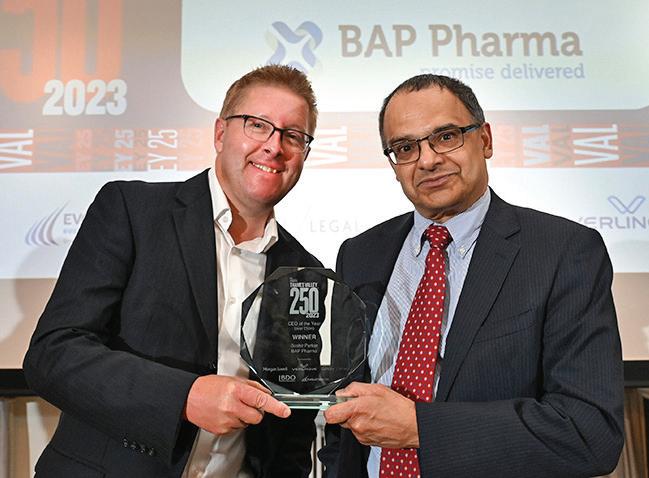
Bashir established BAP Pharma in 2011 with a wealth of pharmaceutical and healthcare industry experience. The Marlow-based clinical trials supply, secondary packaging and medicines access company is certified as an Ethnic Minority Businesses. In 2021, it was ranked the 97th fastest-growing international sales company in the UK in The Sunday Times HSBC International Track 200.
FINALISTS:
Sean Taylor, Redwood Technologies | Simon Thake, Rebound Technology Group
WINNER: CIPHR
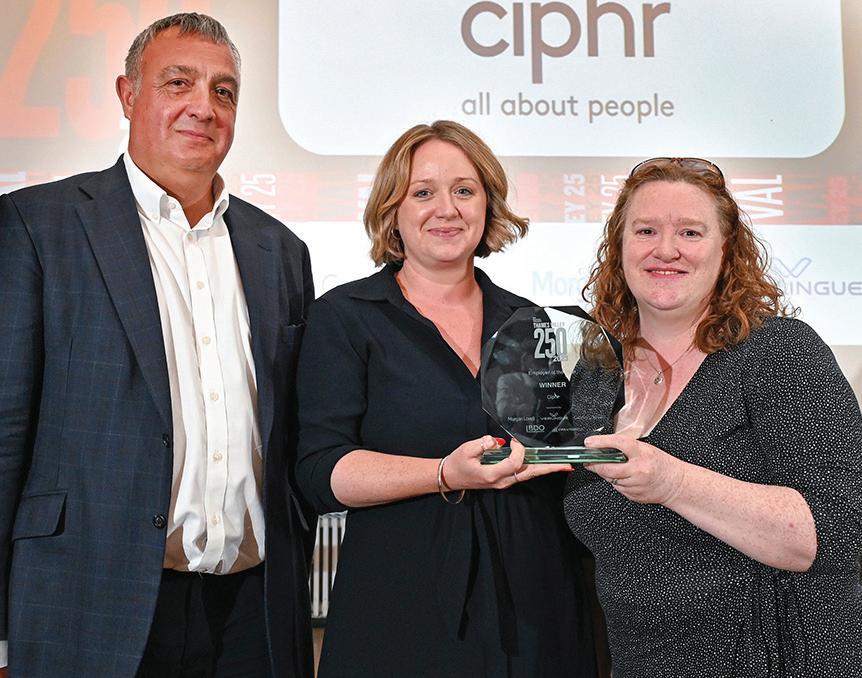
As it expands its workforce, Marlow-headquartered online HR, payroll and recruitment provider Ciphr is placing a strong emphasis on offering its people a supportive, inclusive and flexible work environment plus a range of benefits. With a strong commitment to developing talent, Ciphr encourages employees to take on challenges while it takes on board their business-improving ideas.
FINALISTS: CV-Library | Huntswood | Owen Mumford | RH Amar
WINNER: SAPPHIRE BALCONIES
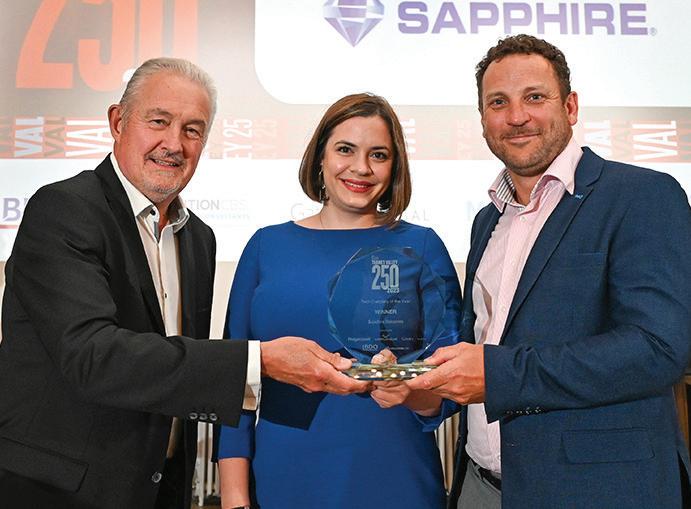
Reading-based Sapphire Balconies represents the pinnacle of obsessive innovation and design optimisation in its field. For them, the definition of ‘technology’ extends into systems, design, materials, installation and aftercare and support. With people at the heart of what it does, every team member contributes to innovation in sustainability, product efficiency and optimisation of the installation process.
FINALISTS: AVK/SEG | CV-Library | ESP Global
WINNER: BAP PHARMA
Marlow-based BAP Pharma is expanding globally and entering a period of investment and development that will see it expand in US and European markets. A leader in clinical trials supply, secondary packaging and medicines access, it was ranked in 2021 as the 97th fastest-growing international sales company in the UK in The Sunday Times HSBC International Track 200.


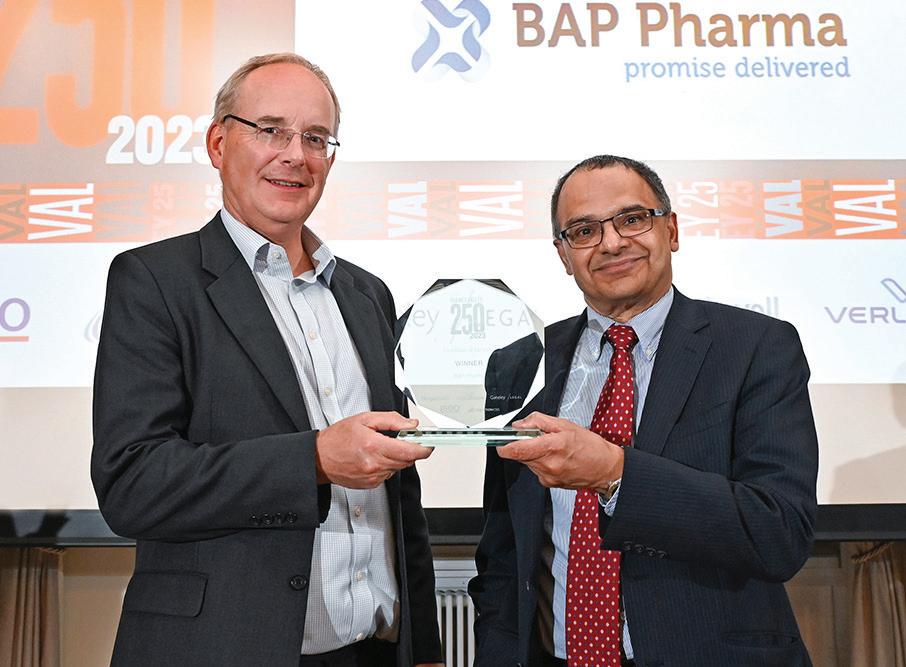
FINALISTS:
Elivia Homes | Rebound Technology Group | Rectory Homes


WINNER: BLUE SKY INTERMODAL

Headquartered in Marlow, international marine container leasing company Blue Sky Intermodal provides financing for containers and related equipment to the container industry. The company also trades old and new containers for use in secondary and domestic markets. Blue Sky has expanded its global operations at offices in China, Hong Kong and the US, with agency offices in five other countries.
FINALISTS:
BAP Pharma | Lucy Group | Rebound Technology Group
WINNER: CV-LIBRARY
Established in 2000, Fleet-headquartered CV library has become a well-known and dominant player in the recruitment sector with over 18 million CVs listed and more than 190,000 jobs advertised. With impressive online capabilities and analytics, it helps job seekers find the right job and businesses find the right people in the UK and globally.
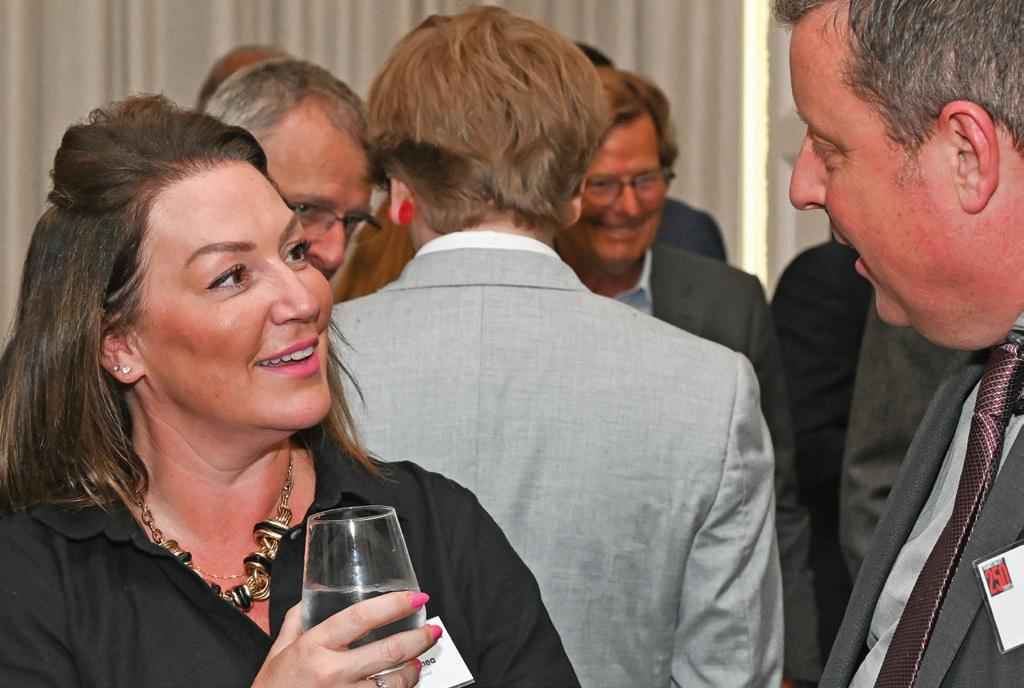
FINALISTS: Amazon Filters | AND Digital | Drinks21
WINNER: RECTORY HOMES
Simon Vickers, owner and chairman of Haddenhambased Rectory Homes, and his leadership team bring many years’ experience in residential development to deliver the highest quality in all aspects of house building. They ensure site selection, planning, design, specification, construction and aftersales services are all exceptional. The team has built a strong industry reputation for its developments across the region.
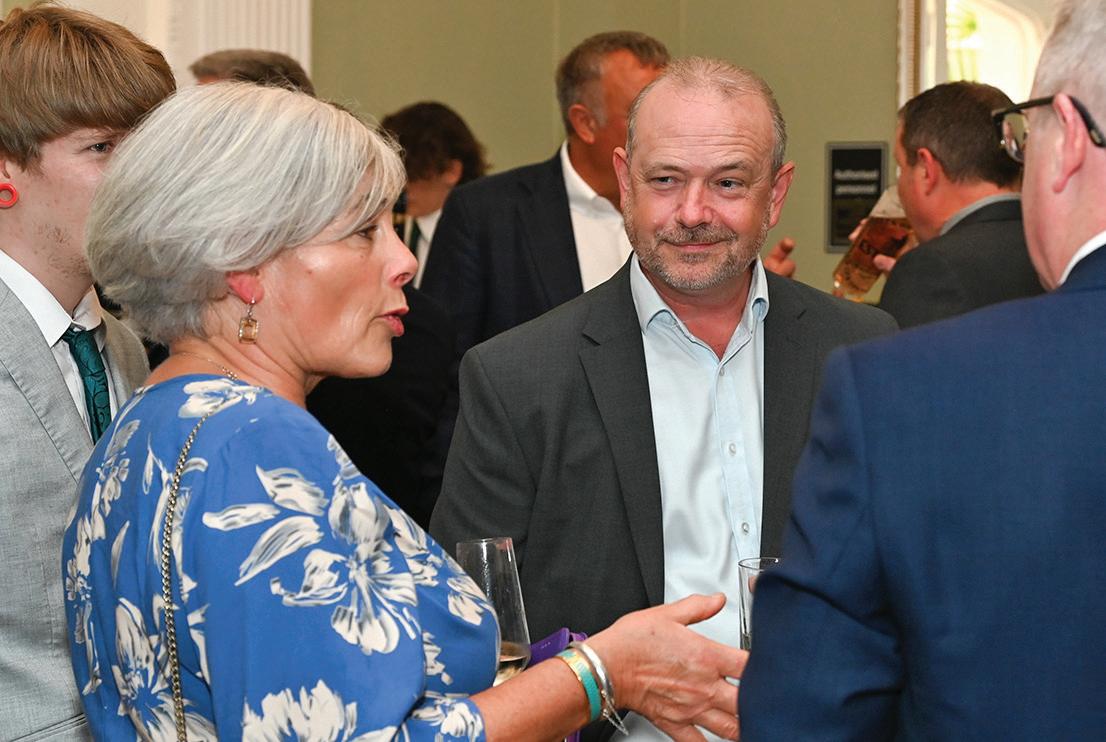
FINALISTS:
AVK/SEG | BAP Pharma | Elivia Homes | Thomas Homes | Westcoast
The Thames Valley 250’s 2023 CEO of the Year delivered what the award judges described as “unbelievable results”. His Marlow-based company, BAP Pharma, also scooped the Fast Riser award, writes Tim Wickham.

Speaking with CEO and founder Dr Bashir Parkar, it’s not hard to see why the TV250 judges were so impressed. Starting a business and taking it to a £340 million annual turnover in just 11 years is certainly a stand-out achievement.
“When I started in 2011, the business plan I presented to the banks showed we would attain a £200 million turnover by 2020 but they didn’t believe me,” he notes with a wry smile.
Dr Parkar estimates the global market for comparator medicines in clinical trials is worth around $3 billion. So, there’s plenty of room to accommodate BAP Pharma’s future growth plans.
One price to pay for such relentless growth is the unwanted attention it attracts. Every time the company publishes its financial results Dr Parkar is inundated with calls from private equity companies and boutique houses. “They ask me if I want to sell the business, which I don’t,” he says.
Another financial headache for BAP Pharma is a cashflow challenge. “Customers usually have 90-day payment terms, while suppliers don’t necessarily give us that much time.
It is more like 30 days. We have a good relationship with our bank, who extends loans to us which hit our profit margins.”
Big pharmaceutical companies are both customers and suppliers. BAP Pharma sources market-leading products that they all need when conducting trials of their own new pipeline medicines. BAP Pharma works with both sides.
For such a busy company, a tour of the ambient storage and refrigerator-laden warehouse within its Marlow head office is an eye-opener – as there isn’t much to see.
“We do not hold stock for long periods as we only buy and sell on demand. It is a quick in and quick out model,” Dr Parkar explains.
BAP Pharma’s impressive growth trajectory is set to continue with two new divisions recently added, which are expected to contribute significantly to the core business.
One of the new divisions relabels and repackages pharmaceutical companies’ drugs for use in clinical trials. BAP Pharma has operations in the US and Germany that handle this.
Dr Parkar says one of his best business decisions was to set up in mainland Europe before Brexit. Due to the impacts of Brexit, the flow of medicines to and from the UK and Eurozone has posed one or two challenges, which BAP have been able to overcome.
“We foresaw the negative impact of Brexit on our business in terms of getting EU clearance to move products around. We purchased a facility in Germany to ensure we had everything in place when Brexit happened,” he said.
The other division sources medicines that don’t yet have licences. “Pharma companies are often busy with research and development and when they receive an unsolicited request for unlicensed medicines, they often outsource this activity.”
By doing this, BAP Pharma supports unmet medical needs around the world. For example, patients who don’t qualify to be on a drug trial but whose physicians feel they would benefit from them. Or giving patients uninterrupted access to medicines during the period between a drug trial finishing and a licence being granted.
BAP Pharma has plenty of competitors and some are much larger. Dr Parkar believes it has a competitive advantage by offering high levels of customer service. “We go the extra mile, especially delivering on time for clinical trials, with the correct documentation.”
Another distinctive attribute is respect for both customers and colleagues. This outlook is coupled with a results-focused business ethos based on a ‘Promise Delivered’ philosophy.
In the ultra-secretive world of clinical research, BAP Pharma has a hard-won reputation for trust in handling medicines and their documentation. This is particularly important as pharmaceutical companies spend billions of pounds on research and development and maintaining confidentiality is very important.

There is a restlessness about Dr Parkar as he constantly looks for new areas to take the business forward. You notice a lot of empty seats in the Marlow office. The same goes for its offices in the US and Germany.
“The three new large offices that we have acquired are part of our future growth plan so there is plenty of room for expansion,” he explains.
BAP Pharma serves both large and small pharma companies and the new divisions will be particularly attractive to some of the smaller biotech companies, who feel they don’t necessarily get the same attention from larger pharma companies. “BAP always says every customer is important to us,” he says.

Dr Parkar is also looking further afield. China is probably next. An acquisition is a likely route as he believes the Chinese government is becoming more flexible in
its views on foreign ownership of Chinese companies. In the longer term, he has his eye on Latin America and India.
Despite its broadening global reach, the company is keen to keep roots in the Thames Valley, having previously moved from Slough to Marlow. “We like it here and there are a lot of pharmaceutical and biotech companies based in the region,” says Dr Parkar.
When BAP Pharma was established, Dr Parkar used his vast experience in the industry gained from working in a number of different roles – from warehouse to project management to quality assurance. He praises his hand-picked senior management and middle management teams, who are equally committed to the business. So is the 100-strong workforce. He is closely involved in recruitment decisions to ensure everyone buys into the company’s ethos and values. This includes a strong commitment to diversity in the workforce.
Having previously worked at companies in the clinical trials services sector, Dr Parkar knew what the best approach would be in setting up BAP Pharma. Helping to launch a division for an employer that reached £35 million turnover within two years gave him
the confidence to set off alone at the age of 51.
He invested his life savings in BAP Pharma, much to his wife’s concern. She needn’t have worried as within the first nine months, Dr Parkar was successful and turned over a profit, which is rare for a new start-up business.
He says he is his own worst critic. “I constantly ask myself if I could have done things better and the answer is always ‘yes’. On the whole, he feels he has been quite cautious – “If I had taken more risk by recruiting more staff sooner, then the company might have grown faster, but you never know.”
Looking ahead, he envisages a point will come when he exits the business, but doesn’t know when that will be. Possibly via a management buy-out or a private equity buyout. “I would have to consider what is in the best interests of the company, our staff and customers.”
He will be content to walk away completely. “I’ll use the money to focus on philanthropic activities and to invest in other growing businesses.”
We go the extra mile, especially delivering on time for clinical trials, with the correct documentation
Not many companies go from zero to a £110 million turnover in three years. However with the right opportunity, people and execution, Lanes-i has shown that it is possible.
The Guildford-based firm is a success story of the construction contracting industry, having tapped into the surge in demand that followed the opening up of BT Openreach’s network by Ofcom in 2016.
The Ofcom ruling saw a flood of new operators, including Cityfibre, Giganet and HyperOptic, building new fibre optic networks across the UK using original Openreach infrastructure.

Lanes-i, one of the UK’s fastest-growing utility infrastructure providers, had four employees in 2020. In its first year it pulled in £16 million, turned over £68 million in 2021 and now expects its turnover to be more than £110 million this year.
It is an offshoot of wastewater utility solutions provider, Lanes Group, headquartered in Leeds, itself the largest independent drainage specialist in the UK.
Lanes-i has now moved into a new office in Guildford and employs 1,000 people with a 50/50 split between contractors and payroll workers.
Managing Director David Roberts said: “When I was working with CityFibre on their roll-out I noticed that the contractor pool was very limited.
“There was so much work here and it was such an opportunity. I thought that if we could create a company that can take what Lanes Group does really well for the water industry and offer it to the telecoms industry then it would be well received.”
David has worked in construction since leaving school and one of his first jobs was
working
The Channel Tunnel development sucked skills and expertise down to Kent, meaning he was quickly promoted and gained experience across all sides of the business including commercial and contracts management.
He then went to work for a management consultancy before going out on his own as a consultant for 17 years.
He said: “I’ve always been optimistic and followed my nose. I got into construction because I liked heavy machinery and didn’t really want to work in an office.”
Lanes-i has followed the approach taken by its parent Lanes Group of rejecting conflict,
Roberts says the growth of Lanes-i is down to a commitment to professionalism
instead favouring a partnership approach and that is one of the reasons, says David, behind the company’s rapid growth rate.

He said: “Construction is known for conflict which I think is ridiculous and a waste of energy.
“We utterly reject that philosophy. Everything is about partnering and doing the right thing. If you deliver on your promises in good faith, people will be happy.”
A company’s culture can be initiated from the top. However, for it to be enacted at every point of a transaction, it comes down to people and this can only be achieved if the management team is fully bought in. David said: “If I hire you to do something, why would I tell you how to do it? I would rather judge you by the results that you deliver, how happy your team is, how many of them are leaving and how well you are managing that team.
“I was trusted when I started out and I want to find someone to eventually replace me. I want to nurture our management team but give them enough space to do what they do best.
“Command and control is no way to grow someone.”
David says his own management style is at odds with what you would expect to see in the construction industry.
He said: “I see no point in shouting and
screaming at people. No one goes to work to deliberately make a mistake. I have tried to create an atmosphere where people know my door is always open.
“I try to be as approachable as possible and smile a lot. I don’t want to be the ogre in the office that everyone should be scared of.
“As a managing director you have to be a constant, no matter what you are feeling.”
Brexit and Covid have led to an acute shortage of skilled construction workers with many in the trade now trying to tempt workers in from other professions.
David said the pressure on recruitment is now easing as we move further away from the pandemic. hHowever problems remain.
He said: “There is a phenomenal demand for infrastructure work at the minute, so labour is in short supply and skilled labour, in particular, is an increasingly rare commodity.
“There is no use whining about it, you have got to meet it head on by setting up your own training schools, investing in training and taking people out of the industries that they are in.
“One of our friendly competitors has had some success in getting nail technicians to become fibre splicers. They are used to
working on close detail which is ideal for jointing fibre optic cables that are not much bigger than a human hair.”
Lanes-i has an impressive record when it comes to staff retention with its attrition rate at a third of the industry average.
This, David says, it’s down in no small part to the company putting its staff welfare front and centre.
“This industry is based around word-ofmouth. People know how much you pay, if you pay on time and how they will be treated,” he added.
“All our construction teams have MercedesBenz Sprinter vans with on-board toilets, they have good equipment and the right protective gear.
“We give people a career path. They can come in as an unskilled labourer, perform well and then go up another pay level after a certain period of time.”
The government has set a target for completing the fibre roll-out to 85 per cent of homes by 2025 and the firm is turning its attention to what comes next.
The eradication of new petrol cars from the UK’s forecourts by 2030 and proliferation of electric vehicles is an opportunity where David thinks Lanes-i is well placed to capitalise.
He said: “I think we will still be picking up fibre works beyond 2030. The target for the government was 2025 and it could still happen, but it will be very challenging. There is a lot of hard-to-reach housing that won’t be connected without subsidy, for example”.
“We are moving into power as we believe that it is an industry that needs our culture and ethos to get things done.
“There is a big energy requirement and we are interested in connecting large facilities to the grid.”
Twenty years ago, in 2003, high speed rail – something Japan has been enjoying since the mid-1960s – finally arrived in the UK with the opening of the first part of High Speed 1, the Channel Tunnel Rail Link between London and the South Coast.
Finally speeds of up to 300 kph (186 mph) were available on British railways.
Six years later, in 2009, the Labour government unveiled plans for High Speed 2. The plan was to reduce journey times between London and the Midlands and north, as well as freeing up capacity on the rail network.
But public objections to the route and the upheaval the work would cause – as well as the eye-watering cost of the project –meant it wasn’t until 2017 and 2021 that the two acts of parliament that would make HS2 a reality received Royal Assent.
Since then the proposed network has been cut substantially. Plans to link HS1 and HS2 – providing a high speed rail link between the north, the Midlands and the continent were dropped at an early stage. In 2022 the government announced that the eastern leg connecting Birmingham to Leeds and York would be dropped.
Meanwhile work is finally under way on a less ambitious, less costly HS2. Phase 1, which connects London Euston and Birmingham Curzon Street, is due to be completed by around 2031. For
passengers departing from the north, the next high speed train from Manchester Piccadilly is expected to depart by 2033.
It’s worth noting, though, that HS2 is still Europe’s largest infrastructure project and includes civil engineering projects that would have Victorian railway forebears lifting their stovepipe hats in celebration.
Four new stations – Birmingham Curzon Street, London Euston, Interchange at Solihull, and Old Oak Common in West London linking HS2 with the Elizabeth Line and the Great Western Main Line – are being built. Each promises to unlock land for housing and employment.
Sixty-four miles of dedicated high speed rail tunnel are being constructed in five separate locations along the route, which cuts through Warwickshire, Oxfordshire, and Buckinghamshire.

Eleven miles of viaducts and bridges are
being built across valleys, rivers, roads and flood plains. There will be 500 new structures by the time the project is completed.
And the network will be serviced by 54 bullet trains which, the government insists, will be designed, built and maintained in the UK.
Some of the biggest names in civil engineering have formed consortiums to carry out the work. Household names like Balfour Beatty, Kier, Sir Robert McAlpine and Skanska are all involved.
And the project has created thousands of jobs – 30,000 at the last count across 350 sites.
Those sites include a manufacturing plant at Kingsbury, Warwickshire where 2,742 huge concrete segments which will be used to build the Delta Junction are being produced.

If the journey to a high speed rail network seems a long time in the making, plans to reduce congestion at one of Britain’s mostvisited tourist attractions has taken even longer.
It was in 1994 that English Heritage first mooted the idea of returning the landscape around Stonehenge to its natural state. The much-maligned collection of 1960s pre-fab buildings with toilets, a snack bar and a gift shop would be dismantled. A new visitor centre would be built a mile and a half from the stones with tourists shuttled to the monument by a fleet of Land Rovers. It would – pledged English Heritage – be open for the dawning of the new millennium.
Meanwhile, the busy A303 – a single carriageway road connecting private cars, and freight traffic, and – especially during the summer months – thousands of holidaymakers from London and the M3 to the M5 to Devon and Cornwall, would pass through a tunnel, giving visitors to the UNESCO World Heritage Site a traffic and smog-free view of the stones.
Among the vocal supporters were Rollo Maughfling, Archdruid of Stonehenge and Britain.
The £27 million visitor centre finally opened in 2013, while plans to divert the A303 through a tunnel have faced so many heritage objections, legal challenges and budget row-backs that it makes the original civil engineering project of dragging
bluestones from the Preseli hills in Wales to the middle of Salisbury Plain seem relatively straightforward.
The latest, as of July, is that the tunnel plan – that’s the £1.7 billion 2020 plan, not the 2013 plan, the £540 million 2007 plan, or the £183 million 2002 plan, or the 1994 plan – is back on again.
The 2.1-mile tunnel is just part of a larger civil engineering project that will include bypasses, viaducts and flyovers.
The plans would alleviate at least one of the bottlenecks on the A303, the length of which is currently around two-thirds dual carriageway and one-third single carriageway.
Relieving the traffic would make good economic sense according to the government. Time is money, and lorries in traffic jams are doing no one any good. National Highways says the journey time past Stonehenge could be reduced from “as much as an hour” to eight minutes.
There would also, it is argued, be public safety benefit – A303 bottlenecks are notorious accident hotspots, especially during the summer months.
National Highways has appointed an international consortium including FCC Construcción (Spain), WeBuild (Italy) and BeMo Tunnelling for the roadbuilding and tunnelling schemes. Some of the work is
likely to be subcontracted to SMEs in the region.
Meanwhile, the contract for quantity surveying, cost consultancy, and contractor liaison was won by London-based Mace.
National Highways says the work will be carried out in a way that is sensitive to the needs of the environment and the cultural heritage of the area.
Wiltshire Council, which backs the plans, says the project will support 21,000 jobs and boost the region’s economy by £9 billion.
But historians remain horrified at the idea of digging a tunnel through what is now understood to be a far wider archaeological site than was realised in 1994.
Popular historian Tom Holland, who grew up in the area and is president of the Save Stonehenge World Heritage Site campaign group, said: “At the best of times this would be a grotesque decision, but at a time when the country is faced with so many bills, such a financial shortfall, this desecration of a World Heritage Site is the height of folly –an act of vandalism that shames Britain.
And although the project currently has the green light, objectors are currently “exploring avenues” to legally challenge the government’s decision again.
Like the lorries on the A303 on a good day, this one rumbles on.
In the Kent countryside, the UK’s largest solar and battery storage project is under way.

Formerly known as the Cleve Hill Solar Project, Quinbrook Infrastructure Partners – who acquired the scheme from Hive Energy and Wirsol Energy – renamed it Project Fortress.
The scheme, which has been awarded Nationally Significant Infrastructure Project status, is anticipated to become the largest single-site solar PV installation in the UK once it goes live at the end of 2024. It will have three times the generating capacity of Britain’s current largest solar site.
It is expected to generate enough renewable power each year to meet the power needs of more than 100,000 UK homes and help reduce carbon emissions by 164,450 tonnes every year.
The huge scale of the project is set to provide a meaningful contribution to improving energy security for the United Kingdom and further decarbonise the power grid, helping to progress the country’s journey to Net Zero.
The scheme is expected to support more than 2,300 direct and indirect jobs during the project’s lifetime and generate more than £148 million in local socio-economic benefits. Quinbrook says it wants local companies to be involved in the
construction and operations supply chain.
With 880,000 solar panels across a 900 acre site at Graveney Marshes near Faversham, the solar farm will generate 373 MW of power and store 150 MW.
Rory Quinlan, co-founder and managing partner of Quinbrook, said: “High energy prices, geopolitical instability and the UK’s ambitious Net Zero goals are bringing into focus the critical need to accelerate the building of the next generation of energy transition infrastructure in the UK.
“In our view, large scale solar with battery storage projects are key to achieving the decarbonisation imperatives of the energy transition the world over and we are doing our best to create a blueprint for more projects to come here in the UK.
“Just as importantly, we are committed to doing this in a way that is truly impactful in supporting jobs and delivering a range of tangible benefits to the local community.”
New solar projects are cropping up all over the region.
In Dorset, renewable energy company Voltalia has officially marked the opening of South Farm Solar Park near Spetisbury.
It was the first Power Purchase Agreement (PPA) of its kind in the UK to be signed directly between a renewable energy
producer and a public authority, The City of London Corporation.
Meanwhile, a planning application for a solar farm in Guston, submitted by Greentech, has been approved by Dover District Council.
Electricity generated at the 19 hectare site will be enough to power 7,000 homes and offset 10,000 tonnes of carbon dioxide.
And the most powerful solar farm in the UK, with the ability to power more than 330,000 households, could be built on the famous Oxfordshire estate of Blenheim.
If permitted, the planned Botley West Solar Farm would be able to supply the National Grid with 840 MW of cheap, clean power – theoretically enough energy to run every home in Oxfordshire.
Electricity generated at the 19 hectare site will be enough to power 7,000 homesThe 900 acre Project Fortress site at Graveney Marshes near Faversham
A roadbuilding scheme on the Hampshire/ Dorset border has been nominated for a major environmental award for its work in minimising the ecological impact of the project.
When the National Highways’ A31 widening project at Ringwood was opened in late 2022, it was done so with the knowledge that creatures as diverse as bats and Atlantic salmon had been considered.
National Highways decided to combine the widening and bridge replacement schemes to reduce the overall disruption that would have been caused by having two separate projects.
Works on site started in March to widen the westbound A31 from two lanes to three between the Ringwood and Verwood junctions and included the removal and reconstruction of two bridges over the River Avon and Bickerley Mill Stream.

Replacing the bridges was a complex task, carried out over a number of phases. Contractor VolkerFitzpatrick removed the bridges, originally built in the 1930s, in sections using a 750-tonne crane, one of only seven in the country which stood at 60 metres tall.
The bridges were then dismantled and cut into pieces before being removed from site. The foundations for the new bridge supports were laid and beams for the new decks, measuring 45 metres in length were installed.
Once the new beams were in place, construction of the new decks began.
Due to the works’ close proximity to the river, the team worked with The Environment Agency and Natural England, to minimise the ecological impact of the project on the local habitat.
The planning phase incorporated mitigation measures to protect bats living in the area and the presence of spawning
Atlantic salmon meant the works were carefully scheduled around their migration season, between May and October. Pontoons on the rivers throughout demolition also ensured no debris entered the watercourse.
In the British Construction Industry Awards the scheme has been nominated for both Environmental Project of the Year and Transport Project of the Year.
Meanwhile, Hampshire County Council has awarded the contract to design and build an £81 million upgrade to junction 10 on the M27 to VolkerFitzpatrick.
The upgrade will pave the way for a planned 6,000-home Welborne Garden Village development and the new one million sq ft Welborne Science & Technology Park which will be the largest
new employment scheme along the South Coast, supporting nearly 6,000 new jobs.
The upgrade involves the provision of a new motorway underpass to the west of the existing M27 Junction 10, three new slip roads, and the construction of a new dual carriageway to link the new slip roads to the existing road network.
In March 2022, Hampshire County Council and Fareham Borough Council welcomed news of an award of £41.25 million of Housing Investment Grant by Homes England.
This will go towards the upgrade of Junction 10, which will make a substantial contribution to the overall cost of the scheme with the remaining £40 million being provided by the Welborne developers.
“In the British Construction Industry Awards the scheme has been nominated for both Environmental Project of the Year and Transport Project of the Year”
Oxford Brookes University is building a new £60 million sustainable campus at Headington Hill.

The construction contract has been awarded to Willmott Dixon.
Designed by ADP Architecture, the buildings will provide a new home for the Faculty of Technology, Design and Environment at the university’s Headington Campus.
Sustainable, flexible spaces for students, staff and researchers have been created following stakeholder consultation.
A social core at the heart of the threestorey teaching building will help informal learning, encourage engagement and promote wellbeing, the university says.
Alongside this, the purpose-built engineering workshop is designed to sit comfortably within the parkland conservation area of Headington Hill.
Jerry Woods, director of estates and campus services at Oxford Brookes University, said: “The new labs, workshops, teaching and social learning spaces will be transformational for our Faculty of
Technology, Design and Environment. Together, the new teaching and workshop buildings will help our students, staff and researchers to flourish, boost local collaboration and meet the needs of business.

“It will also support the move of our remaining activity on the Wheatley Campus and play a key role in the university’s longterm estate vision.
“This facility will provide Oxford Brookes University with innovative facilities that allow their students and staff to meet the future requirements of industry and entrepreneurism.
“The sustainability credentials of this building indicate Oxford Brookes’ forwardthinking approach.”
Meanwhile, Willmott Dixon has won the contract to deliver a £57 million ultra-lowcarbon secondary school in Burgess Hill, West Sussex.
The 900-pupil secondary school will serve families living in the 3,500 new homes at Brookleigh and the wider Burgess Hill area.
It will be part of one ‘all-through’ primary and secondary school on two sites, named The Bedelands Academy.
West Sussex County Council has committed nearly £40 million of funding to the project in what is the council’s single largest school investment in the last decade. Homes England is contributing around £18 million in developer contributions and the land.
schools and colleges are being built across the South EastOxford Brookes’ Headington Hill Campus
A new facility built from recycled materials that aims to educate beach-goers on the importance of recycling has been nominated for a British Construction Industry award.
The £2.4 million Environmental Innovation Hub is at Durley Chine, one of Bournemouth’s internationally-recognised Blue Flag beaches.
The highly-insulated, Passivhaus-certified, timber-framed education, welfare and exhibition space was commissioned by Bournemouth, Christchurch and Poole Council, designed by Footprint Architects, and constructed by WSP.

Some of the key features include a structure of reclaimed groyne timbers, a living roof canopy of native plants, decking from a decommissioned German submarine base, newspaper insulation and a kiosk completely constructed from locally sourced sand.
The aggregate was inspired by the local geology of the cliff, using cement substitute throughout the structure.
With around 2,000 tons of waste removed from its beaches every year, the hub will be a centre of focus for Bournemouth, Christchurch and Poole Council’s efforts to educate and change behaviour along the seafront.
The project aims to contribute towards the council’s ambitions to become a green economy leader by helping to significantly reduce single-use plastics and increase recycling along the coastline. The building opened its doors in February.
Meanwhile, on the other side of The Solent, the first steps have been taken to protect the eastern coast of the Isle of Wight from the ravages of the weather.
The environment agency says more than 3,000 homes and nearly 800 nonresidential properties on the island are at risk of flooding or the effects of coastal erosion.
Upgrading the sea defences could cost more than £50 million of government money. At the start of the year the Environment Agency began ground
investigations at two of the four beaches – Shanklin and Yaverland – to assess the condition of the sea walls.
The 900-metre Shanklin and 600-metre Yaverland coastal defence schemes are partnership projects involving the Environment Agency and Isle of Wight Council. The delivery partners are JBA Consulting and Volker Stevin.
As the climate crisis brings stronger, more frequent storms communities are having to act to protect shorelines.
In Brighton, 110 cylindrical reinforced concrete breakwaters have been constructed around Brighton Marina, while the cliffs are constantly being monitored to prevent landslides.
In Dover, East Kent Engineering Partnership worked with contractors Breheny Civil Engineering and Chunnel Group to deliver an £800,000 rock groynes scheme.
At Folkstone, contractors use heavy plant to haul shingle from east to west twice a year to prevent longshore drift.
Construction projects aim to protect beaches from the ravages of storms... and man
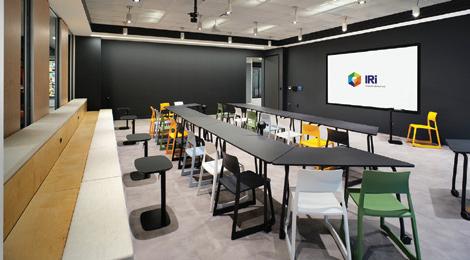

From inclusive havens prioritising empowerment and wellbeing, to futuristic tech playgrounds, the Thames Valley is the destination for cool tech and forward-thinking multinational businesses. But what kind of workplaces are these companies creating for their staff to thrive? We’ve identified five types of innovative workplace styles that are fuelling creativity and driving growth across the region.
THE INCLUSIVE OASIS - With an unwavering focus on employee inclusivity, this workspace welcomes all with open arms. The inclusive haven offers facilities like quiet rooms, accessible spaces, gender-neutral facilities and sensory zones. Integrating principles of universal design, the space ensures everyone feels valued and empowered, promoting collaboration and enhancing overall comfort.
PROJECT SHOWCASE | THREE
UK’S Reading workspace is dedicated to valuing each individual; featuring Braille wayfinding, DDA-compliant tea points and genderneutral facilities. Custom lighting controls, neuro-diverse considerations and a lively social quarter underscore the commitment to inclusion, wellbeing and a sense of belonging.
THE COLLABORATIVE HAVEN - Breaking down traditional barriers between departments, this office emphasises collaboration and teamwork. With its open plan layout, cosy breakout areas and shared spaces, it fosters a culture of communication and idea-sharing, nurturing a strong sense of community.

PROJECT SHOWCASE | MORGAN LOVELL at Maxis 1 embraces diverse work styles with dynamic zones for quiet focus, energetic engagement and versatile meetings. The commitment to collaboration shines through open sightlines that knit the ‘ML community’ together, while flexible spaces and innovative breakout areas fuel interaction and idea sharing.
THE GREEN TECH HUB - This revolutionary office prioritises sustainability and environmental consciousness with features like motion sensor lighting, solar panels and natural ventilation. Its open and airy spaces filled with natural light create a refreshing and inviting atmosphere.

PROJECT SHOWCASE | CAMPUS READING sets a new benchmark for working. It’s a collaborative, amenity-rich office community focused on
sustainability and wellbeing to entice fresh thinking businesses. Accreditations include:
1. WiredScore Platinum
2. ActiveScore Gold
3. BREEAM Excellent
4. EPC B certifications
5. Targeting WELL Platinum
THE FUTURISTIC WORKPLACE - Aimed at tech-savvy and creative minds, the futuristic workplace is an interactive and fun-filled office. It features the latest gadgets, VR/AR setups and gamified workstations, encouraging employees to experiment, explore and collaborate in a playful environment.
PROJECT SHOWCASE | IRI’S tech-powered workspace blends tech and creativity. Small casual rooms complement large tech-enabled training and conference areas, featuring cutting-edge AV and conferencing. This futuristic workplace blends work and socialising, spotlighting advanced tech for seamless collaboration.
THE HERITAGE BLEND - Combining historic architecture with modern functionality, the heritage blend is an adaptive reuse of traditional buildings. It preserves the region’s heritage while offering contemporary office spaces tailored to the needs of modern businesses.

PROJECT SHOWCASE | NEWBURY BUILDING SOCIETY’S office transformation stands as a testament to harmonising new agile dynamics with its strong existing culture. After 40 years in the same space, their new workspace seamlessly integrates traditional and collaborative areas, striking a balance that respects individual workspaces while fostering organic interactions.
Explore more of the Thames Valley’s innovative and inspiring office buildings that fuel creativity and drive ground-breaking ideas with morganlovell.com.
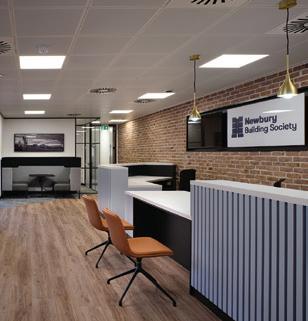
Walking past, or working in, a beautiful building lifts the mood. A building should sit well within its environment, be practical and energy-efficient


and most currently under construction or recently built are all three. We look at some of the best across the region
By Nicky Godding, EditorThree UK in Green Park, Reading, designed by Morgan Lovell. An inclusive office design that showcases Three UK’s core values of connectivity, diversity, inclusivity, belonging and wellbeing. It personifies their view of the world as a ‘continuous canvas of connected moments, experiences, people and opportunities.



F51 Sports Park, the world’s first multistorey skatepark, is ocated on a traffic gyratory in Folkestone. Funded by local philanthropist Sir Roger De Haan, it provides a space for young people to enjoy sport. Designed by Hollaway Studio.


Morgan Lovell at Maxis, Bracknell: is an office designed for a changing world. A SKA Gold, tech-enabled destination its employees love and a place where Morgan Lovell clients can imagine their own workplace of the future.

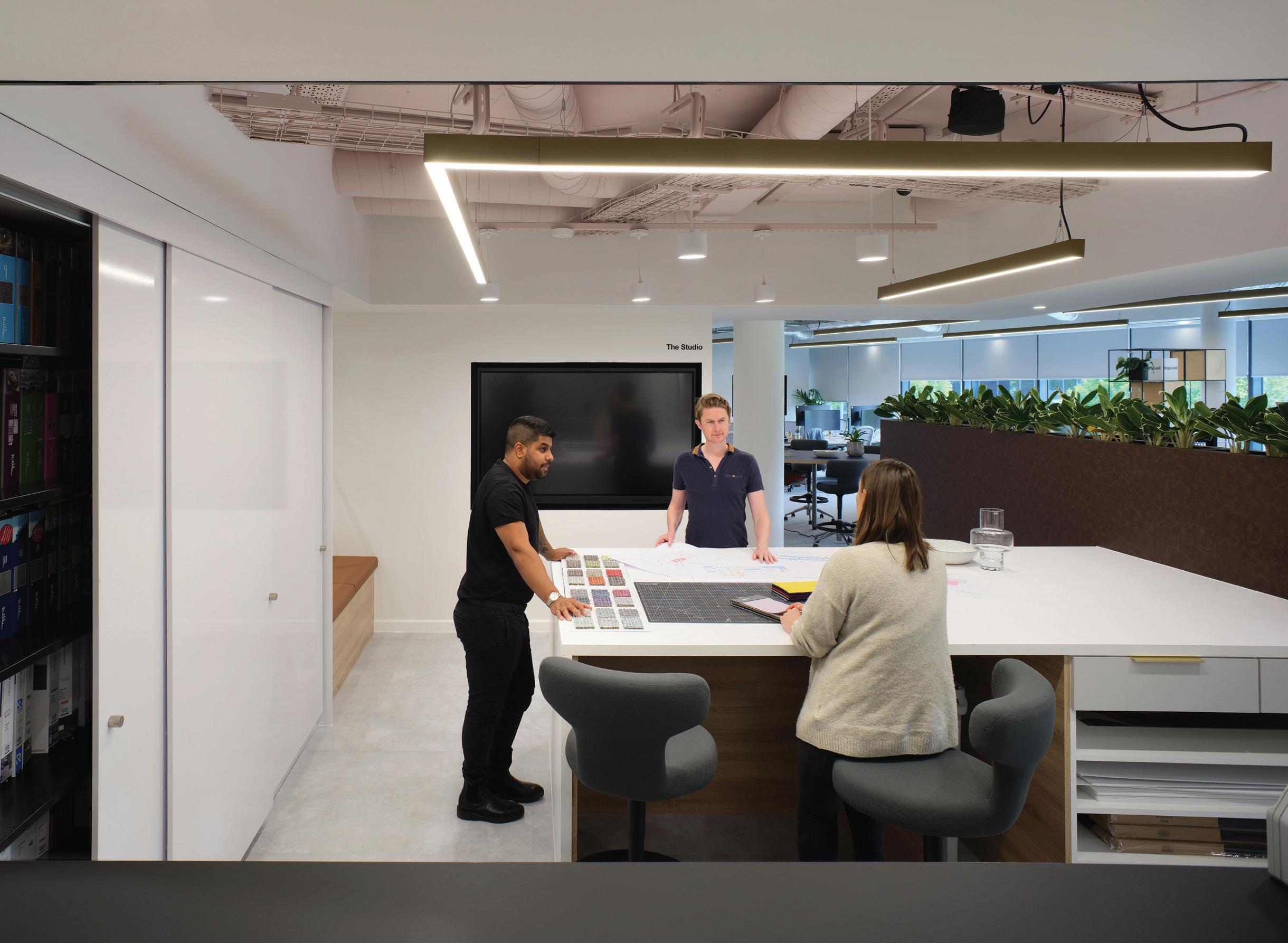
The Vishuddha Centre in Oxford looks small but houses a well-equipped studio, changing rooms and a social area connecting to a peaceful garden. The building showcases innovative technological solutions to minimise consumption of fossil-fuel. Designed by Adrian James Architects. Photography Fisher Studios



St Hilda’s College, Oxford has been transformed by two new buildings reconnecting the college with its beautiful riverside setting. Architects Gort Scott.



RHS Hilltop at Wisley Surrey is the home of gardening science and cost £35 million. It was the largest ever investment in horticultural science.

Designed by Wilkinson Eyre.

Winchester Sports and Leisure Park is located in an existing sports park next to the University of Winchester sports stadium. The design focuses on bringing light and views into the centre to enliven each space and connect it to the wider site.

Bayside, Worthing provides 141 homes, restaurant, and commercial units next to Worthing’s esplanade and beach. The development, for Roffey Homes, is located at a key point along the seafront where the town centre gives way to residential properties. Architects Allies and Morrison. Photograph credit Tim Crocker


Barton Farm Primary Academy
Winchester is a new school in for 420 pupils aged from 4 to 11 years. The school, part of the University of Winchester Academy Trust, first opened in 2020 amid the Covid-19 pandemic.




South East edition: Oxfordshire & Thames Valley Berkshire & Buckinghamshire
Surrey, Kent & Sussex
Solent & South Coast
South West & West Midlands edition: Gloucestershire, Bristol, South Gloucestershire Worcestershire & Hereford, Coventry & Warwickshire
The Cotswolds, Swindon & North Wiltshire
The region’s most influential B2B magazine, in print and online for news, features, interviews and business sector analysis.
2023 Print issues will be published in January, March, May, July, September and November
NEXT ISSUE: NOVEMBER 2023
Contact us
Managing Director Richard Thompson richard.thompson@black-ox.com
Managing Editor Stephen Emerson stephen.emerson@black-ox.com
Operations Director Jo Whittle jo.whittle@black-ox.com
Visit our magazine online thebusinessmagazine.co.uk
Follow us: @TheBusinessMag linkedin.com/company/the-business-magazine
Magazine Design: Origin Creative I www.origin-creative.com
Magazine Printers: The Manson Group I www.mansongroup.co.uk
Editorial
Print Editor Nicky Godding nicky.godding@black-ox.com
Deputy Editor Pete Davison pete.davison@black-ox.com
Events
Head of Events Lauran Webb lauran.webb@black-ox.com
Event Manager Dan Teuton dan.teuton@black-ox.com
Researcher Laura Clarke laura.clarke@black-ox.com
Events Executive Ashleigh O’Shea ashleigh.oshea@black-ox.com
Events/Sales Executive Lauren McCarron lauren.mccarron@black-ox.com
Marketing
Marketing Manager Rory Hinton rory.hinton@black-ox.com
Junior Digital Marketing Scott Whittle scott.whittle@black-ox.com
Commercial Head of Client Relations Peter Laurie Thames Valley peter.laurie@black-ox.com
Business Manager Alan Lindstrom South Coast alan.lindstrom@black-ox.com
Business Manager Kirsty Muir West Midlands kirsty.muir@black-ox.com
Media Sales Manager Alexandra Scrivener South West & West Midlands alexandra.scrivener@black-ox.com
Events/Listings events@black-ox.com Accounts finance@black-ox.com
General Enquiries thebusinessmag@black-ox.com
Publisher: Black Ox Ltd – Company number 13202910
Registered Office: 24 Bell lane, Blackwater, Camberley, Surrey, GU17 0NW
